



What does the comic book heroine Wonder Woman have to do with the lie detector? How is the Situationists’ dérive connected to Google Map’s realtime recordings of our patterns of movement? Do we live in Borges’ story “On Exactitude in Science” where the art of cartography became so perfect that the maps of the land are as big as the land itself? These are the topics of the Nervous Systems exhibition. Questions that are pertinent to the state of the world we are in at this moment.
The motto “Quantified life and the social question” sets the frame. Science started out as a the quantification of the world outside of us, but from the 19th century onwards moved towards observing and quantifying human behaviour. What are the consequences of our daily life being more and more controlled by algorithms? How does it change our behaviour if we are caught up in a feedback loop about what we are doing and how it relates to what others are doing? Does this contributed to more pressure towards a normalized behaviour?
These are just some of the questions that come to mind wandering around the densely packed space. You have to bring enough time when you visit “Nervous systems” – it is easy to spend the whole day watching the video works and reading the text panels.
There are three distinct parts: the Grid, Triangulation and the White Room. Each treats these questions from a different perspective. The Grid is the art part of the show and features younger artists like Melanie Gilligan with her video series “The Commons Sense” where she imagines a world where people can directly experience other people’s feelings. In the beginning this “patch” allows people to grow closer together, increasing empathy and togetherness, but soon it becomes just another tool for surveillance and optimizing of work flows in the capitalist economy – an uncanny metaphor of the internet.

The Swiss art collective !Mediengruppe Bitnik rebuilt Julian Assange’s room in the Ecuadorian Embassy – including a treadmill, a Whiskey bottle, Science Fiction novels, mobile phone collection and server infrastructure – all in a few square metres. The installation illustrates the truism that history is made by real people who eat and drink and have bodies that are existing outside of their role they are known for. Which is exactly why Assange is confined since 2012 without being convicted by a regular court.
The NSA surveillance scandal does not play a major part in the exhibition as the curators – Stephanie Hankey and Marek Tuszynski from the Tactical Technology Collective and Anselm Franke, head of the HKW’s Department for Visual Arts and Film – rather concentrate on the evolution of methods of quantification. For this reason we are not only seeing younger artists who directly deal with data and its implications but go back to conceptual art and performance in the 1970s and earlier.
The performance artist Vito Acconci is shown with his work “Theme Song” from 1973 and evokes the Instagram and Snapchat culture of today by building intimate space where he pretends to secrets with the audience. Today he could be one of the Youtube ASMR stars whispering nonsense in order to trigger a unproven neural reaction.
Harun Farocki’s film “How to live in the FRG” on the other hand shows how society already then used strategies of optimization in order to train the human material for the capitalist risk society.
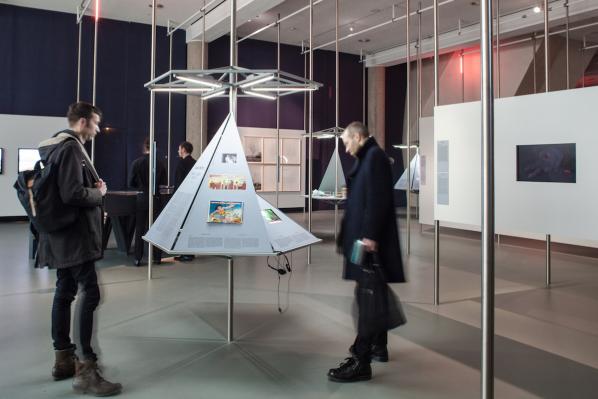
Triangulation is the method to determine the location of a point in space by measuring the angles from two other points instead of directly measuring the distance. As a method it goes back to antiquity. In the exhibition the Triangulation stations give a theoretical and cultural background to the notion of a quantified understanding of the world. Here the exhibition give a rich historical background mixing stories about the UK mass observation project where volunteers made detailed notes about the dancing hall etiquette with analyses of mapping histories and work optimization.
The triangulations in the exhibiton are written by eminent scholars, activists and philosophers. The legal researcher Laurence Liang writes about the re-emerging forensic techniques like polygraphs and brain mappings that have their roots in the positivism of the nineteenth century. Other triangulations are about Smart Design (Orit Halpern), algorithms, patterns and anomalies (Matteo Pasquinelli) and quantification and the social question where Avery F. Gordon together with curator Anselm Franke speaks about the connection of governance, industrial capitalism and quantification.
“Today’s agitated state apparatuses and overreaching institutions act according to the fantasy that given sufficient information, threats, disasters, and disruptions can be predicted and controlled; economies can be managed; and profit margins can be elevated,” the curators say in their statement. We see this believe everywhere – the state, the financial sector, in the drive towards self-optimization. A lot of the underlying assumptions can be traced back to the 19th century – the believe that if we have enough information we can control everything.
Like Pierre Laplace and his demon we believe that if we know more we can determine more. The problem is that knowing is only possible through a specific lens and context so that we become caught up in a feedback loop that only confirms what we already know to begin of. Most notably this can be seen in the concept of predictive policing which is also present in the triangulation part of the exhibition. Algorithms only catch patterns that are pre-determined by the people who program them.
Going through The Grid of the art works (the exhibition architecture by Kris Kimpe masterfully manifests a rectangular gridlike structure in the exhibition space) and reading the Triangulation stations the visitor is left a bit bereft. Is there still hope? One feels like at the end of George Orwell’s 1984 – the main character is broken and Big Brother’s reign unchallenged. This is where the White Room comes in. Here the visitors can be active. The Tactical Technology Collective provides a workshop programme where one can learn about how to secure one’s digital devices, how to avoid being tracked – on the web or by smartphone, what the alternatives are to corporate data collectors like Facebook or Google.
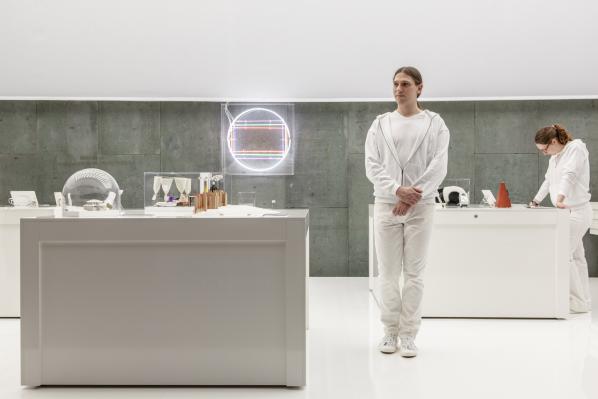
In the end the nature of internet is twofold and conflicting: on the one hand it allows for unprecedented observation and monitoring, on the other it is a tool for resistance connecting people who were separated by space and time. It is not yet clear if this is enough or if (like the radio and other technological media before) it will be co-opted by the one’s in power.
This leads me to one problem of an otherwise very necessary and inspiring show: For all its social justice impetus that narrative that is presented here is very androcentric – there are few if any feminist, queer or post-colonial perspectives in the exhibition. If they are presented then from the outside. This is not a theoretical objection as women, people of colour and other minorities (who are actually majorities) are especially vulnerable to the kind of hegemonic enclosures on the basis of data and algorithms. In a talk in the supporting programme the feminist philosopher Ewa Majewska gave some pointers towards a feminist critique of quantification: the policing of women’s reproductive abilities, affective labour or privacy as a political tool. More of this in the exhibition itself would have gone a long way.
The exhibition is accompanied by an interesting and ambitious lecture programme. The finissage day, May 8, is bound to be especially interesting. Franco Berardi, Laboria Cuboniks, Evgeny Morozov, Ana Teixeira Pinto and Seb Franklin are invited to think further about digitial life, autonomy, governance and algorithms.
Nervous Systems. Quantified Life and the Social Question
March 11 – May 9, 2016
Haus der Kulturen der Welt Berlin
Opening hours and information about the lecture programme on the website.
Featured Image: Smoke Signals at the International Anthony Burgess Foundation, Manchester
Red floodlights illuminate the silhouette of a grand piano standing in the centre of a darkened room. As musician and composer Jonathan Hering begins to strike the keys of the late Anthony Burgess’ piano, a hidden bank of machines cough a sequence of smoke rings into the air, which catch in the red light above. The room fills with a ghostly red mist, all but obscuring the source of the beautiful music. The irregular pattern of smoke puffs suggest it’s some sort of message or code. In fact, it’s a sequence based on email data from seven arts organisations, put through a Polybius cipher.
Smoke Signals places digital communication in context, as simply the latest in a line of our approaches to long-distance forms of communication,” explains co-creator Ed Carter. “I was very interested in the way that as the smoke, or ‘data’, filled the room it became more and more dense. At the beginning, you can decipher it if you understood the code, but eventually it becomes more of a fog – which is a nice analogy for the way data works on a big scale.”
This performance of Smoke Signals at Manchester’s International Anthony Burgess Foundation captures much of what FutureEverything festival is all about: looking simultaneously backward and forward through technology, fusing the analogue and the digital, the theoretical and the artistic, and uniting practitioners across disciplines.
FutureEverything is an innovation lab for digital culture and an annual ideas festival exploring the space where technology, society and culture collide. Featuring thought-provoking panel discussions, original commissions and parties, this year it took place in arts venues across the city, from Wednesday 30th March to Saturday 2nd April.
This summary explores how the festival encourages multi-disciplinary collaboration between different creative communities through interviews with artists who embody this collaborative ethos in a variety of different ways. How do they bridge the divides between disciplines to break new ground and meet the challenges of the future?
Commissioned for FutureEverything, artist Ed Carter created Smoke Signals with engineer and technologist David Cranmer. Musicians Sara Lowes and Jo Dudderidge & Harry Fausing Smith and Hering, then devised original compositions in response to the piece, taking each performance in a new direction. “Working with a collaborator or collaborators is like working with a process or working with a data set,” Ed says. “You create a framework but leave a degree of openness which allows for the unexpected.”


Newcastle’s Occasion Collective chose to deconstruct the collaboration process behind their Babble series of improvised performances at Islington Mill in a lively workshop on the final day of the festival. The collective invited participants to get hands-on with improvised dance and live-sampling in sound and video, to help reveal the feedback loops between artists at the heart of their multilayered performances.

The concept grew from musician Jamie Cook’s final-year music degree performance, where he played with a saxophonist and manipulated her audio live, creating loops, sampling, applying effects and changing speed. “I wanted to use electronics in a very tactile way, so that the audience weren’t shut out between me and the computer screen,” he says. “They could see all of the sounds I was creating, they could see them being taken and then transformed. Over time I added more members from other media, like dancers and visual artists, which grew into this ensemble where everyone improvises live and feeds off each-other’s ideas.”

Each Babble performance refers to a short poem written by Charlie Dearnley, based on stories told by his grandmother, which “all grapple with a point of death or unburdening,” he explains. While performing, sensors on his costume feed to digital artist Sean Cotterill, whose software translates the movement into light and sound. “The idea of digital communities, using digital technologies to gather creative communities around them, is important to me,” Sean explains. Written in the supercollider language, Sean has put all his code for the show online, in the hope of developing further feedback loops beyond the live performance.

While process is an explicit part of Occasion Collective’s performances, each one feels stirring and organic. “It’s an attempt at honest expression which is heightened and realised through collaboration and working with others,” Charlie says, “acknowledging, for myself, the inadequacy of words in genuinely conveying experience; trying to create something that is more engaging.”
Engaging people is the challenge at the heart of Nelly Ben Hayoun’s work, as she explained after her talk at the Intelligence panel. The so-called ‘Willy Wonka of design’, Nelly is a one-woman nexus of collaboration who creates experiences to generate social action around science and technology, often space exploration. She assembled the International Space Orchestra, the world’s first orchestra composed of space scientists from NASA’s Ames Research Center and the SETI Institute (Search for Extraterrestrial Life). Featuring original music by Beck, Damon Albarn, The Prodigy, Penguin Cafe, Two time Grammy award winner Evan Price and Bobby Womack, she convinced scientists and astronauts to participate in an ambitious musical retelling of the Apollo 11 moon landing in 1969.
Video embed: The International Space Orchestra_ Official IFFR selection 2013 (https://vimeo.com/57863847)
“There are audiences that are not keen to be transported or play any part, but it’s my role to then force them into it,” she explains. “Most of the public is becoming quite lethargic, so it’s really difficult to get them to move. My way of doing things is what I call total bombardment: getting to people through the fields of music, design, arts, theatre, tech, digital and architecture. Even though you might not want to be engaged with the issues or the questions I’m raising, you will find yourself confronted, in any case.”
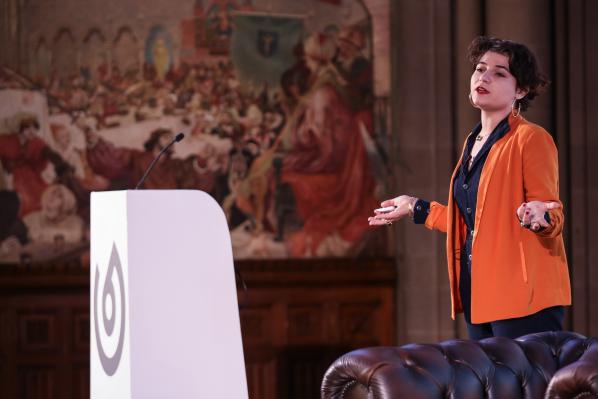
Nelly studied at the Royal College of Art under Anthony Dunne and Fiona Raby, who inspired her problem-finding rather than problem-solving approach to design, particularly with regard to future challenges and the potential impact of evolving technology. Her most recent project, Disaster Playground, investigates the planet’s emergency procedures through attempts to stage a simulation of an asteroid strike. Soberingly, Nelly finds that only about 20 ageing scientists are charged with planning for disasters such as asteroid collisions and meteor showers.
Video embed: Disaster Playground Teaser (https://vimeo.com/107466074)
“I’m applying critical thinking and critical design, but also looking at a range of artistic fields to see how we can merge all of these different disciplines to aim for social action,” Nelly says. “I apply Antonin Artaud’s theory of the Theatre of Cruelty to the way I engage members of the public with scientific research, looking for much more extreme and visceral ways to engage them, which you open up through collaboration. Whenever I work with scientific partners or sociologists or philosophers, I pick the ones who will fight with me. I believe that conflict generates innovation.”
The Turner Prize-winning Assemble collective prefers a more harmonious atmosphere. Comprised of 18 members, Assemble’s collaborative approach to architecture and urban development puts local people at the heart of development, implementation and ultimately the long-term life of each project. They also work on sustainable principles, choosing where possible to work with pre-existing local materials, reusing or repurposing them to better serve the area’s needs.
Assemble’s Mat Leung posed new ways to think about communities in a thought-provoking panel discussion with science fiction writer and futurist Madeline Ashby and new communication technologies expert Sarah Kember at FutureEverything’s Community panel. “[Sarah, Madeline and Assemble] understand community not as a monolithic term,” Mat explains. “Obviously there are loads of different elements to it. The term community is difficult because it assumes a single kind of identity, but together we wanted to interrogate that.”
Multiple communities can exist simultaneously and overlap in a given area, such as a community of residents, who Assemble empowered through the Turner Prize-winning Granby Workshop project, creating jobs through rebuilding a neglected area of Liverpool from the grassroots up; or a community of makers and artists, with whom they worked on the Blackhorse Workshop project in East London.


The Community panel developed a theme that ran through the festival: that no one individual or group is capable of meeting the challenges of the future alone. Finding ways to positively engage multiple stakeholders with a variety of knowledge and skills is vital to finding solutions that meet the needs of the wider community.
“Our successful collaborations come from an understanding that there’s a diversity of stakeholders, skills and knowledge,” Mat says. “We’re interested in a broad range of things, but we acknowledge we’re not amazing at everything. Each different member of Assemble has their own training and expertise, but when we work with a community, people who’ve been there for 15 years know more than we do – they’re experts in a different way. They might not know about which materials to use for a given job, but they can tell you the effect of a layout or the practical implications of what you’re doing. You have to acknowledge that people are experts in different fields”.
Projecting a vision into the future can be one of the hardest challenges for architects – but Assemble have developed what appears to be a powerful and effective way of ensuring the longevity of projects. “When you say ‘Let’s talk about the near future’, architects get hysterical, designers go into meltdown,” Mat explains. “As soon as you say community, legacy, or things like that, it brings up a set of expectations. But what you’re really saying is that you want your idea to be taken on and exist beyond the period you’re directly involved in its life. So we’ve found that collaborating with the community throughout the process, through workshops for example, is a great way to encourage people to continue using spaces after we’ve moved on.”
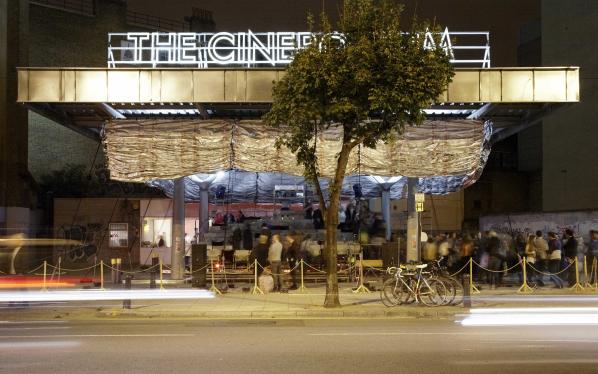
The enthusiastic spirit of collaboration fostered by FutureEverything transcended each event and sparked conversations between practitioners from a variety of different fields, who gave each other new perspectives through which to consider their own work. Drawing on the participatory ethos of progressive digital communities, the festival encouraged a refreshingly open atmosphere. But how to keep this energy going once the festival comes to an end? Many of the artists involved shared their processes in the hope that others can build on their achievements. The vibrant creative melting pot FutureEverything presided over will ensure that the new connections created will lead to even more inspiring projects in the years to come, from networks that extend far beyond Manchester.
Find out more about FutureEverything.
Featured Image: Stock photography from Google Image search “happy creative tech startup”
Neoliberal Lulz: Constant Dullaart, Femke Herregraven, Émilie Brought & Maxime Marion, and Jennifer Lyn Morone.
Showed at the Carroll/Fletcher Gallery 12 February – 2 April 2016.
Neoliberal Lulz asserts to have born witness, arm-in-arm with rest of us, to an unprecedented shift in the volatility and increasing speculative power of financial markets and the dissolution of value indexing to physical commodities. This relationship has been made particularly palpable in the realization that investment banks and corporations hold a tremendous sway (perhaps even tremendous to an unknowable degree) over our lives. The four artist/groups brought together make work as a way of trying to bring this dynamic into knowing.
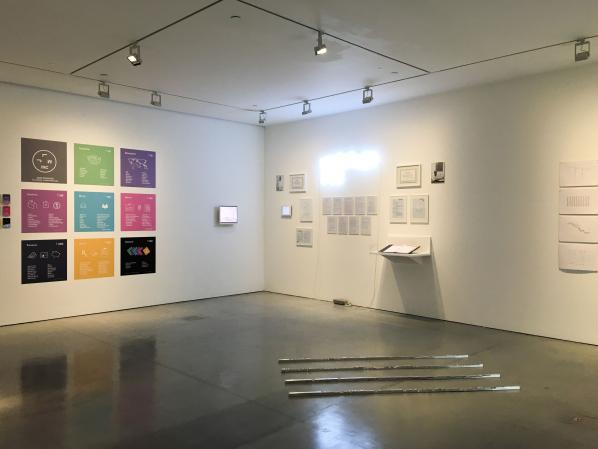
Neoliberal Lulz is not so much about this relationship, or the realization of this relationship, between market forces and lived experience. It’s more accurate to say that the exhibition and the artworks contained within it rather serve as a populist blueprint for how individuals can talk to the market. If political economies speak in the limited language of supply and demand, then how can we make ourselves heard?
New media is a particularly good way of addressing this question because of the way hardware and software must constantly negotiate the terms of inter-communication. The success of media is dependent on this trafficking in translations, between file formats, online and IRL, technical apparatuses, outdated and current softwares. So when artists like Constant Dullaart, Femke Herregraven, Émilie Brought & Maxime Marion, and Jennifer Lyn Morone make themselves “corporate,” mimicking the neoliberal virus, this move feels right at home with the kinds of techno-alchemist work being displayed.

Femke Herregraven makes the mystifying lifespan of high frequency trading material, which feels a lot like spinning straw into gold (or perhaps the other way around). Her works rehearse this slippery, ambivalent relationship between value and objects, indexes and standards. In this way Herregraven’s works ground the exhibition in a similar way as does Constant Dullaart’s Most likely involved in sales of intrusive privacy breaching software and hardware solutions to oppressive governments during so called Arab Spring: by memorliaizing in cold, clunky materiality the “immaterial” processes that are active under the banner of neoliberalism everyday. Three of the four artists on display have incorporated—Jennifer Lyn Morone™ Inc, Untitled SAS (that’s Émilie Brought & Maxime Marion), and DullTech™ (Constant Dullaart). Between these companies the process of how to become a company is cracked open, revealing how sophomorically simple and complicated the process is, how much paper detritus and nondescript stuff is secreted as byproduct. Constant Dullaart here adds a lesson on the aesthetics of startups with an entire room dedicated to the oddly-familiar B-roll shots of airplanes cut with inspirational platitudes. Jennifer Lyn Morone adopts the the aesthetics of a kind of good life marketing that is gender-targeted, and operates by corroding away what’s already there (mental health, well-being) to make its own market gap.
But I tell you this: the best part of the exhibition isn’t on display. Ask the front desk about buying shares of either Untitled SAS or Jennifer Lyn Morone™ Inc. This is the heart of the exhibition, and it’s either lamentably sidelined or a brilliantly premeditated that just inquiring about the purchase can reveal so many gaps and uncertainties.

When I visited the exhibition, gallery attendants very kindly filled me in on the bold point details of buying shares, to the best of their ability. They explained that Unititled SAS shares sold for €30.00, with a €25.00 admin fee that went straight to Émilie and Maxime. It is not split with the gallery, as often the the sales of an art object are. Was the gallery entitled to any part of the sale of shares of Untitled SAS? Sort of: fifty-percent went to the French government, twenty-five percent went to Émilie and Maxime, and half of the remaining twenty-five percent went to the gallery. Did a new contract have to be drawn up to negotiate the profit negotiations between the gallery and artists who had incorporated some capacity? No, the normal consignment contracts were used (they did not share what the terms of these contracts are; I did not inquire).
What about shares of Jennifer Lyn Morone™ Inc.— how much did they cost? This was a decidedly trickier question, with nationality and class-based restrictions and allowances. The general gist was that since Jennifer Lyn Morone™ Inc. is registered in the U.S.A., that American citizens are subject to tax; English citizens are not. For English citizens there are also different price points and clauses for lower-income prospective investors. This does not apply to U.S. citizens, who are required to prove salary requirements before purchase can be approved.
Had anyone bought any shares yet, for either company? No.
Eventually, the attendants printed me a Jennifer Lyn Morone™ Inc. Instructions for Prospective Investors document: four-pages single-sided, unceremoniously stapled together. For those unfamiliar with this kind of legalese, it’s a bizarre artifact from another planet. Everyone should ask for a copy.
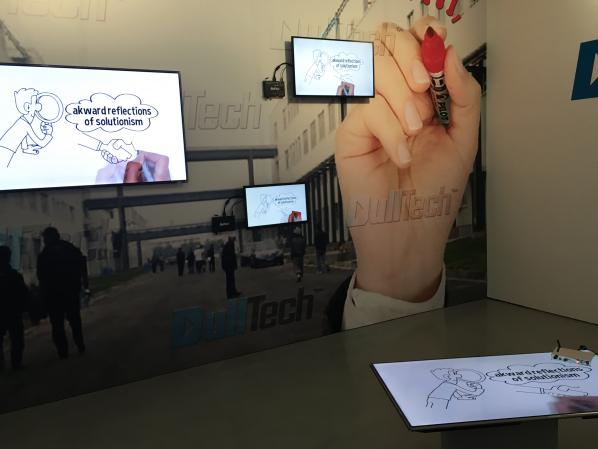
The title Neoliberal Lulz might tip its hat to the tradition of online trolls and their persistent, agnostic vitriol, but the exhibition itself feels like it sets out some very real stakes. This is a good thing, because an exhibition interrogating the asymmetrical relations of production and profit taking place at a prominent art gallery in Fitrovia (a borough in itself that is paradigmatic of these inequities) could have really been smug, smarmy, shit. The hypocrisy of an exhibition that singularly railed against the unmitigated growth of big business while standing amongst its spoils would be too much. But Neoliberal Lulz is not this: it is far more nuanced in its message, far more unclear on its value judgments. As an art exhibition Neoliberal Lulz did well to espouse the artist-as-researcher model. It helps make sure that the exhibition has legs outside of the exhibition space. The fact that most of these artworks have a life outside of the domain of art, circulating within the very thing they’re critiquing, legitimates their output. The other thing that Neoliberal Lulz does well is not to dwell on the narrative of the disenfranchised. I don’t say this because it’s not important but rather because it just simply wouldn’t read.
Neoliberal Lulz feels like a prompt that comes at a timely moment, slotting in to conversations like this, this, and this. It criticizes at the same time as it offers options, which seems like a rare combination these days. “What is to become of the future for young artists?”–the people wail, lamenting that much of the young, creative elite inevitably ends up siphoned off into the tech startup culture. Neoliberal Lulz seems to say this doesn’t have to be a bad thing, and I’m inclined to agree. All’s not lost when artists adopt an if you can’t beat ‘em, join ‘em ethos, particularly when they do so with a critical bent. Deeply sardonic and ruthlessly interrogative, Neoliberal Lulz is a successful venture into addressing the malleability of contemporary political economies to more progressive ends.

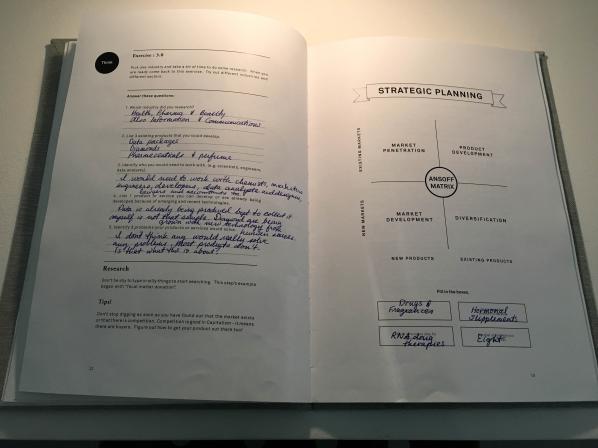
Carroll/Fletcher Gallery
56-57 Eastcastle St.
London W1W 8EQ
Despite its image of rapid technological change, progress under capitalism has stalled. Spinning ever faster is not the same as going somewhere. Contemporary Accelerationism wants to take off the brakes, and it is enlisting art’s help to do so.
Taking its name (like every good movement) from one of its critics – Benjamin Noys claims credit for naming the historical tendency in 2008 – contemporary Accelerationism has both a philosophical and a political form with the latter only weakly related to the former. What Epistemic (philosophical) and Left (political) Accelerationism have in common is an attitude of “prometheanism”, of amplifying our capabilities, of rationally overcoming intellectual and material limits. Of hacking the systems of philosophical and political thought to find the exploits that will allow us to increase our knowledge of them, our control of them, our reach through them. Hopefully this will work out better than it did for the original Prometheus of Greek myth (or for Ridley Scott).
Contemporary Accelerationism may seem heretical compared to the “folk politics” and philosophy that it contrasts itself with but it is not (however some people may start essays) the capital-intensifying Accelerationism of 1970s continental philosophy or its killer-robot-welcoming successor in 1990s cyberculture. From the point of view of the former it is too immediately critical of capitalism and from the point of view of the latter it is an off-ramp on the road to the singularity. It is also not the pure speed of Paul Virilio’s dromology, or the experience of lack of time of the overworked neoliberal subject.
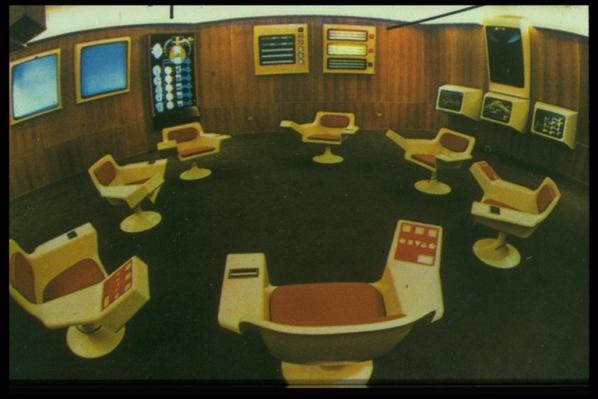
Accelerationism is a progressive attitude towards the liberation of reason and production – and therefore selectively technology – rather than the fetishisation of them. The “real” accelerationists in these senses aren’t working at Google, although they might in time exploit technology developed there. Chile’s early 1970s Cybersyn project provides an informative precedent. It sought to accelerate transition to a socialist economy using limited and almost obsolete mainframe and teleprinter technology. Its Accelerationism lay in the attempt to rationally analyse and spur growth in industry to increase the rate at which it developed, not in technofetishism.
Philosophical Accelerationism is “Epistemic Accelerationism”, represented in the writing of Ray Brassier, Reza Negarestani, Peter Wolfendale and others. This is a neo-rationalist philosophy, a programme of “maximizing rational capacity” and the ability to reason about or navigate our knowledge of the world. This is a self-revising, non-monotonic, socially situated reason very different from the logicism of 20th century rationalism and its detractors (although logics have advanced considerably as well).
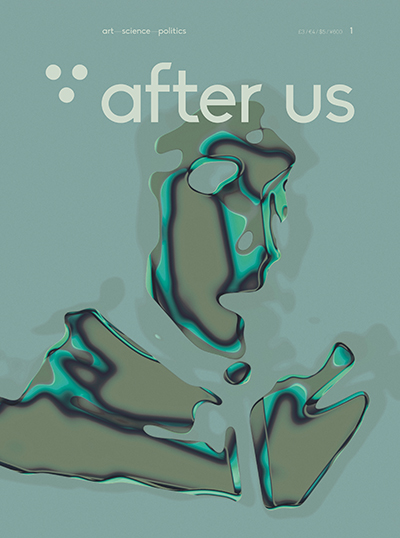
Two new journals are taking an Epistemic Accelerationist approach to art and culture. In the UK, “After Us” shares a designer with former CCRU member Kode9‘s Hyperdub record label. In France, “Glass Bead” takes its name from Herman Hesse’s imaginary game of knowledge described in his novel of the same name. Both are haunted by the legacy of C. P. Snow’s 1950s “Two Cultures” of science and the humanities, with “After Us” explicitly invoking the need to reconcile them. This isn’t the first time such a move has been called for, and previous attempts make clear that scientists tend to make as bad artists as artists make scientists. The contemporary artworld is also not under-populated by transversal and interdisciplinary research and its aesthetics. Regardless, both provide thought-provoking cultural insights and resources. And the first issue of Glass Bead features, among other articles and interviews, Colombean mathematician Fernando Zalamea, whose accessible promotion of contemporary mathematics and production of a synthetic philosophy based on it deserves much wider attention.
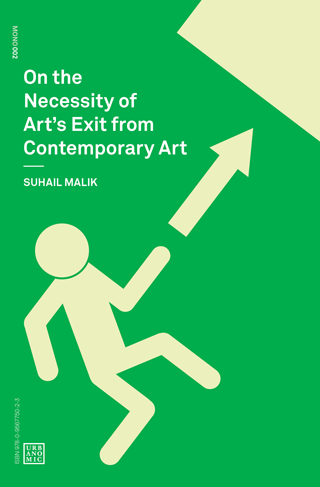
Escaping the radial velocity of asset-class zombie formalism is the focus of Suhail Malik’s “On the Necessity of Art’s Exit from Contemporary Art” (I’ll be reviewing the book for Furtherfield). Malik describes Contemporary Art’s self-image of escape (from society and art’s own limitations into a space of freedom) that disguises an inescapable and complicit recuperation of novelty. To move beyond this he proposes a strategy of exit (which contrasts interestingly with designer Benedict Singleton’s discussion of traps). This is not a seasteading-style fantasy of libertarian secession, rather it is an attempt to identify the next move in the game of art after a long impasse and to return art to a more grounded and constructive role in society.

A group centred around The New Centre For Research (whose events and video archives I cannot recommend highly enough) are seeking to apply neo-rationalism to art in order to effect just such an escape from the outsideless beige singularity of Contemporary Art. This would be an art intentionally constructed to make the rules of contemporary art and of its own construction explicit, allowing artists to reason about this and to thereby come to understand how to escape the seemingly irresistible aesthetic and political cage of contemporary art. Amanda Beech‘s “Final Machine” (2013) prefigures this kind of analysis of the structure of images and their situatedness in the networks of power that produce contemporary art. Diann Bauer‘s collaboration on the art and finance R&D project “Real Flow” is another good example. Bauer has also produced videos for Laboria Cuboniks (see below) and for accelerationism-related events. Beech, Bauer and others have held a series of discussion panels on the subject of “Art and Reason” (one) (two).
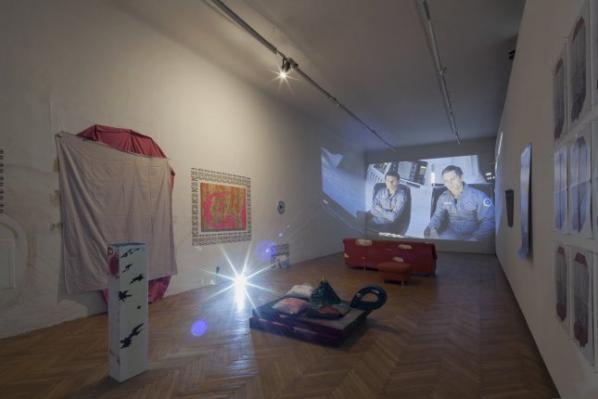
Curator and critic Mohammad Salemy has curated a series of art shows with Epistemic Accelerationist themes – “Encyclonospace Iranica” in Vancouver, “For Machine Use Only” in Vienna, and most recently “Artificial Cinema” in Prague. Each of these has created an artistic critical context for networked systems of perception and knowledge, engaging with the political possibility of their being repurposed to more emancipatory ends in the future.
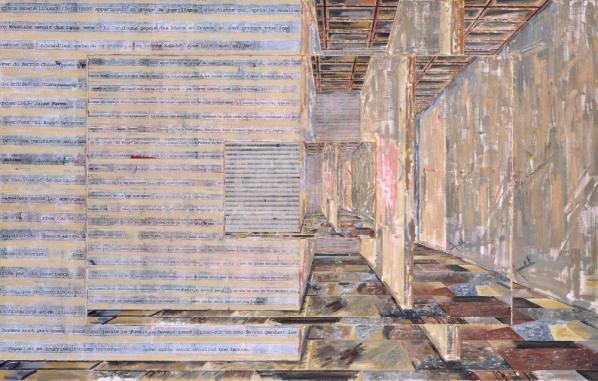
A self-aware, critical, politically committed art aware of its institutional context that is nonetheless still recognisable as art may sound like a stretch but there are precedents in the work of veteran conceptual art collective Art & Language, most obviously in their early “Index” installations and in their later “Incident In The Museum” paintings. There is another way in which Art & Language provide a precedent for the New Centre group – a decade ago they theorised genre as a means of interrupting the frictionless misrepresentations of Contemporary Art, similarly to Malik’s (and, as we shall see, Beech’s) emphasis on recategorisation.
Contemporary political Accelerationism is “Left Accelerationism”, exemplified by the writing of Nick Srnicek and Alex Williams. Initiated by the “Manifesto For An Accelerationist Politics” and fleshed out in the book “Inventing The Future“, Left Accelerationism claims that some of the technologies created by capitalism can be repurposed and even intensified to enable an achievable socialist future and unleash the creative forces in society that they currently repress. As Srnicek and Williams make clear in “Inventing The Future”, this is not in opposition to other struggles but rather a means of materially supporting them.
As a group that often struggles with basic material support, the Left Accelerationist project can hold some appeal for artists. Universal Basic Income (pursued as Srnicek and Williams propose – within rather than as a reason to dismantle the rest of the Welfare State) for example would benefit artists (and musicians, actors and other creatives) in much the same way as earlier welfare state provisions. Artists can support this, rather than having to make the specific moral case for artworld subsidies, as an effective means of solidarity.

Full automation, another of Srnicek and Williams’ proposals, is the theme of the show at Kunsthalle Wien. The diverse work included drives home that art and curation needn’t be propagandistic, uncritical or overly serious to promote or engage with Accelerationist themes.
In their essay in the book “Speculative Aesthetics” (2014), Nick Srnicek proposes an Accelerationist aesthetics of transforming a “data sublime” into forms comprehendible by human beings, an aesthetic of user interface-style efficiency and transparency rather than beauty. The example Snicek gives is of transforming a complex economic model into a tool for the manipulation of economies. In the same volume, Amanda Beech (again) argues that rather than “asking what images mean, or if it is possible to mean what we say” we should produce an art that leaves behind the category of the uncategorisable in order to unravel the political project that contemporary art is subject to.
Likewise Alex Williams’ consideration of Accelerationist aesthetics in the article “Escape Velocities” (2013) emphasises aesthetics as a means of presentation of conceptual spaces, rendering them tractable to the human imagination, as well as explicitly discussing interface aesthetics with reference to Cybersyn. They also mention the concept of Hyperstition, which we will return to below.

Laboria Cuboniks are a pseudonymous collective who have produced the “Xenofeminism” accelerated feminist manifesto. It’s a strikingly designed production (the website was designed by artist Patricia Reed) that is already inspiring artistic production. The “3rdspace” show describes itself as “a response to XF and an exploration into the potentials of technology to escape modern structures of control”, building on Promethean themes.
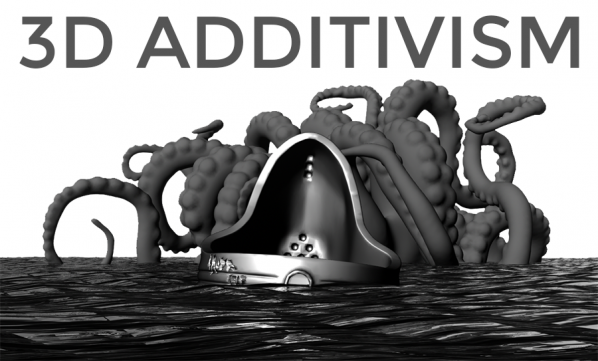
Morehshin Allahyari & Daniel Rourke have produced the Additivist Manifesto for art in the Anthropocene (the video for it features the “Urinal” 3D printable model I commissioned from Chris Webber). They “…call for you to accelerate the 3D printer and other technologies to their absolute limits and beyond into the realm of the speculative, the provocative and the weird”. This is the kind of acceleration through (and into) art that works as both epistemic and left accelerationism without merely illustrating the program of or being instrumentalised by either. It is accelerated critical theory.

And beyond the visual arts, musician Holly Herndon’s most recent album was described by collaborator Mat Dryhurst as being designed to support Left Accelerationism.
While contemporary accelerationism is at pains to signal how far removed it is from CCRU-era Nick Land (let alone their contemporary work), the CCRU’s instrumentalised mythological theory-fiction has resources that are of interest. The slippery concept of “hyperstition”, essentially self-creating science fictional or mythical entities, is key. Cyberspace is hyperstitional, as was the writing of H. P. Lovecraft, as was Neoliberalism, and the music of Hyperdub. They are all unreal entities that bootstrapped themselves into reality via the human imagination. Hyperstition is an example of rational irrationality, or at least rationalised irrationality.
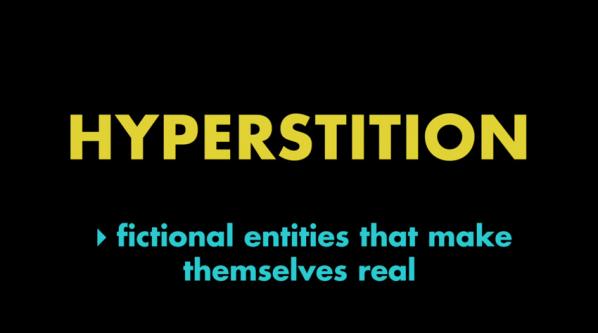
Seeking to harness hyperstition for a moral or political programme has something of the air of trying to summon Cthulhu for social justice, or to turn Skynet into a phone tree, but Williams’ “Escape Velocity” mention of Hyperstition as a means of creating visions of a better future as something that will have been possible is compelling. Hyperstition should be more (mis-)used in art than it currently is, and its creation all but demands activity outside the existing artworld.

International art collective (and CCRU collaborators) Orphan Drift‘s autopoietic mythologies realised in glitch art videos, installations and writing provide a historical point of reference here.
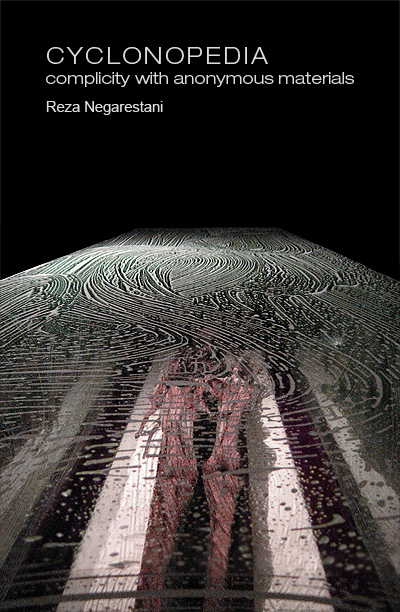
The earlier work of Reza Negarestani serves as a bridge between the CCRU era and the present. His novel of theory-fiction “Cyclonopedia“, 2008, evokes hyperstitional entities from the layers of trauma present in the politics and geology of oil and the Middle East.
In art, reason and rationality may inspire memories of dry conceptualism or stern Soviet abstraction but contemporary art’s hidden and totalising rules are no less binding and are in desperate need of exposure and critique. The task of uncovering and overcoming them presents a challenge to perception and representation that meeting will amount to much more than “art about art”. Perhaps we can use Deep Learning and neural nets to pull the ghosts of genre and medium specificity out of contemporary art then intensify them rather than make puppyslug kitsch… but that’s another story.
Left Accelerationism’s design tasks and the hyperstitional making of its future seems to have always been possible to provide more challenging alternative projects to the manufacturing of yet more zombie formalism, and as “The Promise Of Total Automation” demonstrates this needn’t take the form of uncritical propaganda.
In contrast to these approaches, I feel it’s worth asking what a direct equivalent to Left Accelerationism for Contemporary Art would look like. Which aspects of the contemporary artworld would be worth intensifying, appropriating and pushing further to create an alternative? And what would the vanishing point for such an art be in order to avoid recuperation into the generic space of Contemporary Art?
Accelerationist art is working out how to climb over the event horizon of contemporary art, helping to make a better future seem possible, analysing and transforming technocapital, and ironically intensifying the trajectories of new technology to critical excess. As the logic of neoliberalism colonizes personal space, time and identity, suggesting that we need to move faster in any way may seem perverse or complicit. Accelerationist art is part of a project to grab the wheel rather than slam on the brakes and to thereby move beyond the exhausted constraints and artistic apologetics of the logic that is eating the world.
(Updated 2016-05-18 to include more examples.)
Accelerationist Art by Rhea Myers is licensed under a Creative Commons Attribution-ShareAlike 4.0 International License.
The global financial dictatorship presents us with a paradox: while the economic transactions capable of shifting the destinies of entire countries are the result of performative language, it is language itself that, in turn, is transformed and subjected by the flows of financial markets. Such a paradox may be understood as a negative feedback loop: a relational process in which one of the actors of the relationship is amplified and expanded (the economy) while the other is weakened and submitted (language). The effects of this paradoxical feedback loop on politics are evident and clear: the linguistic exchange which feeds the public sphere, and therefore the possibility of thinking about the democratic organization of society, diminishes and becomes neutralized because of its submission to the market, up to the point of canceling politics itself. Politics, considered as a space where daily life becomes realized, is reduced to an engine which merely executes the algorithms of finance. In this reconfigured field, the common good becomes increasingly unimaginable as individuals are transformed into cellular automata: inside their bodies, the code of economic behavior and the flat, mutilated language that capitalism requires to operate frictionlessly are already inscribed.
Whoever refuses to enter life as a mere cellular automaton will be annihilated by the financial dictatorship, which is currently passing through an extremely murderous stage: necrocapitalism. Achille Mbembe claimed that the ultimate expression of sovereignty lies broadly in the power and the capacity of deciding who may live and who must die. This was known as necropolitics. Today, the dictatorship of finance prescribes a progressive and quick reduction of the sphere of politics, with the aim of canceling the restrictions that laws and codes used to impose on the flow of capital. And governments have indeed shrunk, turning thus into little more than facilitators of the unstoppable progress of capitalism. However, they have not stopped to exercise their operational capacity to kill and let live. True power has been transferred directly into the hands of capital, who now determines which lives should be halted and which should continue. The power of capital has increasingly turned into a murderous one that, nevertheless, is still executed by the officers of the old sphere of politics.
Mexico passed from necropolitics to necrocapitalism not by force but by the signatures of the presidents and ministers of finance of Mexico, the United States of America and Canada who, in 1992, signed the North America Free Trade Agreement (NAFTA). What has happened in Mexico since then? A chaotic chain of privatizations, looting and crime, all of which have been executed with a hitherto unknown intensity thanks to the almost complete destruction of the former sphere of politics.

After the forced disappearance of the 43 students of Ayotzinapa, Elisa Godínez wrote that “it is not surprising that the corporate sector is heading the demands to repress all social protests which directly affect their properties and interests, arguing that the rule of law should be respected.” [1] It is true that, in the post-NAFTA era, such a position comes as no surprise. However, the true novelty lies in the fact that now the Mexican State no longer defends only the interests of national corporations, but also those of multinationals. And this is not a minor novelty: all sorts of extraction industries, for example, have multiplied their concessions and profits thanks to such a defensive stance. And they have done so while devastating lands, ecosystems and people with almost complete impunity. According to data collected by the Red Mexicana de Afectados por la Minería (Mexican Network of Persons Affected by Mining), 450 tons of gold have been extracted from Mexico, a quantity almost three times larger than the 185 tons extracted during Spain’s colonial domination. This unprecedented looting has particularly benefited Canadian and North American companies, who make up almost 85% of all private mining concessions, while paying back a mere 1% of what they extract to the Mexican government [2].
Article 27 of the Mexican Constitution deals with the property of land, water and natural resources. It originally established that “the property of lands and water resources inside the limits of the national territory corresponds to the Nation.” Obviously, this vision had to change radically under necrocapitalism since, instead of recognizing the primordial nature of private property and the right of capitalists to posses it, it indicated that “the Nation” was, in principle, the sole owner. Now, thanks to recent reforms to Article 27, “the Nation” has acquired the right to transfer the dominion over lands and territorial waters (and, consequently, over the humans and non-humans who inhabit them) into private hands. Article 27 is today the red carpet extended by the Mexican State to welcome the financial and linguistic flows and algorithms of necrocapitalism in grand fashion.
The piece “El 27 | The 27th” is an example of what algorithmic politics can be. Far from trying to point to a possible escape from the horror and exploitation of necrocapitalism, algorithmic politics deepens its murderous potential instead. Despite its relative usefulness as a hired murderer, the traditional sphere of politics is terminally ill: it is too old to carry out rapidly and efficiently the demanding tasks of necropolitics. So, once exhaustion has completely died out its powers, politics made by humans will have to be substituted by algorithmic politics, that is: politics made by machines.
In this piece, an algorithm operates directly on the text of Article 27 in the following way: every night, after the activity at the New York Stock exchange has come to an end, a robot obtains its last closing price and its respective percent variation. If the variation is positive, another robot chooses a fragment of Article 27 randomly, translates it into English automatically, and inserts the translation into its corresponding place within the original text written in Spanish. Given enough time, the algorithm will produce a version of Article 27 fully readable in an effective – yet incorrect – English. An automated English that will already have attempted to displace humans brutally, even though they might still be fighting for a territory delimited by language only, and refusing to die. An automated English that will have already eroded a land delimited by language only, rendering it unrecognizable: torn, exploited, almost dead.
“El 27 | The 27th”: http://motorhueso.net/27
“[A] hundred reasons present themselves, each drowning the voice of the others.” (Wittgenstein, Philosophical Investigations: supra note 11 § 478).
For Part 1 click HERE.
For Part 2 click HERE.
Voice and unintelligibility play a greater, complex role in reasoning than the Left or Right accelerationists are prepared to admit, or fail to see. Establishing ones political voice is far broader and extensive than any of these thinkers take it to be, and is not simply the by-product of a phenomenological given unable to envisage any political alternative. Voice has to take priority here, for how else does one actually communicate? By this, we don’t have to take Voice to be the literal act of saying something out loud, or examining the behaviour for doing so. It can interpreted both as a metaphor and means encompassing every political act to which it can be applied; having a voice, or an opinion, hearing the public representation of someone, or of a community, wanting to being heard, letting someone have a say in the matter, etc. Above all it takes on the force of voicing ones own condition.
Might every form of modern communication then, be it a WhatsApp message, a bored glance at a meeting, cynical internet comments to nondescript mumbling, be one of ordinarily voicing our own condition? Perhaps even more so when it is mediated by an infrastructure (sometimes especially so). Both Voice and infrastructure are components of communicating indirectly, as most language games tend to do, whether face to face, face to mirror or interface.
The problem with philosophy is that the ordinary gets blamed, largely as the historical list of philosophy’s complaints almost always aim for the ordinary first as if its triviality is, by itself, not to be trusted with political or rational action. Indeed the very task of calling the ordinary to our attention, takes into account that we have lost interest in it. Perhaps it was already assumed that the market silently reduces the depth of ordinary communication and circumstance to capitalist knowledge anyway. Or maybe since ordinary life is increasingly and consistently mediated through online platforms, technology has overtaken its significance.
Yet what Ordinaryism seeks to uncover is that Voice does not constrain freedom because of its vulnerability: it is only because of vulnerability that voice expresses the freedom to reason in the first place. This is the split that severs both the sovereign rationality of Accelerationism (and Sellars), and the non-sovereign self of Ordinaryism (and Cavell). Indeed, this appears to be Cavell’s political lesson: it seems rational to want build a platform for others to air their democratic voice and decry any ineffective basis in favour something more determinate, more grounded, more inhuman. Yet freedom and justice only begins if a community is capable of ‘finding’ their own voice in the face of injustice. Likewise freedom is constrained if other voices repudiate the voice of others. There is no cognitive purchase for this, and no pre-built, implicit, or explicit ground for determining intelligibility either. So we have to ask, how else can the inhuman make itself intelligible unless it gives voice to its own condition? (As an aside, what else is philosophy but a set of specific and singular voices crying out for recognition in their appeal? A voice that may be acknowledged, yet equally repudiated? Just as the sound and look of Voice matter in reasoning, [how it persuades, how it strikes you] so too does the sound and look matter to philosophising arguments and deductions.)

The easiest way to round these political concerns up is to show how the very need to bypass the vulnerability of Voice, the need to provide an ‘answer’ or ‘solution’ to that vulnerability, is the same philosophical question that concerns solving skepticism. This is the heart of Cavell’s philosophy.
Following Naomi Scheman, the heart of transcendental inhumanism to which the epistemic accelerationists follow aims to draw attention to what underlies the possibility of our ordinary lives. But in Ordinaryism, the Cavellian rejoinder must insist that “the ordinariness of our lives cannot be taken for granted; skepticism looms as the modus tollens of the transcendentalist’s modus ponens.” (Scheman, “A Storied World”, In Stanley Cavell and Literary Studies, 2011 p.99). Whereas Accelerationism posits a renewed set of tools to re-determine intelligibility in an era of supposed ‘full automation’, Ordinaryism speaks to these same conditions but where intelligibility routinely breaks down, is endlessly brittle, always delicate, sometimes connects, but is never ensured or determined by philosophical explanation alone. What might it mean to understand the fragmented world of machines as a uniquely literary responsibility?
In other words, a future world of increased automation needs a romantic alternative. And it is sorely needed, because in this future order where automation is assumed to outpace human knowledge, or supersede it in any case (amplifying existing industries, or creating new ones) Ordinaryism speaks of new moments of doubt which constitute the skeptical fragments of ordinary life with machines. Perhaps also of machines. It might take on a specific personal form of questioning and living with what these new forms takes on; “what does this foreign mapping of data really know about me”, “what does it know about all of us?”, “Am I just being used here?”, “How can I know whether anyone is spying on me?”, “why are they ignoring me?”, “what on earth does that Tweet mean?”, “what’s happening?”, “what am I supposed to think about this”, “Why would I care about you’re doing?”, “I need to know what they’re doing.”
There are innumerable ordinary circumstances where a life with machines begins to make sense, but also starts to break down in all the same places: how might one suggest that a machine “knows” what it’s doing, or that “it knows” what to do? Where does the scalability of automated systems start to break down, and what sort of skepticism does it engender when it does? What happens when software bugs, and unpredictable acts of mis-texting chagrin habitual pattern? How might such finite points of knowledge exist, so as to understand and inhabit systemic doubt? What are the singular and specific means for how such systems are built, conceived or decided? And most of all, how might we even begin to characterise and acknowledge the voices which emerge within these systems? You might say that Ordinaryism wishes to extract acknowledgement out of the knowledge economy.
What is required then, is both a Cavellian critique of epistemic accelerationism (what potential political dangers might arise if Voice is repudiated) and why its solutions to solve skepticism through collective reasoning and self-mastery are no different from skepticism itself. But to do that, one also has to take account of how Cavell brings an alternate approach to imagining how normative rules are implicit in practice. This is not an act of opposition, more of a therapy, which might be needed, especially as politics is involved.
Now, despite the fact that Cavell’s philosophical questions work (almost) exclusively in the Wittgensteinian domain of articulating and expressing normative concepts which regulate speech and pragmatic action (beginning from his first essays Must We Mean What We Say? and his later magnum opus, The Claim of Reason) these texts don’t appear to be required reading in accelerationist and neo-rationalist circles.
Take the newly released art journal Glass Bead, whose aim is to suggest that any “…claim concerning the efficacy of art – its capacity, beyond either it’s representational function or its affectivity, to make changes in the way we think of the world and act on it – first demands a renewed understanding of reason itself.” If such a change in thinking is motivated by a renewed post-analytic approach to reason in a world of complexity (and an additional capacity for aesthetic efficacy), the continued omission of Cavell’s work into reason and aesthetics, is notable by its complete and utter absence. It’s enough to warrant the claim that certain imaginings of reason – in this case the abstract inferential game of giving and asking for reasons – are to be favoured over other types (usually with a secondary, pragmatist demand that science is the only authentic means for understanding the significance of the everyday).
In fact there’s a good reason for that omission: because Cavell discovered that he wasn’t able to ignore the threat of skepticism entirely, and instead discover it to be a truth of human rationality (is there anything more paradoxical than discovering ‘a truth’ in skepticism?). He instead sought to articulate how such concepts were not inherent features of inhuman ascension by means of inferential connection, but fragmented conditions of differentiated identity. In the eyes of the epistemic accelerationist, it’s as if there isn’t any possible option in-between some half-baked, progressive ramified global plan to expand the knowledge of human rationality, and a regressive fawning over the immediacy of sensual intuition. Fortunately, Cavell’s ‘projective’ approach to rationality questions this corrosive forced choice.
Wittgenstein’s Philosophical Investigations sets up the key differences here. Instead of using Wittgenstein’s text as an introductory tool to show how the public expression of saying something can be explained and correctly applied (as Robert Brandom pedantically attempts), Cavell paid attention to Wittgenstein’s voice, as it invokes a specific and personal literary response to what happens when we are in search of such explanatory grounds (and how they always disappoint us). Perhaps more pertinently, Wittgenstein alluded towards an effort ‘to investigate the cost of our continuous temptation to knowledge.‘ (Cavell, The Claim of Reason, p. 241) Compare this to the current neo-rational appeal which has little to no awareness that the pursuit of certain knowledge (and the unacknowledged consequences for when it will go astray) might itself be inherently unproblematic. Because reason presumably.
It’s no accident therefore that Philosophical Investigations has become one of the oddest literary feats in Western philosophy, insofar that it presents itself as a personal account, rather than a systematic one. Cavell was not only the first to prise out a Kantian insight from Wittgenstein’s text, but also to ask the simple question of why does he write like this? It’s as if every single word, every ordinary word, now takes on the full power and insight as any theoretical term of jargon: as if a theoretical vocabulary isn’t wanted or needed. Why does Wittgenstein provide provocative literary fragments to elucidate his philosophical struggles? (the infamous ‘mental cramps’) Why does he raise literary devices to flag up disappointing conclusions: where a rose possesses teeth, beetles languish in boxes, and lions speak in packs of darkness? It’s an insight which lies in acknowledging that Wittgenstein’s unique literary voice is inseparable from his philosophical ambitions. It is not that he offers an anti-skeptical account to fully fix and explain what it means to say something: nor does he posit an implicit mastering of normative concepts, whereupon said possibilities are subject to further explanation (the conditions under which cognition or experience become possible).
It’s as if the theoretical problem doesn’t come with fully understanding norms implicit in practice, but the very situation in which using words like “rules”, “freedom”, “determine”, “correct” and so on, do not have the desired theoretical effect (in the accelerationist case, freedom). These are very nice words after all, but the neo-pragmatist theory is found wanting in their full expression, sufficient to the limits given when they are spoken not as a licensed inference, but as a creative effect. Cavell’s take on language thus, is that there is always something more to words than the current practice in which they are put to use.
The appeal to Wittgenstein’s literary conditions is what motivates Cavell to suppose that his theory of norms in practice isn’t something to which words are used to line up a certain conclusion, rather, the specfic and singular non-formal ordering of ordinary words in themselves provide a certain crispness and perspicuity, as well as difficulty and confusion. As Paul Grimstad suggests:
“Cavell wonders what one would have to do to words to get out of them a certain kind of clarity; to ground their meaning in an order. A kind of literary tact—the soundof these words in this order—would then serve as the condition under which we are entitled to mean in our own, and find meaning in another’s, words. The sort of perspicacity striven for here is not a matter of lining up reasons (it would not be “formal” in the way that a proof is formal), but of an attunement to arrangements of words in specific contexts.”
As Sandra Laugier chooses to describe it, Cavell’s posing of the Ordinary Language Philosopher’s question – “What we mean when we say” arises from “what allows Austin and [the later] Wittgenstein to say what they say about what we say?” For Cavell jointly discovered a radical absence of foundation to the claims of ‘what we say’, and further still, that this absence wasn’t the mark of any lack in logical rigour or of rational certainty in the normative procedures that regulate such claims. (Laugier, Why we need Ordinary Language Philosophy – p.81)
If agreement in normative rules becomes the presupposition of mutual intelligibility, then any individual is also committed to certain consequences whereupon certain rules might fail to be intelligible. Therein lies a simple difference: the espousal of following a universally applicable rule (as Brassier holds) and everyone else wondering whether that same rule has been correctly followed.

To mean exactly what we say, or to mean anything in fact, might be contingently mismatched to the specificity of what we say and project in any given context, hence one must bare the normative challenge that *what* we mean may differ from what we say.
The ordinary is saturated with these innumerable variations of mismatch through specific and singular situations, to which our attunement is threatened: when a co-worker fails to turn up to a meeting because they misunderstood someone’s directions or when a poor sap fails to get the joke he or she is the brunt of, or when a close friend misunderstands a name in a crowded bar. These moments are not insignificant wispy moments of human limitation swallowed up in a broad history of ascension, but become the necessary exhaust that emanates from a social agreement in which the bottom of our shared communal attunement falls away. With a language, I speak, but only insofar as we are already attuned in the projections we make.
As Cavell put it in this famously long (but necessarily long) passage;
We learn and teach words in certain contexts, and then we are expected, and expect others, to be able to project them into further contexts. Nothing ensures that this projection will take place (in particular not the grasping of universals nor the grasping of books of rules), just as nothing ensures that we make, and understand, the same projections. That on the whole we do is a matter of our sharing routes of interest and feeling, modes of response, sense of humour, and of significance and of fulfilment, of what is outrageous, of what is similar to what else, what a rebuke, what forgiveness, of what an utterance is an assertion, what an appeal, when an explanation – all the whirl of activity that Wittgenstein calls “forms of life”. Human speech and activity, sanity and community, rest upon nothing more, but nothing less, than this. It is a vision as simple as it is difficult, and as difficult as it is (and because it is) terrifying. (Cavell, Must We Mean What We Say? p.52)
If the reader might allow a Zizekian-style joke here (apologies in advance), it might elucidate Cavell’s insight further than the lofty quote above: “Two guys are having an heated exchange in a bar. One goads to the other, “what would you do if I called you an arsehole?”, to which the other replies “I’d punch you without hesitation.” The first guy thinks on his feet: “well, alright, what if I thought you were an arsehole? Would you hit me then?” The second guy reflects on his reply, “well, probably not” he says, “how would I know what you’re thinking?” “That settles it then,” says the first guy, “I think you’re an arsehole.”
Although the mismatch is played to (a rather ludicrous) comical effect, it offers a way into Cavell’s strange appreciation of skepticism’s lived effect. We intuitively know these ordinary situations, ordinary utterances and yet such acts are not instances of reason ascending its limits through knowledge, but are necessary and specific instances where reason’s endless depth and vulnerability enacts itself within such limits. The intelligble process by which the concept of “I think you’re an arsehole” arises, does little only to serve how brittle the semblances between saying and thinking portray. This for Cavell produces an anxiety; and it “… lies not just in the fact that my understanding has limits, but that I must draw on them, on apparently no more ground than my own.” (Claim of Reason, p. 115).
But it also presents a shift from the commonness of ordinary language to the question of a community where that commonness resides. And for Cavell if it is the case that there’s no firmer foundation than shared practices of common speech and community, there cannot be a shared conceptual framework, so as to collectively determine an objective intelligible method of treating and avoiding skeptical claims. Thus, any instability between what we find intelligible (what we cognitively understand or grasp) and how it is expressed in what we say, is also indicative of the social and cultural conditions that sustain such vulnerabilities. This is why for Cavell, the social conditions of a language game are fundamentally aesthetic in character, because we are both attuned to the conditions of a game and the experimental moments in which one tries out new and progressive literary arrangements that push against the game’s limits.
Which is why the history of the inhuman is constitutive of skepticism as barbed wire is constitutive of blood stained fences. And in conclusion, we’ll begin a preliminary move towards a bona fide Ordinaryist alternative to epistemic accelerationism (to be fleshed out in the final part). Key to this alternative is to understand that reasoning is not explainable by rule-governed inhuman rationality, but has a hand in the general projection of words, criteria and concepts in ordinary language (and moreover how inhuman Exit threatens this reasoning). Just because political action within reasoning can often fail to be intelligible, does not render it subject to inhuman ascension.
Nonetheless, Accelerationism operates as if there’s no other type of future worth wagering on, nor any method other than the force of reason suitable enough to supply the tools required. The morality put forward hence is that the more we are able to harness our knowledge of our social and technical world, the better we will be able to effectively rule ourselves and the greater chance of a strategy to overcome capitalism. The chief rejoinders that usually face criticisms of renewing the Enlightenment, consist in labelling detractors as complicit with skepticism, misunderstanding skepticism, languishing in sophism, abandoning reason for irrationality, justification for complicity, and trading off modern knowledge for theological assumption. Brassier recently referred to this skeptical questioning as the “unassailable doxa” of the humanities, constitutive of an influential strand of 20th Century European philosophy (from Nietzsche onwards), where the desire to know is “identified with the desire to subjugate”. Brassier goes on;
This is skepticism’s perennial appeal: by encouraging us to give up the desire to know, it promises to unburden us of the labour of justification required to satisfy this philosophical desire. Thus it is not certainty that skepticism invites us to abandon, but the philosophical demand to justify our certainties.
What Brassier takes for granted however, is that refusing to adhere to the force of reason and the ongoing project of attaining knowledge does not instantly amount to embracing skepticism, or that such knowledge will always be inadequate (and a violent act). What is at stake is not *simply* an inadequacy of knowledge as a cognitive resource. To view it as this, is what Cavell associates as skepticism, even if the desire is to then overcome it, or, in some way pushing skepticism to a deeper conclusion. The issue is not sophism, but skepticism.
Cavell’s romantic inclinations towards ordinary language philosophy offers a way out of this forced choice: skepticism simply cannot be refuted in favour of a renewed inhuman anti-skepticism. Entertaining skeptical doubt isn’t something which philosophers are especially adept at, treating it as an intellectual error to refute or ward off afterwards. Skepticism inhabits itself as an everyday, ordinary occurrence, equally puzzling and troubling, eternally unsatisfied and yet utterly enticing. It is a strange, yet equally relentless human drive to repress and reject the very attuned conditions that sustain intelligibility: conditions which also contain the ability to attune to one another’s projections.
In consideration of the fact that Accelerationism wants to conceive our conditioned intelligibility as a product of rule-governed knowledge this poses problems worthy of the best tragedies the humanities have to offer. Here’s Cavell’s take on the matter (my emphasis):
I do not […] confine the term [“skepticism”] to philosophers who wind up denying that we can ever know; I apply it to any view which takes the existence of the world to be a problem of knowledge […]. I hope it will not seem perverse that I lump views in such a way, taking the very raising of the question of knowledge in a certain form, or spirit, to constitute skepticism, regardless of whether a philosophy takes itself to have answered the question affirmatively or negatively. (Cavell, The Claim of Reason, p.46).
Brassier would probably lambast this certain condition as a conformist view of ‘I should or ought to live my skepticism’, such that it hides an implicit refusal to investigate or question these forms (leading to various, inexorable ‘end of’ philosophies). But in doing so he takes on, at least in Cavell’s eyes, the compulsive epistemic assurances that skepticism compels. By implication Brassier’s endorsement of an anti-skepticism hides the fragility and depth of normative claims, and that claims are always voiced and projected. The problem with espousing rules for generating normative freedom is that a rule is neither an explanation nor a foundation – it is simply there (note that in saying this Cavell does not deny any rigour, moral or political commitments to normative rules). What Brassier and Accelerationism share is to answer a source of disquiet; that the validity of our normative claims seem to be based on nothing deeper than ourselves, or how words are put. And this attempt to reject Cavell’s insight, to erase skepticism once and for all, backfires only by reinforcing it.

Cavell’s treatment of skepticism is that it must be reconfigured away from an entrenched view of epistemological justification as a product of certainty: or that the existence of other minds, objects, procedures, processes and worlds can be reduced to problems of (and for) knowledge. The head on effort to defeat skepticism allows us to think we have explanations when in fact we lack them. Or put better, the idea that we can theorise a clean break from skepticism is itself a form of skepticism. The point is that we clearly can approach communities, other minds, systems and communities which often appear incomprehensible, unintelligible; but such appearances are features of vulnerability, and vulnerable grounds which we depend on nonetheless. Yet change only occurs not because we’re certain about the knowledge we possess, but in response to others whose involvement happens to be beyond my intellectual attempt to know them with certainty. There is nothing more uncertain than a response to alterity.
Politics operates exactly in this way, coming to terms with ones immediate response to injustice, not in “knowing” it or offering an explanation, but by acknowledging it. The “folk” vulnerabilities that Srnicek and Williams find ineffective are constitutive of intelligible injustices that we must acknowledge in order to engage at all. Nothing guarantees this. This is the central point: reasoning with the inhuman, requires a human appeal to acknowledge another – or put differently, making the inhuman intelligible requires that we acknowledge the voice of the inhuman (and equally that this same voice can reject our appeals). After all, what use is a politics based on the epistemic assurances of knowledge, if such knowledge can be regularly doubted?
What Brassier doesn’t acknowledge is that both his position and the skepticism he attacks, are guilty of the same premise: the longing for a genuine inhuman knowledge, without acknowledgment. This appeals to something greater than the everyday which gives voice to such justifications. Nihilism might be fun, but at some point its political actions soon becomes silent to its own screams, as it spins into a void of its own making. The ordinary prevails.
Cavell suggests that this philosophical impetus towards the inhuman is inherent to the skeptical habits of philosophical drive, for there is:
…inherent to philosophy a certain drive to the inhuman, to a certain inhuman idea of intellectuality, or of completion, or of the systematic; and that exactly because it is a drive to the inhuman, it is somehow itself the most inescapably human of motivations. (Conant, “An Interview with Stanley Cavell,” in Fleming & Payne, eds., The Sense of Stanley Cavell, 1989)
Unlike most ordinary language philosophers, Cavell has always been clear that the appeal to ordinary language is not the same as refuting skepticism (as some disciples of Wittgenstein might have it). Nothing is more skeptical, more aversive to the everyday that the “human wish to deny the condition of human existence” and that “as long as the denial is essential to what we think of the human, skepticism cannot, or must not, be denied.” (Cavell, In Quest of the Ordinary, 1988, p. 5) In fact, most of Accelerationism’s Promethean attempts in fully maximising the human drive to transcend itself, were preempted by Cavell: as the skeptics’s treatment of the world (and others) is endless, completely prone to acceleration. One might say, acceleration is built into skepticism when the human mind convinces itself that the world is divorced and devoid of meaning – it encounters nothing but the meaningless of itself. It becomes a tragic temptation which the human creature carries out, an internal argument that it can’t quite relinquish. Or as Cavellian scholar, Stephen Mulhall puts it simply. “the denial of fintiude is finitude’s deepest impulse.” (Mulhall, The Self and its Shadows, 2013, p.48)

Accelerationism becomes a tragedy. A tragedy of never quite knowing what knowledge is enough, or when (it’s tragic enough that in theorising the emancipatory potentials of technology, it hasn’t appeared to go any further than incessantly arguing about it with others on blogs and Facebook threads – this author included).
However this shouldn’t be too much of a surprise when you have a political movement which shares an enthusiasm for building AI systems that are (quoting Mark Zuckerberg early last year); “better than humans at our primary senses: vision, listening”. When Facebook’s CEO thinks it’s unproblematic to invent a future sending unmediated telepathic thoughts to each other using technology (and your response to this is that it’s merely constrained by neo-liberal market forces) skepticism has reached a new apex. Ordinaryism makes no conservative attempt to preserve some fabled image of humanism located outside of technology, nor provide any Heideggerian technological lament, but instead reflect on what this tragic apex of skepticism will mean for us, what it says about our condition, and how the vulnerabilities of Voice make themselves known nonetheless. More than anything, how will this new apex of skepticism change the ordinary?
No doubt the Left-Accelerationist’s hearts are in the right places: but nonetheless, the dangers become obvious. If the solution to overcoming capitalism takes on the same inhuman skeptical impulses for epistemological certainty that constitute it, what exactly stops the Left-accelerationist’s proposals from being used for reactionary purposes? What sort of decisions must it undertake to control the ordinary, and to that effect, the ordinary voices of others who might doubt their knowledge?
This is why Cavell takes skepticism to not only be the denial of reason having any epistemic certainty, but the entire explanatory quest for epistemic certainty tout court. Both are latent philosophical expressions of what he calls ‘the skeptical impulse’ and both inhabit the very denial of this impulse whilst also becoming its mode of expression. The problem with attaining knowledge of the world, isn’t knowledge, but its theoretical desire for knowledge as certainty. Brassier would have you believe that any deviation from the emancipating Platonic discipline of ascending human finitude – the desire to know – risks disengaging reason from mastering the world. Whereas in the ordinary, reasoning becomes essential because it can never master the world, only inhabit its projections. Under ordinary circumstances reason can only appeal, in numerous and multifaceted paths, experimenting with different kinds and types of intelligibility taken from a shared linguistic attunement. It’s ability to appeal is never achieved as ascendancy, but by the endless vulnerabilities of ordinary language. Intelligibility is a continual, vulnerable task, who failures become the engines for relentless re-attunement with others and the world. Exactly ‘what’ is said, ‘how’ something is said, can make all the difference: and in politics, especially so.
Reason shouldn’t and doesn’t progress by ascending itself, it progresses by tiptoe. It re-engages with the world critically, and can only appeal to others in doing the same. The moral desire of Ordinaryism is exactly this: not to exit the world, but to be in it, to be present to it, and give it and others a voice which might make that desire intelligible, so as to modify the present situation. This is why we always have to acknowledge what we say when. To show how the world attracts itself to us and how it does so in each singular and specific case. When the future comes, it’ll emerge (as it always does) in some sort of vulnerable ordinary way.
Refuting skepticism, is in itself a performative expression that simply repeats skepticism; it denies the very truth and reality of living a skeptical existence, that knowledge as certainty is an ongoing disappointment. Quoting Sami Pihlstrom, “…there is no skeptical failure here requiring a “solution”; the attempt to offer a solution is as misguided as the skeptic who asks for it.” (Pihlstrom , Pragmatic Moral Realism: A Transcendental Debate, 2005, p. 76). Once the fight to close down skepticism is enacted, accelerationism encourages its major conditions – that the problem of knowledge about the world, of other minds, of systems, global insecurities, economics becomes a problem of certainty. And yet, at the same time, Accelerationism neglects skepticism’s fundamental insight that there are specific and important problems about the role of knowledge which might have to be acknowledged. It neglects the truth of skepticism. We live our skepticism. Daily.
The surprising conclusion that arises from this quagmire, is that the skeptic is in fact right – and yet, simultaneously, skepticism is fundamentally wrong. Well, not exactly wrong: just a refusal to accept that the human creature is also a finite creature, or as Cavell put it, skepticism manifests itself as “…the interpretation of metaphysical finitude as intellectual lack.” (Cavell, In Quest of the Ordinary, 1988, p.51). As Áine Mahon puts it, “Cavell’s strategy is paradoxical: he strips s[k]eptical doubt of its power precisely by showing that it is right…. the skeptic’s doubt results from a *misunderstanding* of the truth she discovers.” (Mahon, The Ironist and the Romantic, 2014, p. 23). He takes skepticism to not only be a standing menace that denies an ordinary intimacy with the world, but also as a necessity to acknowledge ones finitude. For Ordinaryism too, also challenges political immediacy that Srnicek and Williams lament, but does so on the grounds of renewed intimacy with the ordinary. The issue is not binary: either of knowing or not-knowing, but of acknowledging (and regrettably, failing to acknowledge). The ordinary is grounded, not on knowledge (implicit or explicit), explanation, proof, logic, nor material, it’s grounded on nothing more and nothing less, than the acknowledgement of the world.
For the skeptic is in fact right, because everyday knowledge is vulnerable: the existence of the external world, other minds, and God falls outside the scope of what language can prove. Wittgenstein’s criteria can tell us what things are, but not whether things actually exist or not. This, however, does not mean that Cavell doubts the existence of things, and especially not the existence of other minds. It means that ultimately, such modes of existence must be accepted and received: moreover they have to be recovered and acknowledged.
Bracketing the abstraction here, one can immediately look to timely instances of ordinary life, in which Cavell’s ideas on skepticism seem at first distant, and then suddenly intuitive. Consider the natural, anxious reality of parenting for example (interwoven within a broad tapestry of anxiousness). I speak of first time parenting predominantly here: for doesn’t the very task of living with skepticism, responsibility and finitude, become central to the activities of childrearing and all attempts to find clear answers to the contingency, uncontrollability and unpredictability it engenders? It’s not the normative fault of parents for wanting to find something deeper, clearer and surer in order to solve the anxiousness that childrearing brings: but yet equally nothing solves it either. But there isn’t any normative basis, or universal demand for suggesting that a parent ‘ought’ to know, or ought to justify an explanation on the act of learning how to parent effectively. One simply does so, but in doing so, skepticism is not refuted, or made to temporarily vanish by competent practices alone: it is lived. More importantly, it is lived with others who also live it.
This is what Brassier’s anti-skeptical demands of accelerationism gets wrong: it makes the wrong normative demands on what ‘ought’ or ‘must’ be attained for the conditions of intelligibility to function. He makes little contention in suggesting that skepticism might also be understood as a failure to accept human finitude (Cavell, In Quest of the Ordinary, p.327), than it is a failure to justify one’s certainty in knowing. Nothing is more skeptical than the precarious efforts to reconstruct human language and communication on a more ‘rational’ or more ‘justified’ foundation, one which would avoid any need for a less tidy, ambiguous, disruptive – and above all – vulnerable aspect of ordinary expression.
It completely bypasses any option that having access to other minds and the things of this world can operate on anything other than certain knowledge. No doubt we have knowledge, and it runs deep, but it also has clear limits. As Cavell brilliantly words it; “the limitations of our knowledge are not failures of it.” (Cavell, The Claim of Reason: p. 241) Is there anything that undermines the accelerationist premise more than the ill-fated attempt to pit human knowledge against an inhuman idea of knowledge? Or if it appears that computation has no limits, neither should humans? Of course the issue here is staked in the idea that computational reason is a transcendental destiny of human knowledge, when in ordinary practice, it automates all the same vulnerabilities that chagrin us daily.

By implication any form of skeptical utterance or speech becomes unintelligible, meaningless, and thus not amenable to normative, rational ascension. By another, machines operate in a weird inhuman world of untapped knowledge, which humans are yet to match their conditions to. But this is not just an accurate reflection of ordinary speech, it’s not even an accurate reflection on how computers work as a specific and singular thing.
Epistemic Accelerationism falls into a skeptical trap – whilst all the while, masquerading itself in as a new heroic anti-skeptical saviour of reason: when knowledge becomes disappointing or fails, it flips into a binary skeptical register of an either/or: either we have knowledge or not at all. But whilst the skeptic realises that true knowledge cannot be attained, they opt for the total withdrawal from any access to the world whatsoever. Anti-skepticism takes on the basic contours of this view, and opts to simply refute skepticism wholesale, reducing the world to laws of thought.
The result of unexpectedly reinforcing skepticism is not (as the skeptic and anti-skeptic thinks) that the world becomes unknowable, or we lose the capacity to claim anything, but that we ourselves become unintentionally mute and unknowable to others. In political terms, this has much to do with how the sovereign usurps the voice of its subjects, rejecting the acknowledgement and attunements of a shared world, evading the responsibility of others to speak politically for themselves by losing the ability to express a political voice. It omits the possibility of an alternative exemplar voicing injustice on behalf of members within a community.
A claim’s meaning is a function, only in its specific use in a specific context but a specific speaker. Epistemic Accelerationism, in speaking to a universal inhuman knowledge evades any sort of position that attempts to speaks on behalf of others, or allowing others to speak, by speaking on behalf of no-one. Except probably machines. With speaking in general, claims of reason are more about saying something as a literary responsibility for what we say (and the specific literary insecurities for how it will be treated, communicated) than it is playing a game of giving and asking for reasons (in what sense is there even a ‘we’ in a game of giving and asking for reasons?). Making claims intelligible means paying attention to such ordinary literary conditions.
For Cavell, acknowledgment operates as a wider form of knowledge which cannot be a function of certainty. Acknowledgement is a delicate concept, specifically created to oppose the idea that intellectualist knowledge attains entirely new information about the world. Instead we acknowledge, that is, re-conceptualise things that have always been before us: what (or that) we already know. What we ordinarily know, as if we approached it for the first time, can suddenly become vulnerable. Therein perhaps provides a putatively solid difference for what aesthetic claims do, separate to scientific ones; science provides new knowledge about the world, aesthetics re-conceptualises what we already know. Influenced by Cavell (and equally Arendt and Butler), Rosine Kelz, encourages this insight, stating that;
…it is precisely when we come into contact with others that the finitude of knowledge and understanding most sharply comes into focus. [Cavell] maintains that communication can not only potentially fail, but that indeed the failure to grasp and communicate ‘fully’ is a defining feature of the human condition, [and]… is mired by our inability to control not only what the other understands or acknowledges, but also by an unwanted ‘excess’ where what we say always reveals more than what we intend. (Rosine Kelz, The Non-Sovereign Self, 2015, p.80).
In the face of political injustice, acknowledgement might take on the marginalisation of race, gender, migration, class. We can only know these political injustices, not through certainty, but by paying attention to particular situations we already acknowledge and respond to (in the same way the ordinary language philosopher responds to how the literary responsibility of ordinary language is specifically voiced and projected). As Cavell puts it in this famous passage:
How do we learn that what we need is not more knowledge but the willingness to forgo knowing? For this sounds to us as though we are being asked to abandon reason for irrationality… or to trade knowledge for superstition… This is why we think skepticism must mean that we cannot know the world exists, and hence that perhaps there isn’t one… Whereas what skepticism suggests is that since we cannot know the world exists, its presentness to us cannot be a function of knowing. The world is to be accepted as the presentness of other minds is not to be known, but acknowledged. (Cavell, Must We Mean what We Say?, p. 324)
‘Justification’, ‘political change’ and ‘practice’ in this regard, must also be reconfigured by the same method of acknowledgement and presentness. Because skepticism and anti-skepticism start from the same desire, they provide greater explanatory positions than they actually can. Anti-Skepticism’s “self-portrait […] tends to [..] scientize itself, claiming, for example greater precision or accuracy, or intellectual scrupulousness than, for practical purposes, we are forced to practice in our ordinary lives.” (Cavell, In Quest of the Ordinary, 1988, p. 59). Or is accelerationism still pretending that philosophers, futurists and scientists have special access to knowledge that bearers of ordinary language fail to possess?
Cavell’s point is that there is knowledge in acknowledgment, but one that is ethically responsive and politically culpable in projecting political change into the world. This is politically significant insofar as acknowledging someone or something isn’t a practice of seeing what we had previously missed, or not known, but takes on the role of an admission: a confessional quality to it. After all in confessing, you don’t offer an explanation for your reasons and claims, you can’t be certain about them: you can only persuade, or at best describe how it is with you. But there is a wider, ethical and political issue that splits apart the task of certainty in knowledge and the vulnerability faced (and facing) us in acknowledgment – and it has a polarising effect when reason is limiting. As Cavell puts it;
A ‘failure to know’ might just mean a piece of ignorance, an absence of something, a blank. A ‘failure to acknowledge’ is the presence of something, a confusion, an indifference, a callousness, an exhaustion, a coldness. (Cavell, Must We Mean what We Say?, p. 264)
This is at the core of Ordinaryism’s return to a progressive romanticism. Having the philosophical demand to justify our reasons is perfectly respectable: but in attempting to force this task because the demands of thought have failed to know the world, is something else entirely.
It will require a Romantic return for philosophy to become literature, not in the literal sense of imprisoning a subject in language, but the complete opposite, insofar as “literature” names the tension between the projection of words and their future applications. Nowhere is this more perspicuous than in the use of online platforms, and our increasing reliance on them for sharing communities. In this new sense, Ordinaryism – in its most romantic set of moods – sets itself an alternative task, which as Cavell puts it, “the task of bringing the world back as to life.” (In Quest of the Ordinary, p.52f) as if we became astonished with a quiet, naive disbelief that the world and ordinary communication existed at all, or took it to be obvious. But a more helpful way to look at it, is that Ordinaryism is open to modes of expression that require acknowledgement of something beyond the reach of conceptual assertion, both of human creatures that reason in a shared social practice and of the world. Regrettably these are possibilities which Accelerationism and the history of the Enlightenment rule out a priori.
The question that follows, one that for Cavell was too early to consider, is why our current technological situation has made us think otherwise? To what extent has the freedom to Exit become entirely obsessed with a certainty of knowledge that smart technologies supposedly provide? And why is Voice, (understood in these terms as ‘ineffective’ and indirect ‘human’ communication) now viewed with suspicion and redundancy? To provide an insight requires understanding how the eventual ordinary can arrive under the hood of explicit awareness: and how such Cavellian themes of projection, acknowledgment and attunement now play different, albeit, new defining roles in lives insatiably entangled with digital culture, infrastructure, automation and computation.
By any standard, our response to the future will be established by our changed attitude to reason and freedom. When faced with the onslaught of the Anthropocene, and diminishing opportunities to establish a progressive alternative of change, we might need to be clearer with how reasoning comes to emerge: is it through the self-determination of ascension or the persistent acknowledgement of its vulnerabilities?
Featured Image: Charlotte Moorman with Nam June Paik, 1980. Photo © Erik Andersch
Lynn Hershman Leeson is a renowned and accomplished artist and filmmaker in her own right. Over the last three decades she has pioneered uses of new technologies in critical investigations of issues, recognised as key to the workings of our society today. She tackles the big questions surrounding: identity in a time of consumerism; privacy in a era of surveillance; the interfacing of humans and machines; the relationship between real and virtual worlds; and growing parts of the human body from DNA samples. Last year Modern Art Oxford hosted a major solo exhibition of her work Origins of a Species, Part 2 and she has work in The Electronic Superhighway, at Whitechapel Gallery, in London at the moment. Her work has had a strong influence on many contemporary artists working with technology. Recently, ZKM in cooperation with the Deichtorhallen Hamburg / Sammlung Falckenberg exhibited the first comprehensive retrospective of Leeson’s oeuvre, and also the most recent productions of her work. In May this year a book of the same name Civic Radar, will be published, featuring a comprehensive monograph of this Feminist pioneer in the fields of film and performance art, edited by Peter Weibel.
Nam June Paik was born in 1932 Seoul, Korea and died 2006. Many in the artworld regard him as a visionary artist, thinker, and innovator. Considered the “father of video art,” his groundbreaking use of video technology blurred past distinctions between science, fine art, and popular culture to create a new visual language. Paik’s interest in exploring the human condition through the lens of technology and science has created a far-reaching legacy that may be seen in broad recognition of new media art and the growing numbers of subsequent generations of artists who now use various forms of technology in their work.
Through his progressive ideas and artworks Paik dared to imagine a future where the technological and playful innovations that we now take for granted might exist. This interview with Hershman Leeson is timely, documenting the meeting of two imaginative beings who have changed the history of work at the intersection of art and technology. The issues they discuss are as important now as they were then.

This interview of Nam June Paik by Lynn Hershman Leeson was first published by Artweek, April 1980 Electronic Art.
LHL: If you were elected president, how would you solve the world’s problems?
NJP: I just wrote an essay about how to make oil obsolete. Number one, information has to be recognized officially as an alternate energy source. Information changes our lifestyle. Dancers and yogis achieve ecstasy with 200 calories. However, racing drivers, if they want to achieve ecstasy, have to burn 200,000 calories. I found this new economical law… any consuming activities – certain activities which have a higher spiritual quality – use less energy. For instance, when rich man can buy a Jasper Johns for $100,000, that takes very little energy. However, if rich man buys Cessna airplane and flies around, it takes a lot of energy. But contributions to national economy would be the same… $100,000 spent. Same thing when you buy a videotape recorder for $500. Or if rent a car for $500 – ten days – national economy benefits from the same. But videotape recorder consumes much less energy. So when we shift our economic priorities of consuming to more spiritual sphere then we can solve all economic problems with much less energy. I found it is much easier to go to Paradise than to make this a paradise. It’s much cheaper to die than to make this world a paradise.
LHL: Do you think we’re getting closer to that now – global spirituality or global promiscuity?
NJP: Same thing. Sex requires only 800 calories. Same ecstasy, but racing cars take many more calories. Everything counts on calories. We need worldwide dieting. Lose weight.
LHL: Do you think pleasure or ecstasy is being popularly redefined because of technology?
NJP: Also because of a lack of energy. Things are getting so expensive that we have to use less. If you telephoned me instead of flying to New York, we not only save $300 air fare, we also save American Airlines gasoline. If they have less business, they will fly less. So we should move ideas and not weight. Less gravity we use the better. Transportation and communication are a trade-off. The more communication and less transportation we use, the better.
LHL: So your ideal is that we shouldn’t move too much…
NJP: Well I coined a term called “Stationary Nomad.” We are nomads but we don’t move.

LHL: Do you think that we, as a species, are becoming biologically changed, that we’re almost becoming married to electronic systems?
NJP: Most important biological change is that when you move to moon you have to change sex patterns. You can make sex because you have certain weight. On the moon our weight is only one sixth so our whole muscular coordination has to be different.
LHL: What about all the perceptual changes?
NJP: When we have videodisc, all the New York Times microfilms will become like ten videodiscs. Then we’ll start browsing all hundred years of New York Times. Then you’ll look at early “help wanted” columns. Very interesting how the “help wanted” pattern changes over one hundred years. A new set of computer games would be born. Have you ever looked at New York Times microfilms? It’s very interesting. Celebration… that, I think, is the contribution of John Cage to world artists, because John Cage is first conceptual artist. Conceptual art is still very interesting movement because it requires least energy. No canvas. No movement. Just head!First time I’m coming from Asia to Europe, I’m flying from Calcutta to Cairo on a night plane. Everybody is sleeping. Only one light is on. A young American girl is reading paperback science fiction and I was so impressed. This girl was made for technology, you see. Celebrating.
LHL: How long will it be before ordinary people supersede movie stars, and intercommunicative TV and computers supplant fictional film?
NJP: I got an idea which I hope some capitalist will do. Interaction. Gene Youngblood had a conference at USC about the future of television, and he thought that interactive TV must be the alternative television. He knew but couldn’t quite formulate a complete idea about it. So it became chaos. Well, I thought chaos would be a great interactive TV. So the problem is how to create electronic chaos so we can enjoy each other. When you watch television or a very good film – which they make – really not very good… another one, you make it yourself, then there is also a limit of making it good because we don’t really know yet how to make our television. At the intermediate stage you will have ten different discs, and the first disc has only kissing scenes, the next only killing scenes, the third only music, the fourth only driving around scenes, the sixth just talking scenes, etc. Each disc is very complete. Kissing disc has all the kissing from movie history, every kissing of Marilyn Monroe, every kissing of Greta Garbo, and the second every killing scene from John Wayne. So we could just mix it according to our rhythms. Television proceeds in three-minute cycles. Every three minutes you want one nice thing, one bad thing, one mediocre thing… and music. So you have console and you just push buttons. So you interact with all of film history. I think that will be the intermediate stage before everyone has interactive television. It’s nice to meet and touch people, but it’s more exciting to talk very far. I just talked on telephone with Shigeko. It’s very exciting. She says: “Oh you’re never there!” She’s in a bad mood yesterday. She called… then I called back and she didn’t answer. This morning she didn’t answer again. I got an answering service. Distance makes things very exciting!

LHL: What are you working on now? You were just in Israel.
NJP: Yes. For Allen Ginsberg and Allan Kaprow. For some reason I got to know people very early in their development. I’m just lucky. I got to know Kaprow very early. These two famous men kept my friendship. They let me be their friend. So I want to make a variety show with two Allens because they are so different. Kaprow is a very cerebral man. Ginsberg is a very emotional man. Ginsberg is very semantically avant-garde and Kaprow is very formalistically avant-garde. We were going to do a show with them on a raft on the Mississippi River… let them talk to each other. This was to be me Bicentennial product. Then everything got delayed. Delay and delay and delay in our lives. That has to be solved. The plot got thicker and thicker. Two years ago I had some travel money available so I thought maybe I’d bring Ginsberg and Kaprow to Israel. Then my travel fund dried up so I had to pay for all these tickets to go to Israel. It wiped out my whole savings.
LHL: Can’t business and pleasure be the same?
NJP: Yes. But playing is more interesting. Yet playing is harder. The futurist thing is how to play without being bored. That is the most important thing… how to forget the Protestant ethic… Confucianist has same thing… how to be able to play. Americans know how to play a little bit better than Europeans or Asians. Africans know a little more about playing than Americans. America and Africa got together and made American entertainment. America invaded the world through their jazz and not by their airplanes. Because of black people’s music, America is such a big image around the world. American defenses are made form two things… hardware and software. Russians can match American hardware because they can produce. But Russians cannot match American software because Russians don’t have black people. Russian culture is all nineteenth century… Bolshio Ballet. Now you can’t make video out of Bolshoi Ballet. You can only do it live. So Bolshoi, it’s only where rich people can go who are anti-Communist anyway. So they are wasting all Bolshoi Ballet because it never reaches poor people who are target for their propaganda. That’s because their culture is made before information technology. Scott Joplin, a black man, made his art especially for mass production – the “player piano.” The black people’s music from the beginning was developed for mass production. The rich Americans packaged it to sell. Of course the black people are exploited.
LHL: Do you have trouble playing?
NJP: I think I have this guilt complex… must work all the time. My doctor told me I should get enlightened. But I always think I must get enlightened after next job. Then, with the next job, I get more and more in debt. Then I need another two jobs to pay the bills. So my enlightenment gets postponed.
LHL: Do you think being enlightened and being in debt are related?
NJP: You can act enlightened even if you are hopelessly in debt. There’s a guy I know… he’s a Catholic. He drinks. He’s very fat… but he drinks one quart of Coca Cola everyday. He thinks he’ll just work until he dies. But I don’t want that kind of enlightenment. I don’t work too hard anyway. I just work minimum.
Artweek, April 1980 Electronic Art NAM JUNE PAIK – VIDEO PHILOSOPHER
c.lynnhershman1980 all rights reserved
Venue: Netbehaviour and Neterarti
Links: http://neterarti.furtherfield.org
Join a conversation about accelerationism on the Netbehaviour email discussion list and Neterarti social media platform: form 21st April – Tuesday 19th May 2016.
Back in 2013 Alex Williams and Nick Srnicek published the influential “#ACCELERATE MANIFESTO for an Accelerationist Politics” which proposes an embrace of automation and the tools and strategies of capitalism for species survival against the odds. It rejects other resistance strategies of protest, occupation, culture-jamming and strike, as outmoded and ineffective in the face of Neoliberal strategies.
The Accelerationist Reader published by Urbanomic pulls together texts and authors, new and old to elaborate and provide historical precedents and contrasts for the position. There have been many responses in Furtherfield’s own networks, including those by Rhea Myers and Robert Jackson, and more widely in academia and contemporary art practice, such as the simultaneously compelling and repulsive Additivist Manifesto by Daniel Rourke and Morehshin Allahyari.
We invite you to join an open discussion about the ideas, potentials, and political and social tensions, as a way to help bridge between academic conversations to wider practice and everyday experience.
We have invited a number people who we think are working in related areas, to join us and contribute. Please do the same yourselves.
Here on Netbehaviour we have a great platform and community for extended debate, and also we suggest http://neterarti.furtherfield.org as a parallel place for pithy summaries and illustrations (pictures and video) as a way to share key topics and themes with a wider world. As always, we aim for jargon-busting clarity. Monday 21st March – Thursday 7th April 2016.
#ACCELERATE MANIFESTO for an Accelerationist Politics
by Alex Williams and Nick Srnicek 2013
Critique by McKenzie Wark of Inventing the Future: Postcapitalism and a World Without Work by Nick Srnicek and Alex Williams
Response to Common Criticisms by Srnicek and Williams
Escape Velocities by Alex Williams
As part of transmediale’s opening night in Berlin, audiences were sat in front of three large screens and taken on a journey through the abstract infrastructures of the imminent ‘smart city’. Liam Young, a self-proclaimed speculative architect, narrated the voyage whilst beside him, Aneek Thapar designed live sonic soundscapes complementing the performance. For Young, the smart city is a space where contemporary anxieties are not only unearthed but increasingly multiplied. The smart city manufactures users out of citizens, crafting an expanse whereby the hegemonic grip of super-production evolves into a threateningly subversive entity. According to Young, speculative architecture is one of the methods of combating the city’s supremacy – moulding the networks within a smart city to facilitate our human needs within a physical realm. It is a means of becoming active agents in amending the future.

Speculative architecture as a term is relatively new, however the concept’s origins date back to the 1970s Italian leftist avant-garde. Back then it was called ‘Radical Architecture’, a term initiated by SUPERSTUDIO’s conceptual speculation regarding the structures of architecture. SUPERSTUDIO’s methods were transcendental as they favoured the superiority of mental construction over the estranged act of building. The founders of the group, Adolfo Natalini and Cristiano Toraldo di Francia, acknowledged modernist architecture as reductive to man’s ability of living a free life since its core foundations were built on putative methods of indoctrinating society into a pointless culture of consumption. The development of The Continuous Monument was a declaration to end all monuments since the structure itself was designed to cover the expanse of the world. Its function was to form ‘a single continuous environment of the world that would remain unchanged by technology, culture and other forms of imperialism’ as stated by SUPERSTUDIO itself. A function sufficiently egalitarian, and in some respects utopic, The Continuous Monument, much like Tatlin’s Third International in the 1920s, was never intended to be built, but instead to uncover the notion of total possibility and arbitrariness. Likewise, Young’s performative smart city does not purpose itself around applicable techniques of construction – it creates scenarios of possibility exploring the autonomous infrastructures that lie between the premeditated present and the predicted future. Hello City! intends to transpire the idea that computation, networks and the anomalies that surround them are no longer a finite set of instructions, but instead constitute an original approach to exploring and facilitating speculative thought through imagined urban fictions.

Liam Young’s real-time cinematic narration cruises us like a ‘driverless vessel’ through the smart city beyond the physical spectrum. The smart city becomes an omnipresent regulator of our existence, as it feeds on the data we wilfully relinquish. Our digital footprint re-routes the city, traversing us into what Young calls ‘human machines of the algorithm’. His narrative positions human beings as ‘machines of post-human production’ within what he names a ‘DELTA City’. As an envisioned dystopia which creates perversions between the past, present and future, Hello City! is reminiscent of Kurt Vonnegut’s post-modern narrative in Cat’s Cradle. San Lorenzo, the setting for Vonnegut’s book, is on the brink of an apocalypse – the people’s only conjectural saviour would be their deluded but devoted faith to ‘Bokononism’, a superficial religion created to make life bearable for the island’s ill-fated inhabitants. Moreover, the substance ‘Ice-9’, a technological advancement, is exploited far from its original purpose of military use, leading to looming disaster. Both Bokononism and the existence of Ice-9 resonate Young’s narrative as they explore the submissive loss of free will and the consequences of allowing the future to be dictated by uncontainable entities. In Hello City! the metropolis becomes despotic and even more complex as it is designed by algorithms feeding on information instead of the endurances and sensitivities of the human body.
Like software constructed by networks, the future landscape will be a convoluted labyrinth for physical beings. Motion within the city will be ordained by a form of digital dérive structured by self-regulated and sovereign systems. Young’s video navigates us through blueprint structures simulating the connections within networks thus proclaiming the voyage as unbridled by our own corporal bodies. The body is no longer dominant. He introduces us to Lena, the world’s first facial recognition image, originally a cover from a 1972 Playboy magazine. Furthermore, he makes references to Internet sensation Hatsune Miku as a ‘digital ghost in the smart city’ whilst the three screens project and repeat the phrase ‘to keep everybody smiling’ ten times. We may speculate that for Young, the smart city has the potential to function like Alpha 60, a sentient computer system in Godard’s film Alphaville, controlling emotions, desires and actions of the inhabitants in the ‘Outlands’. As Young dictates ‘the City, looks down on the Earth’ – it becomes a geological tool and engages the speculative architect to remain relevant within the ever-changing landscape of that space.
In a preceding interview, Young refers to the speculative architect as a ‘curator’, ‘editor’ and ‘urban strategist’ attempting to decentralise power structures from conventional and conformist architectural thought. In 2014, Young’s think tank ‘Tomorrow’s Thoughts Today’ envisaged and undertook a project titled New City. New City is a series of photorealistic animated shorts featuring the cities of tomorrow; one is The City in the Sea, another is Keeping Up Appearances and the last is Edgelands. Too often, these works are projected and interpreted with the foreseeable frowning of rising consumerism concurrent with the dissolute development of technological super structures. Without a doubt, the supposition that technology is alienating us from our identities as citizens of a city is undeniable and exhaustively linked to the creation of super consumers and social media. Nonetheless, New Cities is more than just about that – comparable to the architectural intrusions of SUPERSTUDIO, the narrative of Cat’s Cradle and Alphaville,New City underlines the impending subsequent loss of human liberty with the advent emergence of the smart city whilst Hello City! injects the audience in within it.
Young’s notion of the smart city is consolidated within a Post-Anthropocene existence. Without any dispute, our world will inevitably divulge a post-anthropocene reality, but until that critical moment arrives, acts of speculation, such as speculative architecture, only exist within the hypothesis of potentiality. In fact, throughout Hello City! speculation cannot be positioned as either a positive or negative entity – it appears to lie within a neutral area of hybridity and experimentation. The narrative of Hello City! is purely speculative and thus exceedingly experimental. Like much of SUPERSTUDIO’s existence, antithetical notions of egalitarianism and cynicism run throughout Hello City! triggering perpetual seclusion of the audience’s contemplations. Conflicting positions reveal an ambivalence resulting to escalated concerns towards the act of execution. Speculative architecture itself is a purely narrative process designed on a fictitious future that is not formulated and so the eternal battle between theory and practice will always occur. Uncertainties raise an issue of pragmatism and whether speculation, evidently in architecture, is commendable. Seeing as speculation for the future is, in its most basic form, an act of research, it is regarded as the most pragmatic practise when taking into consideration any future endeavours. As the performance draws to an end, Young declares that ‘In the future everything will be smart, connected and made all better’ and then indicates towards the contradicting existence of Detroit subcultures that the future map will be unable to locate. A message loaded with properties that are paradoxical and thus ambiguous in their intent, Hello City! occupies itself with inner contradictions that only create the possibility for plural futures, a functional commons for the infrastructure of tomorrow.
Megan Prelinger is an historian/archivist (originally from Oregon) who in 2004 co-founded a bibliophile’s utopia: the Prelinger Library. Tucked away in the SOMA district of San Francisco–and now highly regarded by researchers from around the world–the library has quietly become a California landmark. The myriads of materials contained there (books and ephemera “geospatially” arranged by Megan and her partner Rick) are made available to the public at least once a week for in-situ use (and one needn’t have academic credentials to enter).
In addition to being a world-renowned sharer (and repairer!) of books though, Megan Prelinger has also authored several. Inside the Machine–her latest work–is a book that traces a visual history of all manner of electronics from roughly the interwar era to the early space age. But it derives its narrative, she says, from exactly and only one source: “the intersection of commerce and graphic art.” As with her previous book (which presents commercial artists’ depictions of early space travel and rocket tech), Inside The Machine is a story told largely through the illustrations that one finds scattered throughout archival tech ephemera–of the sort that line many a shelf at the Prelinger Library. Prelinger’s visually rich book deftly guides the reader through countless innovations that preceded today’s computers, all with an eye towards celebrating the power and reach of the human imagination.
[The following interview was conducted via email.]
Montgomery Cantsin: You say that the Prelinger Library and its community constitute the “rhythmic pulse” which sustains your work as a writer of nonfiction. I wonder if you can say a bit more about that, and how that maybe differs from the situation of many nonfiction writers–that of being ensconced in a bureaucratic university setting. Also, how much of the material in your newest book was discovered there on your own shelves in San Francisco?
Megan Prelinger: During the research and writing of Inside the Machine, between 2011 and 2014, I was simultaneously engaged in a number of projects. You ask about how my situation differs from that of an academic historian: The academic model did not fully “take” in my mind when I was younger. It was introduced to me as one option among many, and I elected take the option of being an independent and self-supporting contributor to the human knowledge project. Throughout the duration of the library project, and my life for that matter, I have therefore always engaged in a number of different types of work more or less simultaneously; types of work that fall in different places on the spectrum between “day job” and freelance artist or knowledge-producer.
My work-week during those Inside the Machine years, as before and since, was a cycle of different forms of research, engagement, and production. The common anchor point around which every week “turns” is the public day in the library that happens every Wednesday. On those public days I set aside my own work and face outward, engaging our library visitors and facilitating their work. The Wednesday community is intellectually sustaining, as hundreds of people every year who are engaged in a universe of different kinds of research-based projects stop by and spend time. Our library is a social library, with discussion being one aspect of the access model. As with visitors, the collaborative relationships I’ve had with our volunteers and artists-in-residence such as yourself have put that library environment at the center of my social, intellectual and creative life since we opened it
To answer the question about how much of the material of the book was discovered on our own shelves: The short answer is “most of it.” There are 184 images in Inside the Machine, I believe, and about 6 of them were sourced from other collections. It was the serendipitous discovery of these overlooked images that drove the research process that became both Another Science Fiction (2010), and Inside the Machine (2015).

MC: I know that your interest in space travel developed in part due to your love of Star Trek as a youth. Is your interest in electronics something that grew out of that? At what point in your career did you realize you were passionate enough about electronics to write a book? …Have you ever tinkered with the insides of machines?
MP: My love of space exploration has many antecedents and you’re correct that Star Trek: TOS is one of them. I was born in 1967 as Season Two was beginning, just in time to be exposed fairly uncritically to a regular stream of images on television that suggested that space exploration was an emerging and “normal” part of everyday life. I remember watching Apollo astronauts explore the Moon on TV, and as a small child formed the unexamined assumption that Star Trek and the Apollo program were in a fact-and-fiction relationship to one another that was analogous to the relationship between the Little House on the Prairie books (fictionalized history) and the real histories of European colonization of North America (fact).
At the same time my dad was away in Vietnam serving in the U.S. Army construction brigades, while my mom was in college studying to be an archaeologist. Mom exposed me to Native American history, and Dad exposed me to the challenges of reintegrating into society as a damaged war veteran. Dad then became an architect. Those two parental models oriented me to the ground-based world that I lived in. I grew up sharply aware of divisions in society because of these two models, and had a sense of myself as an actor in a distinctly ground-based society. I studied anthropology and became a writer in order to develop tools to understand and affect the course of society and history.
The area of my psychogeography that was shaped by visions of space exploration were filled in by science fiction, which formed a bridge between ground-based and space-based spheres. In my thirties I discovered the left-behind literature of the mid-century space industry, and discovered that those handy tools of cultural analysis and writing would enable me to make an original contribution to the cultural history of space exploration. I was gobsmacked by this discovery. It was an unexpected point of integration between realms of my intellectual life and psychogeography that had previously been united only in the lifelong practice of reading and appreciating science fiction.
Coincidentally, in the course of taking that degree in anthropology I was required in college to take a year of science as a distribution requirement. This was actually a wish come true, since part of me had wanted to be a math major from the beginning but I lacked the background to do college-level math. That year-long general science course for non-science majors was possibly my favorite class in college. One third of the years’ curriculum was devoted to exploring electronics, understanding how circuits worked, learning to read circuit diagrams, and ultimately building a simple working radio out of found materials.
When my research on the cultural history of space exploration led me to try to understand space electronics, that history was invaluable. My passion to understand electronics grew directly out of a desire to understand why space exploration technologies matured when they did, apart from geopolitics and funding streams. When I realized that space exploration in the 1950s was reliant on the simultaneous development of very large-scale computers (mainframes) and very small-scale computers (the miniaturization made possible by the transistor), I then felt an overwhelming impulse to share what I had learned with other people. Inside the Machine ended up with a space electronics chapter in the 8th position (out of 9 chapters), but space electronics was the starting point in my research and the rest of the book mushroomed out from it.
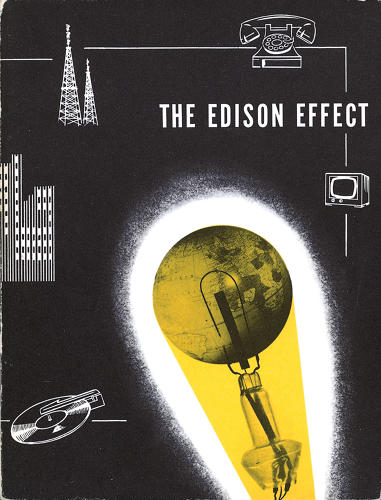
MC: The artists whose work is featured in your book (often anonymous at the time) were given the job of depicting a reality that exists, as you say, “behind reality.” You point to the inherent surrealism of such a task–can you expand on that? …You also note that in 1935, when the electric signals in the human brain were first detected, the study of the electricity, etc, was considered to be “a new assault on the mystery of life…”
MP: The study of the relationship between electricity and the human body is still pretty new. In fact, one reason that I wrote the book is that the future of the practical integration between electronics and the body could be immense enough that its recent history would be overshadowed. That history is already not commonly understood, even as people are increasingly symbiotic with their devices. I wrote the book to serve as a prehistory to counter any historical amnesia that may be induced by possible futures.
The scientific verification, in 1935, that life is reliant on a flow of electricity through the body, proved and extended an idea that Mary Shelley was working with in Frankenstein. Tracing the historical literature it’s interesting to watch the dialogue between electricity and the body migrate out of subcultures and into mainstream hard science over the past 200 years. I’m referring to subcultures like science fiction and also 19th-century experimental para-medical techniques, such as dosing people with electrical current to improve their health. That relationship was subjected to the changing standards of rigor around medical and scientific investigations over the 20th century. Today, work on electronic circuits that could have biomedical applications and that could actually be ingested and dissolved within the body is at the forefront of such research. Assuming that such circuits are developed and proven useful, I wouldn’t be surprised if they came to be a dominant biomedical technology.
When I say “behind reality” I’m referring most literally to the invisibility of the electron stream. While electricity can be made visible as illumination, the flow of electrons through electronic devices, on the other hand, is invisible. Hence, “Inside the Machine.” For a time the components that channeled the flow of electrons, such as vacuum tubes and switches, were visible on the inside of radio cabinets. Some 1930s radio cabinet designs deliberately revealed the circuit board in a gesture to demystify the flow of electrons and glamorize the components. That short window of visibility, however, quickly retreated in the face of ever more complex circuits and ever more “built” environments that housed them. The cultural signification around electronics came to be centered on the integral devices: radio, TV, and eventually computers and everything that flows from them. I felt that there was a cultural history of the components that combine to form electronic devices that needed to be told, and that it was the graphic artists and illustrators working for industry who had made that cultural history–a history that it became my job to expose and interpret for a contemporary audience.
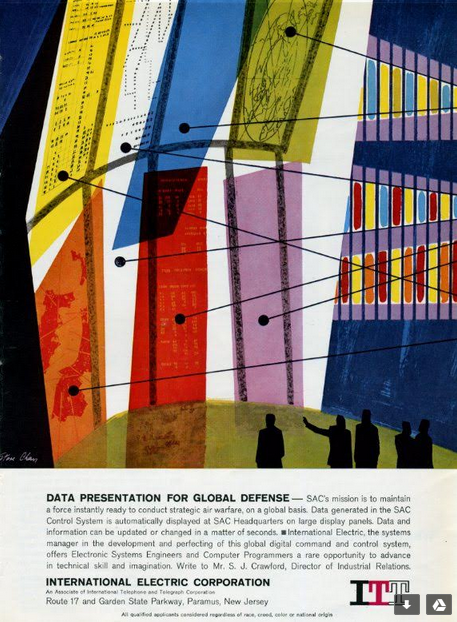
At a more philosophical level, the flow of electrons multiplied our senses. By forming invisible channels through which sounds and images were carried and replicated, electronics created a hierarchy of sense perceptions that had immediate cultural and political significations. How else to characterize that phenomenon besides surreal? Coincidentally the fine art movement known as Surrealism emerged in the 1920s and radios very shortly thereafter, coming to market in the late 20s and exploding in popularity during the 1930s. Think of it this way: multiple electromechanical eyes, faces, ears, and mouths populating homes, offices, and streets, in the form of a proliferation of new gadgets. The world filling with sense receptor multipliers everywhere you look. A mountaintop may be media in the sense that it opens up a perspective impossible to gain any other (unassisted) way, but a climb up a mountain is a unique event offering a unique perspective. Electronic media, in contrast, are most profound in their most ordinary distinguishing feature, which is their simultaneous multiplicity.
MC: You bring up Lewis Mumford in the book, saying that he regarded the craftperson’s bench as a sort of “bridge between art and applied skill.” To what degree has Mumford’s work influenced your thinking?
MP: I discovered the work of Lewis Mumford back in high school and appreciated his broad-spectrum thinking on a range of ground-based systems, like cities and highways. (The first book of his that I read was The Highway and the City.) Back in high school it was a novelty to me that subjects like freeways and cities were written about as subjects in their own right. They hadn’t been previously represented in any spectrum of “subjects” that I had been exposed to. I also liked about Mumford that he incorporated ecological thinking into his philosophies of the built environment, and that his environmental politics predated, and therefore did not fit into, contemporary modes of approaching those subjects.
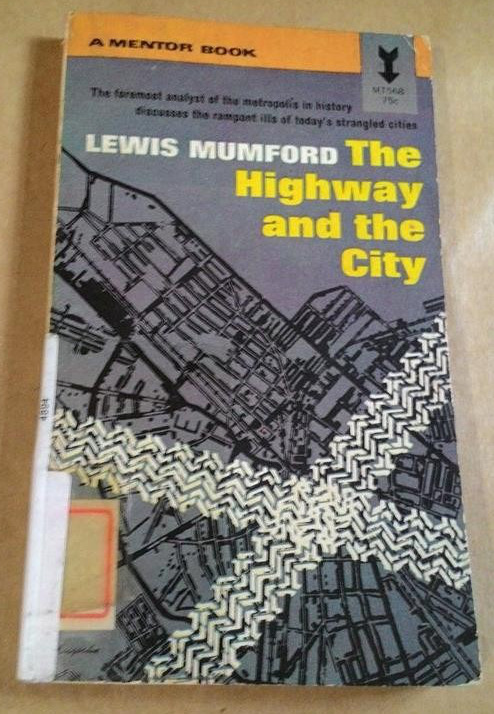
When it came to writing Inside the Machine, I drew on Mumford, who had once been a radio engineer, as a historian of technology (or “technics” in his parlance). His work to elaborate the relationship between fine art and applied art expressed by the craft bench was a needed historical context for discussing the relationship between craft and art.
MC: The constant need for an “enlargement of the military field of perception” has been hugely responsible for innovations in moving-image technology (I am quoting here from Paul Virilio’s book War and Cinema–which I found on your shelves). I wonder how things might have developed differently if such had not been the case? (In other words, if R&D had been guided by the Teslas and the Martenots of the world instead of by Westinghouse, the Pentagon, etc.).
MP: Well… the need for an enlargement of the military field of perception may have been responsible for innovations in moving-image technology, but it must exceed that in the extent to which it influenced space technology! The original satellite programs around the world, both USSR and US, were funded and dedicated to that purpose.
To get back directly, though, to the question you pose: It’s one that opens the door to many interesting possible alternate realities. That’s one reason I became so deeply focused on the work that fine and applied artists did to paint the future of new technologies. If I can make a blanket characterization of those artists as a group: I don’t think they were motivated to pick up a pencil or brush by a desire to enlarge the military field of perception! Instead they were creating all kinds of hybrid visions of the future, including pastoral and surrealist elements that addressed the multiplication of the senses in very humane terms.
There are perhaps more examples of the possibilities you suggest than you might think. For example: the influence of Hugo Gernsback, for whom the science fiction Hugo award is named. Gernsback was an active futurist who promoted science fiction and speculative futures through the mass publication of a wide range of pulp fiction magazines. At the same time he was a serious radio and TV pioneer who founded a radio station, experimented with early television broadcasting, and published “straight” news and craft magazine for radio professionals and amateurs alike, such as Radio-Electronics and Science and Mechanics to name just two. His “straight” news and craft magazines typically had a futurist-oriented editorial edge; one that was uninterested in mapping problems or limits or real-world geopolitics onto the emergence of new technologies. I don’t doubt that Gernsback’s influence was a shaping force on the emergence of electronic technology in ways that may not be fully understood for years. I don’t mean to dwell on Gernsback — he’s been widely written about in histories and biographies and I have never felt the call to add much to his hagiography. But I’m mentioning him here to directly respond to your query of “What if (R&D had been guided by the Teslas and the Martenots of the world)”. One more note: Tesla’s name was not attached to his invention in the way that Edison’s was, but he did invent AC (alternating current). Given that most people in the industrialized world use AC every day, I would argue that Tesla did guide the research and development of some of the essential infrastructure of everyday life.

MC: Toward the end of the book you wonder whether computers will someday be “grown” instead of built. Sounds cool! Brings to my mind certain left-field figures such as Bern Porter. …Porter chose to drop out of professional science (to pursue DIY “sci-art” and many other things) after having worked on the Manhattan Project. I thought of him while looking at your book, since he is also said to have helped develop the cathode ray tube. …I am curious, what you may have learned about humanity’s future by delving into all these inventions of the past?
MP: In crafting that conclusion I was putting together a few different pieces of real evidence and combining them in a hypothetical exercise. I didn’t think it was that crazy. Consider the following verifiable phenomena: The biomedical circuits that can be ingested and dissolved in the human body; the capacity of mycelia networks–underground networks of fungal bodies—to effectively redistribute nutrients between different plants in the soil; the published theory that life itself may have emerged from primordial clay (not “soup”); the wisdom of permaculture.
I’ve read widely about all these phenomena, and other related phenomena. When I try to visualize an answer to the problem of toxic chemicals and heavy metals bound up in electronic devices, it seems reasonable to me that a hundred years from now, or maybe even only twenty years from now, people will have figured out how to extract computational functions from some combination of these kinds of existing features of the natural world. Or will have developed some intelligent permaculture that can perform media functions at the same time as producing food.
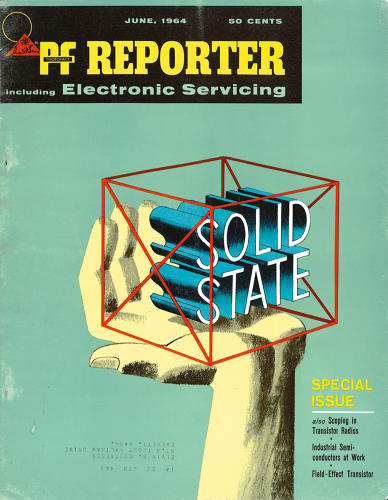
Or, never mind organic phenomena, what if all the essential elements of sand, stone, glass, (plastic) and metal that form electronic machines could be formulated and constructed to smartly dematerialize when they were no longer needed? What if you could drop a laptop into special bin that would use magnets and clean biochemical processes to disassemble all those building blocks, and distill them into measured piles and vials of raw materials for new machines?
Maybe I’ve read too much science fiction… but I’d prefer to believe that I’ve just read too much history to feel that the possibilities for the future are in any way fixed or limited. In human history–in natural history too, for that matter–epochal shifts happen sometimes “overnight” (at least in geological or historical senses), usually from the emergence of a new phenomenon that results from combined antecedents that were hidden below the surface until abruptly transformed and brought to daylight. There’s no reason to think that the dirty century of the 20th/21st centuries couldn’t experience an abrupt paradigm shift in favor of a very different kind of model.
Featured Image: Johannes lands in San Francisco.
Traceroute – A Personal Journey Into the Uncharted Depths of Nerd Culture, A Realm Full of Dangers, Creatures, and More or Less Precarious Working Conditions. (Or Fear and Loathing in Nerdcore).
“In the end, we’ll all become stories” Margaret Atwood.
Before Vaporwave, Post-Internet, Facebook, and your latest Kickstarter campaign, there was the cybercultural counterculture. I encountered it through publications like Collapse, Mondo 2000, ReSearch, Fringeware Review, and bOING bOING (when it was still in print), and on BBS boards like The Thing and The WELL. This was the land of cyberpunk, Dead Media, Tactical Media, The Church of the SubGenius, online dungeons and wetware hacking. This is the native culture of Johannes Grenzfurthner, born of the dark forests of Austria, famous for music and mass murder (by his own admission), and a crèche for nerddom.
Traceroute (…) is a reflection on his own roots of nerddom, and an On the Road style romp across the United States as he visits icons of the counterculture, the outré, and the generally questionable.
He begins Traceroute with a fitting genesis story of his growing up in Central Europe, dressing like Captain Kirk, making treehouses and accidentally killing the family chicken with a failed science experiment, reading comic books, making short films, and being obsessed with Pachelbel’s Canon in D Minor. He saw that the neighbor’s patio tile always looked like LCD displays, and he started noodling around with his neighbor’s computer, logging into the FIDONet, learning about his nerddom, discovering ASCII porn, and Woschi Woschi Wau Wau, the Dog that Never Pooped. If you’re following me up till now, then you’ll get the general tone of the movie.
As Johannes expands on his arc from a gawky Austrian kid to founding the cybermedia group Monochrom in a quirky Germanic stream of consciousness, he decides to take his friends Jenny and Eddie on a trip across the US for a tour de farce into the depths of cyber-counterculture.
He begins his trip, of course, in San Francisco – home of the counterculture and the Californian Ideology, which he calls, “a fantastic realm of infinite opportunity and homelessness” There, he begins his intellectual trek across the USA with V. Vale – author and publisher of the ReSearch series of documentary books. Vale began his publishing career with a volume called Search and Destroy while working at the City Lights bookstore – a Mecca of beat culture. He cements the foundations for the film in saying that nerds made the counterculture; there is a sort of reflection that only comes from isolation or obsessiveness, and “There is no creativity in the absence of revolt.” says Vale.
Suddenly, I realize that I’m about a half thousand words into this review, and only about a quarter way through the movie, and barely out of San Francisco. That is the nature of Traceroute, a relentless stream of factoids and side trips that talks about many things, like the whiteness of cyberculture, the uncomfortable relationship between counterculture and neoliberalism, shipping containers, Area 51, as well as sci-fi props and makeup at Stan Winston Studios. This is the nature of the nerd; to be infinitely interested in infinite numbers of things, the more obscure the better. Actually, giving a feel for the film without describing it in total is probably the best thing to do, as it leaves many of the places Johannes goes to the imagination.
Traceroute has both memorable moments and stops that simply must be done if one is to visit cyber-counterculture. One of the mandatory stops is to SxSW Interactive in Austin, Texas and a chat with Jon Lebkowsky and Bruce Sterling. Jon is one of the founders of the legendary 90’s zine Fringeware Review and icon of Austin counterculture, as well as omniglot. Bruce Sterling, is of course, Bruce Sterling – cyberpunk author, WIRED Magazine blogger, and cyber-tastemaker. Listening to Lebkowski’s surprise at the traction of the cyberpunk movement in the 90’s in contrast to Sterling’s waxing of hanging with the tragically hip Milanese cyber-squatters of the time reminded me of the romanticism that also accompanies the underground.
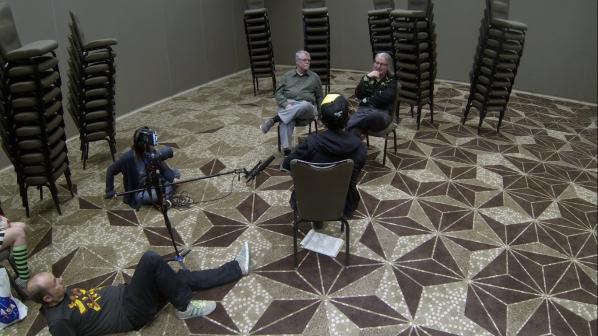
A fantastic moment was when the Traceroute crew actually winds up at the gate to Area 51 in the middle of the night and decide to talk to tactical artist Trevor Paglen to get more information about the site. Paglen, almost more than anyone, has done work that reveals “black” projects being pursued by the US government, such as stealth technology, spy satellites, the location of Internet ocean cables, and so on. During their conversation, Paglen brings up a mission patch for the US Air Force for a stealth project that has two things. First, there is an alien head, as it is Area 51 after all, and a caption that reads, “Gustatus Similus Pullus”, (or, Tastes Like Chicken). Frat humor in the skunkworks – hmmm…

Grenzfurthner also muses that we are two things – sexual beings and tool users. This makes sense as his group Monochrom hosts the annual Arse Electronika festival (a sexual play on the Ars Electronica in Linz). This reveals itself in a number of segments with Miss Maggie Mayhem (San Francisco), Kit Stubbs (Boston), Christina Anapakis (Los Angeles, who does art from body cultures), and Bad Dragon, a company that does science fiction/fantasy dildos. From Maggie’s playfully powerful illustrations of the links between sex work and Silicon Valley to Christina’s experiments with Johannes’ culture to make a failed cheese, I am happy to see that Monochrom’s sex and body-positive message that nerds are filled with a curiosity about all of the world around them is present in Traceroute.
My only complaint about the movie is that I wanted more of it, or perhaps more of the eastern US, as it is nearly three-fourths of the way through the film before we leave Austin. Perhaps the newest part of the country, the West, might be the weirdest, but I’ll leave that to Johannes. And there are tons of other alternative cultural sites to go, like the Museum of Jurassic Technology and Craig Baldwin’s Artist’s Television Access in California, and Rich Pell’s Center for Postnatural History, the Mystery Spot, but he had a week, and only two hours of video. But on the other hand, I’m giving inordinate attention to the first half of the film, so not only am I self-referentially riffing on Grenzfurthner’s narrative style here, but mimicking the structure of the movie.
Lastly, anyone dealing with outré culture that mixes nerddom and capitalist critique has to go to Monroeville, Pennsylvania – site of George Romero’s marvelous political zombie flick, Dawn of the Dead. They go to Monroeville Mall, the site of the movie itself, with leftist critic and game designer Paolo Pedercini. There is a certain poesis about Paolo ranting about consumer culture, nerddom, the nexus of the mall and the surveillance state while waiting for the security guards at the mall to show up. These remarkably self-referential shots are what makes Traceroute magical.

After watching Traceroute, I was left with a real exhilaration and a deeply reflective feeling at once, but I think this would be similar to Grenzfurthner’s experience on his ur-nerdtrek across the USA. I mean, except for being a decade older, we have a lot in common. Our upbringings were similarly nerdy, but mine in Ohio, and his in Austria, he started Monochrom while I was with RTMark, we have many friends in common in the film, and we’ve glancingly communicated for decades. And he just made the documentary of our shared subculture. Of course, I’m going to like this film.
However, I wondered – what about the relevance of cyberculture and the counterculture in the age of Facebook and postinternet slickness? I mean, what role does Traceroute’s subject matter have in the light of neoliberal, hyperprofessionalized cultural production evident in the mid-2010’s? But then, the words of Sandy Stone, an eternal voice of reason, rang out in my mind. She said that William Gibson (and I’d add, Sterling and the rest of the cyberpunks as well) wrote this future, and a lot of it came true. And it sort of went to shit, and we’re still doing it, and it’s all good. And I’d like to expand in saying that not just cyberculture, but counterculture just keeps going, and the fact that it’s from the 80’s or 90’s (or the 60’s, for that matter) makes any difference. What Johannes terms as nerd culture is merely many aspects of Western counterculture, and it’s a tradition that has given rise to everything from the Summer of Love to the personal computer (and that’s just San Francisco…). What Traceroute reveals is the tradition of alterity just beneath the surface of Western culture, and that it has a powerful effect on our mass consciousness, whether it is in plain sight or not. Traceroute is debuting at the NYC Independent Film Festival, April 27-May 1, 2016.
The Rubix Cube is is not the only twisty puzzle. Learn about Pyraminx, the 2×2 and 4×4 cubes, the Megaminx on Ruwix.
SEE IMAGES FROM THE PRIVATE VIEW
Furtherfield Gallery is proud to present Dimensioning – Live Architecture an exhibition of new digital artworks by Italian artist Chiara Passa, part of Furtherfield’s Open Spot programme.
Passa’s concept of «super places» and her search for new dimensions, or “campo piu’ in là” (a “further field”) underpin her work using architecture as an interface to understand the possibilities of the digital dimension. She uses augmented and virtual reality (AR & VR) to create interactive installations in which the technologies punch through and pull out a new sense of place in combinations of interior, architectural and natural environments.

In this exhibition visitors can explore her new digitally mediated perception of space and time in an animated multi-dimensional ‘trompe l’oeil’ of the gallery rooms as 3D wireframe view. Visitors stand in the middle of the “window-camera” view of the software, which has also been used to build the animations on display. They use augmented reality to “travel through” the walls, into the diagrams.

“Worlds open the doors to other worlds and synthetic shapes become design, structure, architecture and reality.”
Passa’s work offers a refreshingly passionate approach to experimental and philosophical play with technologies. We think that this is especially valuable in an age where our expressive range and behaviour is increasingly pre-determined by the digital tools, techniques and devices that we use daily, and the interests, experiences and values of those who create them.
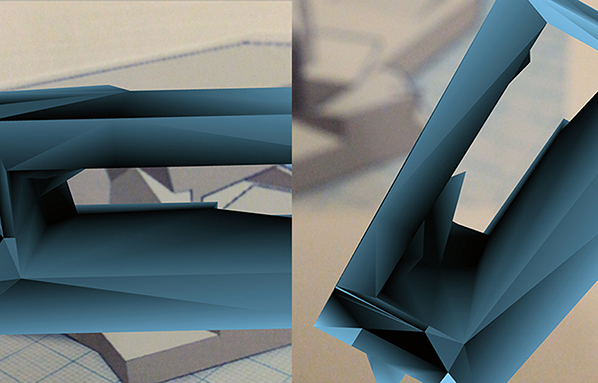
Also for this exhibition visitors will experience her VR 3D animation using a Google Cardboard viewer.

Chiara Passa talks about Dimensioning – Live Architectures at Furtherfield Gallery in the video below
Chiara Passa, media artist (Rome 1973). Graduated at Fine Arts Academy of Rome; master in new audio-visual mediums at the Faculty of Modern Literature.
Her artwork combines many media and platforms analysing changes in ‘liquid space’ through a variety of techniques, technologies and devices – often constructed using augmented reality and the virtual reality technologies. She works with animation and interactive video-installation; digital art in public space as site-specific artwork and video-mapping; video-sculptures and objects; art-applications and widgets for mobile platforms.
She explores the potentials offered by the intrinsic languages of these emerging platforms to experimenting in a rigorous and personal way with the full expressive range and “unknown creative possibilities that the new media are continuously offering to me”. She received the E-Content Award (2012). Her work is regularly exhibited internationally in galleries and at festivals, conferences and institutions including ISEA, Vortex Dome (USA), Media Art Histories Conference (DE), Electrofringe (AU), FILE | Electronic Language International Festival(BR), CCCB – Centro de Cultura Contemporània de Barcelona (ES).
Furtherfield is a leading organisation for art, technology and social change. Furtherfield Gallery and Commons spaces in the middle of London’s Finsbury Park explore complex themes relating to digital culture, inspiring diverse people to get involved with arts and technology on their own terms. Debate is facilitated amongst an active international community of artists and thinkers via online platforms, combined with accessible art shows and labs to enable co-creation and widen participation. Furtherfield is a not-for profit, artist led organisation, an Arts Council England National Portfolio organisation, supported by Haringey Council.
The Furtherfield ‘Open Spots’ programme of self-initiated and self-funded exhibitions and events support the presentation of new work and artistic invention, to discover new perspectives on the horizon of a wider networked society.
Curators and artists that meet Furtherfield’s selection criteria can showcase work at Furtherfield Gallery in the heart of London’s Finsbury Park. Open Spot projects can reach a new, diverse audience of gallery visitors, park users and Furtherfield’s online participants.
Gretta Louw reviews Abrahams’ book from estranger to e-stranger: Living in between languages, and finds that not only does it demonstrate a brilliant history in performance art, but, it is also a sharp and poetic critique about language and everyday culture.
Annie Abrahams is a widely acknowledged pioneer of the networked performance genre. Landmark telematic works like One the Puppet of the Other (2007), performed with Nicolas Frespech and screened live at the Centre Pompidou in Paris, or her online performance series Angry Women have solidified her position as one of the most innovative net performance artists, who looks not just at the technology itself but digs deeper to discover the ways in which it impacts human behaviour and communication. Even in the present moment, when online performativity is gaining considerable traction (consider the buzz around Amalia Ulman’s recent Instagram project, for example), Abrahams’ work feels rather unique. The strategy is one of contradiction; an intimacy or emotionality of concept and content, juxtaposed against – or, more accurately, mediated through – the technical, the digital, the screen and the network to which it is a portal. Her recent work, however, is shifting towards a more direct interpersonal and internal investigation that is to a great extent nevertheless formed by the forces of digitalisation and cultural globalisation.

(E)stranger is the title that Abrahams gave to her research project at CONA in Ljubljana, Slovenia, and which led to the subsequent exhibition, Mie Lahkoo Pomagate? (can you help me?) at Axioma. The project is an examination of the shaky, uncertain terrain of being a foreigner in a new land; the unknowingness and helplessness, when one doesn’t speak the language well or at all. Abrahams approaches this topic from an autobiographical perspective, relating this experiment – a residency about language and foreignness in Slovenia. A country with which she was not familiar and a language that she does not speak – regressing with her childhood and young adulthood experiences of suddenly being, linguistically speaking, a fish out of water. This experience took her back to when she went to high school and realised with a shock that, she spoke a dialect but not the standard Dutch of her classmates, and then this situation arose again later when she moved to France and had to learn French as a young adult.
There are emotional and psychological aspects here that are significant and poignant – and ‘extremely’ often overlooked. The way one speaks and articulates oneself is so often equated with intelligence and authority – and thus the foreigner, the newcomer, the language student, is immediately at a disadvantage in the social hierarchy and power distribution. Then, there are the emotional aspects and characteristics requisite for learning a language; one must be willing to make oneself vulnerable, to make mistakes. This is a drain on energy, strength, and confidence that is rarely if ever acknowledged in the current discourse around the EU, migration, asylum seekers, and – that dangerous word – assimilation. Abrahams lays her own experiences, struggles, and frustrations bare in a completely matter-of-fact way, prompting a re-thinking of these commonly held perceptions and exploring the ways that language pervade seemingly all aspects of thought, self, and relationships.
Of course this theme is all the more acute in a world that is increasingly dominated by if not the actual reality of a complete, coherent, and functioning network, then at least the illusion of one. In a world where, supposedly, we can all communicate with one another, there is increasing pressure to do so. Being connected, being ‘influential’ online, representing and presenting oneself online, branding, image – these are factors that are becoming virtues in and of themselves. Silicon Valley moguls like Mark Zuckerberg have spent the last five or six years carefully constructing a language in which online sharing, openness, and connectivity are aligned explicitly with morality. Just one of the many highly problematic issues that this rhetoric tries to disguise is the inherent imperialism of the entire mainstream web 2.0 movement.
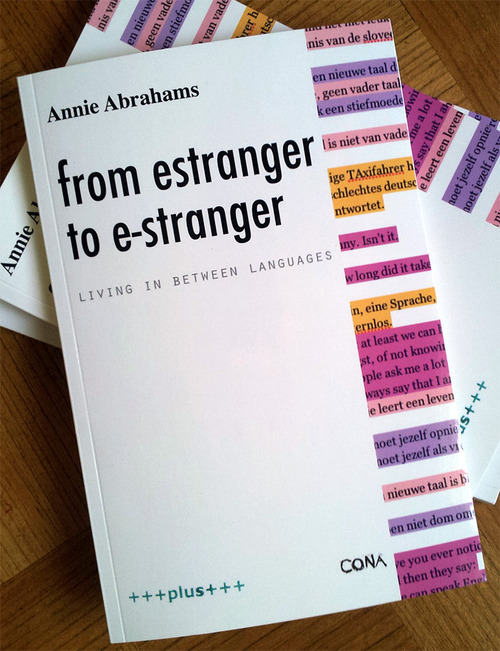
Abrahams’ book from estranger to e-stranger: Living in between languages is the analogue pendant to the blog, e-stranger.tumblr.com, that she began working on as a way to gather and present her research, thoughts, and documentation from performances and experiments during her residency at CONA in April 2014 and beyond. Her musings on, for instance, the effect dubbing films and tv programs from English into the local language, or simply screening the English original – how this seems to impact the population’s general fluency in English – raise significant questions about the globalisation of culture. And the internet is arguably even more influential than tv and cinema were/are because of the way it pervades every aspect of contemporary life.
This leads one irrevocably to consider the digital colonialism of today’s internet; the overwhelming dominance of western, northern, mainstream, urban, and mostly english-speaking people/systems/cultural and power structures. [1] Abrahams highlights the way that this bleeds into other areas of work, society, and cultural production, for example, through her citation of Mladen Stilinovic’s piece An Artist Who Cannot Speak English is No Artist (1994). In a recent blog post, Abrahams further reveals the systematic inequity of linguistic imperialism and (usually English speakers’) monolingualism, when she delves into the language politics of the EU and its diplomacy and parliament [http://e-stranger.tumblr.com/post/139842799561/europe-language-politics-policy].
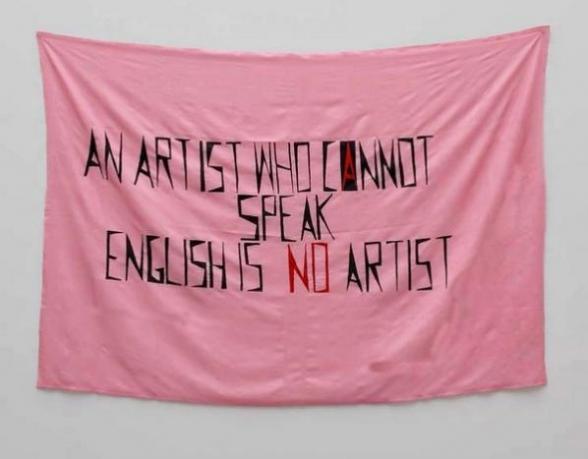
from estranger to e-stranger is an almost dadaist, associative, yet powerful interrogation of the accepted wisdoms, the supposed logic of language, and the power structures that it is routinely co-opted into enforcing. It is a consciously political act that Abrahams publishes her sometimes scattered text snippets – at turns associative or dissociative – in a wild mix of languages, still mostly English, but unfiltered, unedited, imperfect. A rebellion against the lengths to which non-native speakers are expected to go to disguise their linguistic idiosyncrasies (lest these imperfections be perceived as the result of imperfect thinking, logic, intelligence). And yet there is an ambivalence in Abrahams’ intimations about the internet that reflect the true complexity of this cultural and technological phenomena of digitalisation. Reading the book, one feels a keen criticism that is justifiably being levelled at the utopian web 2.0 rhetoric of democratisation, connection etc, but there are also moments of, perhaps, idealism, as when Abrahams asks “Is the internet my mother of tongues? a place where we are all nomads, where being a stranger to the other is the status quo.”
Abrahams’ project is timely, especially now that we are all (supposedly) living in an infinitely connected, post-cultural/post-national, online society, we are literally “living between languages”. The book is an excellent resource, because it is not a coherent, textual presentation of a thesis; of one way of thinking. It is, like the true face of the internet, a collection, a sample, of various thoughts, opinions, ideas, and examples from the past. One can read from estranger to e-stranger cover to cover, but even better is to dip in and out, and or to follow the links and different pages present, and be diverted to read another text that is mentioned, to return, to have an inspiration of one’s own and to follow that. But to keep coming back. There is more than enough food for thought here to sustain repeated readings.
Robert Jackson continues with a second journey into the realms of Accelerationism and Ordinaryism. Having articulated how Accelerationism merges Enlightenment principles in a supposed age of automation, Jackson interrogates its philosophical roots by suggesting that the core motivation behind its key approach embraces skepticism (even if the explicit method is to reject skepticism in favour of increasing applications of knowledge) – whereas what Ordinaryism suggests (following Cavell) is that skepticism cannot be refuted nor endorsed, only inhabited as a salient vulnerable conditon. The political implications of this division are telling and can be extrapolated through the freedom to Exit (inhuman acceleration) versus the freedom to find ones Voice (Ordinary appeal).
“But who is the authority when all are masters?” (Cavell, The Claim of Reason, p. 180).
For part 1 click HERE.
For part 3 click HERE.
In its philosophical usage ‘skepticism’ [i] hardly surfaces, if at all, in the contemporary Accelerationist lexicon. This is to be expected: as its political aspirations are organised by a cascade of philosophical trajectories designed to either refute skepticism, or as ordinaryism will claim, not bother to take it seriously enough.
Ordinaryism and Accelerationism approach familiar problems, even familiar desires, from familiar starting points, yet ultimately arrive at different conclusions. Most notably the political desire to overcome the intellectual chagrin of postmodern skepticism. Exactly what sort of overcoming is required feeds the conflict put forward: a conflict which has its history in the activity of reasoning as referenced earlier between Wilfrid Sellars and Stanley Cavell’s divulging and unique approaches to post-analytical knowledge.
Part 2 explores the following discord: Accelerationism (specifically its neo-rationalist, epistemic variant) builds a collection of political arguments which in order to work, have to refute skepticism. This is akin to (but not conflated with) the removal of skepticism in political emancipation through the practical competency of conceptual, normative reasoning. Ordinary, everyday experience is only considered as a human constraint that can be overcome or explained by a technological inhuman sovereignty of collective reasoning, where linguistic practice is essentially procedural, explanatory, functional and rule-governed. Alex Williams put it this way in his 2013 essay ‘Escape Velocities’;
Accelerationism in this guise is the project of maximizing rational capacity—the contents of knowledge about the world—and enabling the ramification of the conceptual space of reason… Enlightenment, rather than entailing an edifying reassurance of the humanistic order, instead gradually but irreparably modifies the manifest image of ourselves-in-the-world, stripping back the comforting homilies of humanism to reveal, Terminator-style, the gleaming bones of Sellars’s empty, formalist, rational subject lying beneath.
Ultimately Ordinaryism and Accelerationism want the same outcome though: the progressive aim for a better future in the face of the immediate everyday. But whereas Accelerationism thinks this can be achieved through the ascension of reason, Ordinaryism thinks it can be achieved only by acknowledging reason’s vulnerability. We must attend and attune to a diurnal world and others around us through the emotional exposure of claims rather than the Promethean expanse of the stars. Ordinaryism interrogates this force of Accelerationist reasoning and seeks a romantic alternative located in the epistemic, ethical and aesthetic priorities of responsiveness, alterity, otherness and appeal that are constitutive of the everyday and its fusion with technology. The larger attempt calls for the everyday to be reclaimed whilst surrounded by the purported effects of a ‘knowledge economy’. How is it that everytime we appeal for a new future, we are really appealing for a ‘new normal’?

The diagnosis establishes itself in the role of skepticism: and for Ordinaryists, skepticism cannot be refuted – only inhabited. Epistemic doubt has to be lived and coped with. The Cavellian lesson of the ordinary is that the world isn’t to be known, but to be acknowledged: a viewpoint which, presumably, would make the accelerationist hairs stand on end. But this not to say that ordinary acknowledgement – the everyday in general – is tantamount to political complicity and illusive habit. Ordinaryism only establishes an interest in what Cavell terms the eventual everyday, against the actual everyday of common sense, responding to the ordinary as if it appeared to us for the first time. Our relationship to others, and of the world, isn’t an exercise of philosophical skill which can be explained or solved because of an intellectual error, with its ambiguities swiped aside or viewed as insufficiently limiting. Nor is this condition indicative of ‘ordinary beliefs’ in public consensus whilst experts and technicians manipulate the structural groundwork behind the scenes: it is central to the democratic possibilities of all political activity. Bringing Cavell’s views of skepticism into focus allows us to acknowledge that politics is not well-serviced from a detached epistemological point of view: or an inhuman, impersonal space of reasons. One might wish to ask, why should any appeal to the strange tendencies of the inhuman take priority, when the familiar is equally as strange?
And following Cavell, the ‘ordinary’ in this view, is taken from the ordinary language philosopher’s commitment to reasoning. It appeals to “what we should say when..”: that any ordinary voice, what we ordinarily say, ordinarily mean, ordinarily know, has the same authority as any other when responding to what a situation calls for. Moreover, with ordinary language philosophy’s technique (in particular its leading practitioner J.L. Austin), one can simply take an instance of a word, used with certainty (I am free, I know) pick out all the ordinary, ambivalent uses philosophers don’t bother addressing, only to reveal as if for the first time, what it is we ordinarily accept everyday.
It’s a radical challenge that has a loose origin in Romanticism, but can be hinted at through punctuated periods of twentieth century philosophy. However the idiosyncratic musings of Wittgenstein interest us here, or at least those brought into fruition by Cavell’s masterpiece The Claim of Reason building towards later work on Emerson. Cavell remains indispensable here insofar as his collective, idiosyncratic view imparts a view of language, justification and reasoning based on the never-ensured acknowledgement of one other (and the claims of what we ordinarily say through one’s voice), in each specific and singular case of reasoning. This will be opposed against a neo-rational appeal to a universal inhuman force, waging on some quasi-guarantee that reason is alien, determinate and self-correcting.
In the space given I won’t be able to replicate the philosophy here at its most sophisticated, so we’ll have to settle for a more general level of enquiry that collates various, repeated aspects of the conflict involved. The remarks put forward will hopefully show why a Cavellian normative ‘Voice’ or ordinary appeal is an indispensable political tool, only because it treats skepticism seriously as an ordinary task in a world of increasing automation, not to superseded by a warped view of technology that can overcome it. Ordinaryism sheds a Cavellian insight that our relationship with technology fundamentally pivots on living our skepticism: inhabiting our condition, acknowledging our vulnerability, making ourselves intelligible to others, desiring an intimacy with things and establishing a voice to do so. The additional requirement here, comes to terms with the notion that skepticism isn’t a unique feature of ordinary language projected onto the world (as Cavell held), but is now operationalised in machinic systems. This is explicitly against an accelerationist insight, that machines operationalise the ascension of inhuman reason.
The problem is that Accelerationist reasoning simply refuses to consider skepticism as a problem, ridicules the everyday and instead pines for an inhuman, rule-bound determination of normative governance, which the ordinary cannot achieve. By doing so, it appears unconcerned with political dangers once the voice of others is rendered insufficient: that we could fail to acknowledge others, unwittingly presenting our relationships to knowledge and of other minds as unproblematic.
This unorthodox schism on reasoning can be exposed into a more contemporary technical conflict vying for political, philosophical and technological priority – call it, the freedom to Exit (inhuman acceleration) versus the freedom to find ones Voice (Ordinary appeal). The claim being that all political repercussions of Exit versus Voice pivot on whether you can refute skepticism, or inhabit its condition.
Over two years ago, Stanford University lecturer and entrepreneur Balaji S. Srinivasan delivered a speech at the 2013 Startup School event, entitled “Silicon Valley’s Ultimate Exit” (Transcript here). His talk was noteworthy for galvanising Silicon Valley cohorts into a usual online futurist catatonic stupor. But like all effective presentations Srinivasan delivered one simple, established idea into a contemporary setting and did so with honesty and gusto. Silicon Valley’s seemingly unstoppable knack for disrupting nearly all forms of cultural production and communication can be unpacked from an insight in 1970s political science.
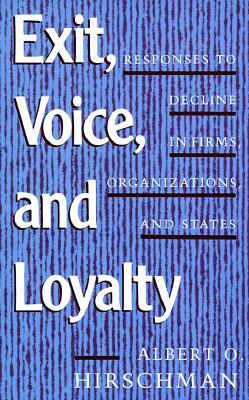
Srinivasan paid tribute to the landmark libertarian 1970 treatise “Exit, Voice, and Loyalty: Responses to Decline in Firms, Organi[s]ations, and States” by Albert O. Hirschman, in which the author stated the following economic conjecture: When any particular form of human system culturally designed to offer a service (a business, charity, government, country, state, school, etc.) experiences a decrease in quality, they have two options for freedom; either Exit or Voice. Put simply, Exit is the attempt to withdraw completely from the relationship provided with the aim of joining or starting up another, whereas Voice gives the customer the right to reform the existing relationship through protest and complaint.
Hirschman used these two options as a prism for opening up a range of economic and political outcomes that encapsulate ones freedom, equally emphasising that such models were mutually exclusive, operating in a parallel stop-start fashion. He understood Exit to be exclusively libertarian where freedom was guided under the economic freedom of the market, where decline could be corrected by ‘better’ services. Voice became the political freedom to confront existing decline by reforming the system within. Unpacked into differing global contexts, Exit vs. Voice shifts into multiple flavours of freedom, emanating from the same source. For a consumer, Exit manifests itself as the freedom to take your business elsewhere, whereas Voice is sending off a complaint form. For a country, Exit becomes emigration whereas Voice becomes the democratic right to vote. In the case of lobbying, Exit expresses itself as the think tank, whilst Voice emerges as the grassroots protest.
However Srinivasan took Hirschman’s options and gave the distinction a new technological edge relatable to an age of platforms, code, startups and disruption. Srinivasan suggested that Exit is a meta-concept which Silicon Valley has implicitly adopted, subsuming Voice without eliminating it (and perhaps even amplifying the latter). It is the hidden gear behind the Valley’s dominance, from various startup successes to the inherent properties of code itself. He cites the fact that Larry Page and Sergey Brin could never have reformed Microsoft from within, and so had to found Google by attaining the freedom to exit Microsoft completely, taking the sustained knowledge of their peers and independently crafting something smarter and better. Similarly, in software engineering if Voice operates as a patch designed to reform existing functional problems, Exit is the fork designed to splinter an existing platform of ineffective decline into a separate, and (presumably) more effective one.

But Srinivasan’s talk was essentially in support with ‘ultimate exit’ – the idea that the United States itself was completely beyond libertarian reform, and that Silicon Valley would in the next 10 years have to secede, and launch its own independent platform if it wanted to maintain freedom. Srinivasan’s rationale (which has solidified its popularity since 2013) is that if you can do it with a startup why not an entire country? It’s not exactly a pipe dream wither. A failed startup called Blueseed already sought funding in order to attempt such a feat, but it was eventually postponed. Blueseed was the closest attempt at creating an ultimate Exit, where a purposely built cruise liner, sailing twelve nautical miles from San Francisco, would allow entrepreneurs to create their own businesses without the need for a U.S work visa. Earlier still, a 2005 startup called SeaCode promised something similar, but similarly folded due to insufficient funding.
In the eyes of the Valley though, the Exit strategy has successfully challenged existing industries anyway; including Hollywood (through Netflix), print and television outlets (through social media), city transport (through Uber), currencies (through Bitcoin and Blockchain), healthcare (The Quantified Self movement), and even simple objects (3-D printing). Before the backlash hit the fan, Srinivasan’s foresaw that the only future worth betting on would involve building “an opt-in society, ultimately outside the United States, run by technology.” Who is John Galt? Presumably Balaji S. Srinivasan.
Randian fetishes aside Exit versus Voice is a clever forced choice. It’s designed to organise a schism in contemporary political thought where cultural activities and labour are increasingly wedded to automation: from casual acts of ordinary communication, to the darkest depths of hidden encryption. It’s a schism which the theoretical movement of Accelerationism is borne out from, despite the clear difference of its political goals and the varying flavours bundled with its name. Replacing Srinivasan’s libertarian freedom for a hard left emancipatory stance, Exit is now construed as engineering a post-capitalist exit, and ‘opting-out’ becomes inventing and repurposing technological infrastructure towards emancipation without losing any of the inhuman significance that got it there.
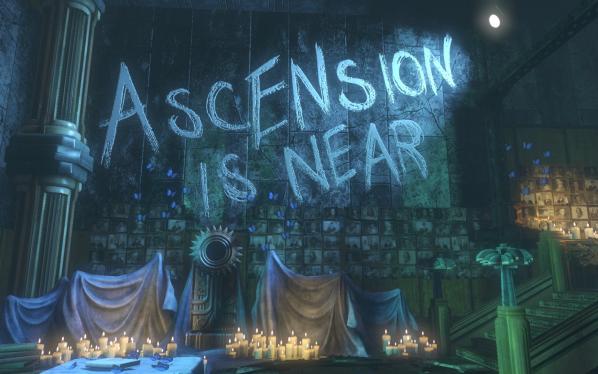
What is it however that philosophically separates the contemporary Left accelerationist position from previous iterations unable to grasp the future, or have resisted such attempts? We are of course reminded of such post-structural flights of fancy, (accelerationist musings of Lyotard, Deleuze and Guattari) to the experimental Cybernetic Cultural Research Unit (CCRU) whose famous figureheads included Nick Land & Sadie Plant. As many have already written, Land has become the quintessential prophet of the contemporary ‘Exit’ strategy (both in his early philosophical work, and later activities) understanding capitalism to be the ultimate engine of inhuman freedom. If our manifest fate is destined to head towards a technological singularity, it has only been put on ice because of meddling Marxists and (in his eyes) a dribbling progressive State. Having reorganised his views into neo-reactionism (NR-x), (which Srinivasan’s talk contributes to and in no small part, influentially gravitated a great number of libertarians towards), Land has one goal: the full realisation of ultimate exit. As Park MacDougald put it last year, Land’s;
Laissez-faire, in this view, is doomed to failure as soon as it’s up for a vote. Rather than accept creeping democratic socialism (which leads to “zombie apocalypse”), Land would prefer to simply abolish democracy and appoint a national CEO. This capitalist Leviathan would be, at a bare minimum, capable of rational long-term planning and aligning individual incentive structures with social well-being (CEO-as-Tiger-Mom). Individuals would have no say in government, but would be generally left alone, and free to leave. This right of “exit” is, for Land, the only meaningful right, and it’s opposed to democratic “voice,” where everyone gets a say, but is bound by the decisions of the majority — the fear being that the majority will decide to self-immolate.
Shockingly, Land’s NR-x demands the elimination of democratic voice altogether because, in his view, economically and socially effective governments legitimize themselves eschewing any appeal for a democratic voice. There isn’t any need for a voice if, like a commercial service, you can just exit your government and join a better one. So long as the functional technocratic inhuman is maximally realised there can be no room for moralism, sentimentality or suffering, for these are the very human traits which hold back our genuine freedom. Bending the market to fit human empathic needs will be futile. The sustained requirement for humans to lend a voice of political appeal is simply too ineffective to halt the inhuman onslaught of capitalist acceleration.
Cemented into the freedom to Exit is the implicit determination that all global technological progress (and its inherent possibilities as production) is bound up with the invisible, impersonal rigour of inhuman market competition, which democratic voice has little hope of addressing, let alone overthrowing. In Land’s view, capitalism is akin to an inhuman non-conceptual alien automatically programming human behaviour in order to drive it forward. This strange, foreign compulsiveness is integral to our dystopian future and Land’s job is to let the tap run (or more accurately, don’t pull the charger out).
So with Land’s current brand of libertarianism leaning more to the right than someone whose right leg has just been blown off, the political ground to develop a Left accelerationism has been given renewed impetus. As Peter Wolfendale previously pointed out, both positions jointly agree that capitalist production and modern developments of social justice are utterly incompatible, and the site of their incompatibility combined with technological expertise is what motivates both to conceive of an Exit: but crucially the discord between them comes from which set of principles should be exited from, and what sort of freedom is called for;
The right thinks that the accelerative emancipatory force is nothing other than capitalism itself, whereas the left thinks that capitalism is an adaptive and plastic obstacle suppressing a deeper emancipatory dynamic. It is in essence a disagreement about freedom: what it is to have it, what it is to enhance it, and whether there is anything we can do about it.
What both forms of freedom inhabit is to construct an exit from the limitations of the current status quo entrenched in reaction, resistance, refusal and reform. If the force of ‘Exit’ is what both movements share, then they also share the same schism of opposing Voice. And in one name or another, this is exactly what Nick Srnicek and Alex Williams have dubbed ‘folk politics’: political methods which eschew inhuman knowledge, global reach, feedback and technological infrastructure favouring instead outdated methods of reform, simplicity, horizontal plurality, immediacy and reactive protest (the 2008 Occupy protests being one example of many). In short, politics that might be associated with the demands of Voice. They may not wish to call it Voice, or be opposed to Voice democratically, and might even propose that it has some sort of place in contemporary political struggle. However, their opposition to a certain form of phenomenological immediacy in authentic resistance (which Voice might certaintly inhabit), carries all the connotations of leftist action they find strategically moribund. Reform and resistance are no longer the sole legitimate leftist options to overcome capitalism.
Their logic is two fold – 1.) reforming the capitalist system through protest, localism and critique alone has become useless at furthering leftist goals, often resulting in unashamed defeatism. Human acts of immediate protest and localism are no longer any match for the long term planning of inhuman complexity that global capitalism has become. The left simply sets itself up to fail.
2.) In light of this failure, contemporary leftist politics has a choice: either reduce political action to a relatable human local level, or embrace complex conceptual mediacy of capitalist process. In adopting the latter, the technological tools at our disposal afforded by capitalism must now invent alternative platforms repurposing leftist change, rather than chastised as oppressive, skeptical limits inherent to it. The left can no longer solely rely on ‘having a voice’ which appeals to habitual sit-ins and sporadic acts of resistance: it must invent alternative methods of infrastructure that will eventually abandon the need for capitalism, overcoming leftist resistance and reform completely (think André Gorz, but with Big Data and Apps).
The output of that challenge operates through various interlocking projects:
—Political theories for how a post-capitalist world that abolishes work can not only be made intelligible but be feasibly engineered (see Srnicek and Williams in their recently released publication ‘Inventing the Future: PostCapitalism and A World Without Work’ published by Verso). To be clear Srnicek and Williams entirely abandon the term ‘Accelerationism’, or ‘Left-accelerationism’ not specifically because of disagreement, but to alleviate widespread confusion.
—Renewed commitments to nineteenth/twentieth century cosmicism that manifests in a post-Earth future. Or alternatively treating science fiction as a necessary path towards a real exit (in its absolute form, exiting the Earth). (See Benedict Singleton’s Maximum Jailbreak)
—Regrounded developments in feminist strategies (see the recent xeno-feminist (XF) manifesto), by the anonymous collective Laboria Cuboniks which in their words asks that “Reason, like information, wants to be free, and patriarchy cannot give it freedom. Rationalism must itself be a feminism. XF marks the point where these claims intersect in a two-way dependency. It names reason as an engine of feminist emancipation, and declares the right of everyone to speak as no one in particular.”
—New strategies for art that oppose contemporary art’s global hegemony (See the forthcoming publication ‘On the necessity of Art’s Exit from Contemporary Art) by Suhail Malik. One might see a recent influence in Holly Herndon’s song “An Exit” which is describes Malik’s exit as “rather than act in angry opposition to an existing aesthetic or marketplace, we just walk away, facing towards the future”.

Yet, the lynchpin that passes through these varying outputs has one additional philosophical goal: one that has reshifted the political site upon which inhuman freedom can be realised through an interconnected philosophy beginning to rethink contemporary forms of reasoning, knowledge and rationalism.
What gives the Left accelerationists an injection of substance is not merely repeating Marxist demands that capitalism is an unjust, unequal system which promotes corpulent wealth, but that it primarily holds back the progressive and explanatory capacities of inhuman reasoning and technological progress (or at least that Voice, under this view, can only ever be the immediate starting point for an inhuman ascension).
Simply put, Left-accelerationism recognises both the lack of freedom and rationality and seeks to restore both in a more contemporary guise: the normative aim of constructing political freedom in ever greater inhuman measures. Thus the additional impulsion of Srnicek and Williams’ project stresses that the only method of overcoming capitalism is to self-master our epistemological knowledge of it , in order to apply methods that structure leverage towards rational self-determination. Here one almost tastes the accelerationist contempt for Leftist skepticism, and all of its appeals to doubt that have become complicit in contemporary forms of political action undermining progressive futurist thought. Skepticism for them, only bestows reason with a staggering lack of imagination and of lives that entirely accept the limits of neo-liberal stupor wrought by epistemic immediacy and affirmationist philosophies (distancing itself from the vitalist aspects of Deleuze and Guattari plays a key developmental role here).
The philosophical appeal toward a universal rationalist epistemology supports accelerationism’s desire to reengage with the Enlightenment project, where freedom becomes the binding of oneself to a universal rational rule (that must include and surpass capitalist and economic development) together with an adherence to that rule. More importantly the universalisation required must be a movement of Promethean ascension which promotes, as Williams puts it alongside Srnicek in an interview with Mohammed Salemy: “the idea that through our knowledge of the world and through political struggle, too, we can open new ways of being free that were unavailable to us before.” Inhuman Exit is rescued from the libertarian darkness of the NR-x hand, and into the clutches of unending rigorous collective reasoning. Inhuman freedom is repurposed away from compulsive slavery of alien market forces, to an alien rationality of a free rational subject that might exit from capital. The only alien demand is an inhuman demand to self-master our own possibilities towards rejecting capitalism (towards a post-capitalist future).
Williams has previously suggested that the twin thinkers of epistemic accelerationism are Ray Brassier and Reza Negarestani (whether these thinkers agree is another matter). Both are highly influenced by Land, and both are committed to an anti-skeptical method of gaining knowledge about the world, where the freedom to reason emerges as rule-governed, practical, revisable, autonomous and collective, not reducible to the manifest experience of humanity yet central to its emergence. Their neo-rationalism repeats the enlightenment’s desire to explain and act on the collective determinacy of the human epistemological condition outside any specific context.
The freedom to self-master an Exit lends its the support for a universal rationalist epistemology as enshrined within Sellars pragmatism (as outlined in Part 1 ). In this guise freedom becomes, according to Brassier, “… not simply the absence of external determination but the agent’s rational self-determination in and through its espousal of a universally applicable rule.” For complicated reasons Sellars sets out a pragmatist view of reasoning which is defined by its anti-skepticism as much as its Promethean promise (dependent on which thread of influence you follow). What makes such freedom a feature of pragmatism is that rationality is understood as an inherently social linguistic activity as well as a rule-based resource for expanding collective knowledge. Freedom through reasoning is grounded in essentially public and social normative practices of communication, that account for the correctness and incorrectness of ordinary linguistic usage and function. The accelerationist motivation is compelled by a pragmatist sensibility that rationality is founded by the capacity of a community to ‘agree in’ statements and judgements as normative commitments and entitlements. This domain from which freedom resides, and where it can be emancipated from, lies in a shared conceptual framework of utility.
The notion that human creatures are defined by living in a normative space of reasons has obvious overlapping concerns with the origins of philosophy, but only really found its teeth in the Enlightenment. The idea that I, as a rational subject can apply a certain concept means I must be committed to or bound by certain consequences. This can be traced through Plato and Aristotle, although the history takes its initial cue from Kant who understood human concepts to be uniquely and fundamentally normative, despite their finite status. Hegel then builds on Kant’s normative insight, eschewing the acknowledgement of finitude, by showing how freedom emerges from normative constraints inherent to discursive social statuses. Or putting it differently, developing an insight that the creation and generation of ideas and concepts arise in a shared normative medium. Freedom is thus, socially expressive, constitutive of norms and rules that already govern and constrain it, yet also subject to generative possibilities which it entertains. As Robert Pippin puts it;
… the problem of freedom, and in the Kantian/Hegelian tradition […] means being able somehow to own up to, justify, and stand behind one’s deeds (reclaim them as my own), and that involves (so it is argued) understanding what it is to be responsive to norms, reasons.(Pippin, The Persistence of Subjectivity: On the Kantian Aftermath, 2005, p. 11)
One of the most influential Hegelian ideas that the epistemic accelerationists have adopted (amongst others) is that without any justification, inferred assertion or claim – let alone a political claim – intelligible forms of progressive political action or agency are out of the question. No human communication occurs, principally, within the sole reducible product of a human individual, but as a distinctly social progressive achievement of reason and that ordinary modes of intelligibility have to be cemented in normative commitments of correctness. The job of philosophy is to offer an explanation constitutive of the very normative system it seeks to explain. Recoding these Kantian and Hegelian insights is said to establish and explain the inner workings of what we mean when we say something.
Clearly, the real reason why such Sellarsian normative accounts are useful is that they are characteristic of many philosophical attempts to comprehend language through a systematic and explainable structure, fully applying the force of reason with practices that commit effective conceptual action. It strips the rational subject back until it finds the primitive inhuman, artificial, functional, rational ‘machine’ guiding the system through the freedoms of feedback and function: What Sellars demarcates as the sapient, normative space of reasons (doing something for a reason) is understood to be completely separate from the sentient, causal nature of reasons (doing something because of a reason). Norms of reasoning cannot, like natural laws, suggest what will happen, but instead what ought to happen, and pinpoint shared, rational outcomes that can be correctly drawn from certain assumptions.
Responsibility and recognition cannot make sense outside of its social, discursive emergence, as is the case of any concept whatsoever, for concepts themselves are characteristically normative. Judgements that express knowledge are distinctively responsible and moreover they express themselves as social commitments. Normative claims and reasons are usually understood as not only bearing commitments and entitlements that take place in discursive behaviour, holding others as responsible, relating to an ideal, rule or standard: they are part and parcel of what it is to be a rational subject. Normative claims are taken to be reciprocal recognitions between human creatures who then take other assertions to be reciprocally rational and assertive to normative ideals, and thus expressive freedom is generated and determined. Thought and expression in this light, begins to give us a manifest grip on a non-perceptual world, which isn’t typically manifest (the dual roles of Sellars’ Manifest Image and Scientific Image provide this ‘grip’). The application of the concept, establishes what is correct as opposed to what might be taken to be phenomenally correct (and thus potentially wrong).
No wonder then this view appeals to general artificial intelligence as a futurist necessity, because sapience must be understood as different from the natural order. This is where Sellars’ anti-skepticism becomes obvious: not only reducing all human voice and communication to a primitive, determinate and rule-governed inhuman process which silently determines our linguistic activity, but at the same time, fully unleashing its ability to explain all possibilities of human communication, as well as what it means to freely communicate at all. It is distinctive that this peculiar inhuman force determines how we ought to act, only insofar as we can conceive it – seeing language this way is what demarcates the normative from the naturalistic, acting on norms is dependent on our recognition of them. Voice and speech simply becomes subordinate to this normative demarcation, because what we say is reducible to what can be thought.
This expressive toolkit for establishing a rational grip on non-perceptible systems in the world is necessary for epistemic-accelerationism. Like Land it commits to the idea that intelligence is wholly functional, but not tied to the machine of the free market, but the machine of rationality (which Land abhors). If it is the case that an inhuman grip of capitalism evades human representation, and with climate change becoming an ever greater non-human concern, then the entrenched political tactics of Voice, the task of the human, must embrace the promethean progress of science and technology and ascend our current cognitive resources accordingly. Srnicek thinks we can do this by returning to Fredric Jameson’s cognitive mapping – “the means to make our own world intelligible to ourselves through a situational understanding of our own position.” Other theorists express the same premise, but in different flavours: the field, the plot, the thread, the yarn. All yearn for the same process: the ongoing project to expand our cognitive intelligibility so that the left can master, identify, calculate and classify invisibly complex systems so as to change them for the better.
However, before we start (or try to start) building space programs and hedge funds for the Left there is a problem. Giving up on Voice becomes far too hasty, insofar as the accelerationist view of Voice is inherently predicated on function, it undermines the very intelligibility it desperately craves. There is a greater depth and vulnerability to Voice that must be addressed which stretches further than the quagmires of reform and resistance. If political intelligibility is predicated on problems of knowledge, questions surrounding what happens to political voice appear to be eradicated. So what happens to it? What might take on the form of addressing normative claims which speak on behalf of others? What might be the unintended political effects of “everyone speaking for no-one in particular”. How does this affect the silenced, who wish to make themselves known, rather than ‘being known’?
It’s easy for the epistemic accelerationists to address political authority if reason’s ascension can be established, but the harder questions arise if reason’s authority is primarily established by vulnerability.
[i] – I’m adopting the American spelling of skepticism here, in large part, because it’s easier to quote from Cavell texts for susequent sections.
I arrived at the Transmediale festival late Friday afternoon, which was hosted as usual at Das Haus der Kulturen der Welt (The House of World Cultures) in Berlin. The area where the building is sited was destroyed during World War II, and then at the height of the Cold War, it was given as a present from the US government to the City of Berlin. As a venue for international encounters, the Congress Hall was designed as a symbol of ‘freedom’, and because of its special architectural shape the Berliners were quick to call the building “pregnant oyster” [1] The exterior was also the set for the science fiction action film Æon Flux in 2005. Both past references link well with this festival’s use of the building. I remember during my last visit, in 2010, standing outside the back of the building watching an Icebreaker cracking apart the thick ice in the river. The sound of the heavy ice in collision with the sturdy boat was loud and crisp. This sound has stayed with me so that whenever I hear a sound that is similar I’m immediately transported back to that point in time. Unfortunately, this time round there was no snow, instead the weather was wet, warm and slighty stormy.
Last year’s festival explored the marketing of big data in the age of social control. This year, the chosen format was entitled conversationpiece, with the aim of enabling a series of dialogues and participatory setups to talk about the most burning topics in post-digital culture today. To give it grounding and historical context the theme was pinned to the “backdrop of different processes of social transformation, 17th and 18th century European painters perfected the group portrait painting known as the “Conversation Piece” in which the everyday life of the aristocracy was depicted in ideal scenes of common activity.” In recent years the festival has scafolded its panels, workshops and keynotes to grand, central themes to guide its peers and visitors, along with a large-scale curated exhibition. If we view the four interconnected thematic streams- Anxious to Act, Anxious to Make, Anxious to Share and Anxious to Secure – we might guess that the festival curators are also anxious to save all the resources (and celebrations) for next year, which is after all, Transmediale’s 30th birthday.
So, I was curious to see how my brief time here would unfold…
This review is focused on the hybrid event Off-the-Cloud-Zone. It featured presentations, talks and workshops, starting at 11 am, going on until 8pm. Hardcore indeed. It demanded total dedication, which unfortunately I was not able to give. However, I did offer my attention to the rest of the proceedings from lunch time until the end. It was moderated by Panayotis Antoniadis, Daphne Dragona, James Stevens and included a variety of speakers such as: Roel Roscam Abbing, Ileana Apostol, Dennis de Bel, Federico Bonelli, James Bridle, Adam Burns, Lori Emerson, Sarah T Gold, Sarah Grant, Denis Rojo aka Jaromil, George Klissiaris, Evan Light, Ilias Marmaras, Monic Meisel, Jürgen Neumann, Radovan Misovic aka Rad0, Natacha Roussel, Andreas Unteidig, Danja Vasiliev, Christoph Wachter & Mathias Jud, and Stewart Ziff.
The Off-the-Cloud-Zone day event was a continuation of last year’s offline networks unite! panel and workshops. Which also originated from discussions on a mailing list called ‘off.networks’ with researchers, activists and artists working together around the idea of an offline network operating outside of the Internet. The talks concentrated on how over recent years there has been a growing scene of artists, hackers, and network practitioners, finding new ways to ask questions through their practices that offer alternatives in community networks, ad-hoc connectivity, and autonomous systems of sensing and data collecting.
Disillusionment with the Internet has spread widely since 2013, when Edward Snowden the US whistleblower leaked information on numerous global surveillance programs. Many of these programs are run by the NSA and Five Eyes with the cooperation of telecommunication companies and European governments raising big questions about privacy and exploitation of our online (interaction) data. This concern is not only in relation to spying corporations, dodgy regimes and black hat hackers, but also our governments. “The idea of privacy has been flipped on its head. People don’t have to disclose their own information voluntarily anymore; it’s being taken from them regardless of their wishes.” [2] (Nowak 2015)
“The NSA’s principal tool to exploit the data links is a project called MUSCULAR, operated jointly with the agency’s British counterpart, the Government Communications Headquarters . From undisclosed interception points, the NSA and the GCHQ are copying entire data flows across fiber-optic cables that carry information among the data centers of the Silicon Valley giants.” [3] (Gellman and Soltani, 2013)
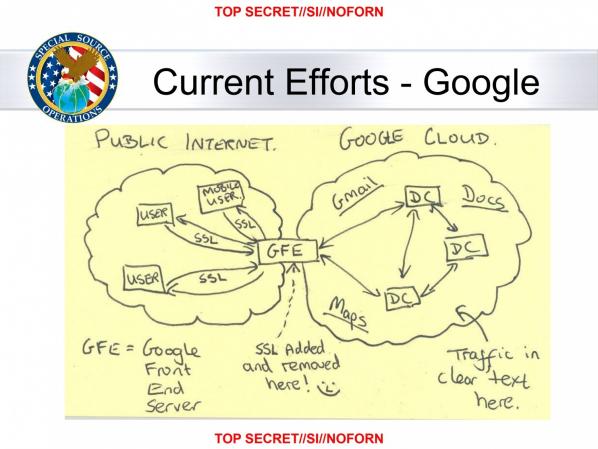
The above slide is from an NSA presentation on “Google Cloud Exploitation” from its MUSCULAR program. The sketch shows where the “Public Internet” meets the internal “Google Cloud” where user data resides. [4]
A legitimate concern for anyone wishing to read the contents of the leaked Snowden files, is that they will be spied upon as they do so. Evan Light has been working on finding a way around this problem, and at the Off-the-Cloud-Zone day event he presented his project Snowden Archive-in-a-Box. A stand-alone wifi network and web server that permits you to research all files leaked by Edward Snowden and subsequently published by the media. The purpose of the portable archive is to provide end-users with a secure off-line method to use its database without the threat of surveillance. Light says, usually the wifi network is open, but users do have the option to make their own wifi passwords and also choose their encryption standard.

Snowden Archive-in-a-Box is based on the PirateBox, originally created by David Darts who made his in order to distribute teaching materials to students without the hassle of email. It is based on a RaspberryPi 2 mini-computer and the Raspbian operating system. All the software is open-source and its most basic setup can run on one RaspberryPi. In his talk Light said that a more elaborate version would use high-quality battery packs and this adds power for autonomy, along with the wifi sniffer that is running on a secondary RaspberryPi and a flat-screen for playing back IP traffic. If you’re interested in building your own private, pirate Archive-in-a-Box, visit Light’s web site for instructions on how to.

Christoph Wachter’s and Mathias Jud’s work, directly engages with refugees and asylum seeker’s social situations, policies, and the migrant crisis. They’ve worked together on participatory community projects since 2000 and have received many awards. For instance, take a look at their digital communications tool qaul.net which is designed to counteract communication blackouts. It has been used successfully in Egypt, Burma, and Tibet, and works as an alternative to already existing government and corporate controlled communication pathways. But, it also offers vital help when large power outages occur, especially in areas in the world suffering from natural disasters. The term qaul is Arabic and means ‘opinion, say, talk or word’. Qaul is pronounced like the English word ‘call’.

It creates a redundant, open communication code where wireless-enabled computers and mobile devices can directly initiate a fresh, unrestricted and spontaneous network. This includes the enabling of Chat, twitter functions and movie streaming, independent of Internet and cellular networks. It is also accessible to a growing Open Source Community who can modify it freely.
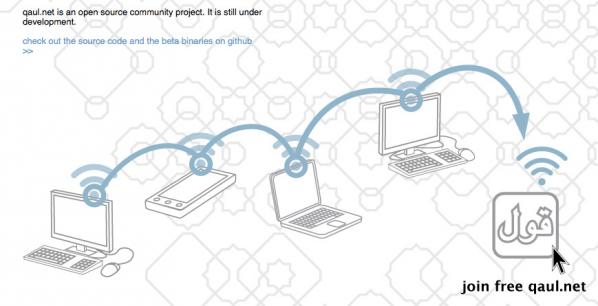
Wachter and Jud also discussed another project of theirs called “Can You Hear Me?”, a WLAN / WiFi mesh network with can antennas installed on the roofs of the Academy of Arts and the Swiss Embassy in Berlin, which was located in close proximity to NSA’s Secret Spy Hub. These makeshift antennas made of tin cans were obvious and visible for all to see. The Academy of Arts joined the project building a large antenna on the rooftop, situated exactly between the listening posts of the NSA and the GCHQ to enable people to directly address surveillance staff listening in. While installing the work they were observed in detail by a helicopter encircling overhead with a camera registering each and every move they made, and on the roof of the US Embassy, security officers patrolled.

“The antennas created an open and free Wi-Fi communication network in which anyone who wanted to would be able to participate using any Wi-Fi-enabled device without any hindrance, and be able to send messages to those listening on the frequencies that were being intercepted. Text messages, voice chat, file sharing — anything could be sent anonymously. And people did communicate. Over 15,000 messages were sent.” [5] (Jud 2015)
A the end of their presentation, they said that they will be implementing the same system at hotspots deployed in Greece by the end of the month. And I believe them. What I find refreshing with these two, is their can do attitude whilst dealing with political forces bigger than themselves. It also gives a positive message that anyone can get involved in these projects.
And then, it was the turn of the well known team at Dyne.org to discuss a project of theirs called Dowse, which is ‘The Privacy Hub for the Internet of Things’. They said (taking turns, there was about 5 of them) that the purpose of Dowse is to perceive and affect all devices in the local, networked sphere. As we push on into the age of the Internet of Things, in our homes everything will be linked up.
“Those bathroom scales and home thermostats already talk to our smartphones and in some cases think for themselves.” [6] (Nowak 2015)
As these ubiquitous computers communicate to each other even more, control over these multiple connections will be essential. We will need to know how to interact beyond the GUI interfaces and think about who has access to our private, common and public information. A whole load of extra information will be available without our consent.
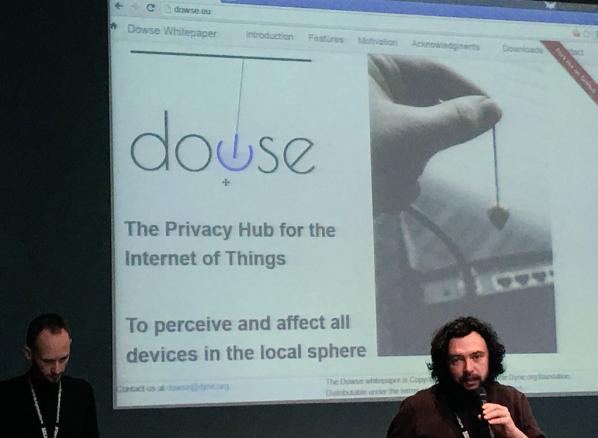
Dowse was conceived in 2014 as a proof of concept white paper by Denis Rojo aka Jaromil. Early contributors to the white paper and its drafting process includes: Hellekin O. Wolf, Anatole Shaw, Juergen Neumann, Patrick R McDonald, Federico Bonelli, Julian Oliver, Henk Buursen, Tom Demeyer, Mieke van Heesewijk, Floris Kleemans and Rob van Kranenburg. I downloaded the white paper and is definitely worth reading.
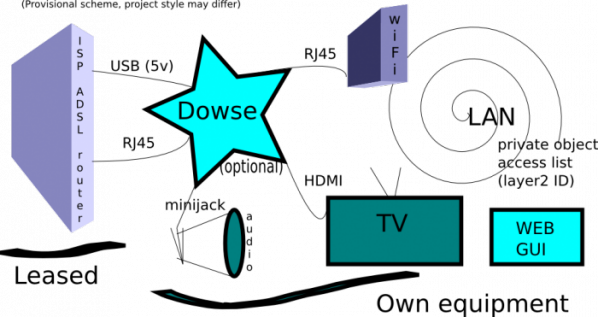
The Dowse project aims to abide to the principles stated in the Critical Engineers Manifesto, (2011). Near the very end of the talk they announced to the audience an open call for artists and techies everywhere to get involved and jump into the project to see what it can do. This is a good idea. If there is no community to make or break platforms, hardware and software, then there is a limited dialogue around the possibilties of what a facility realistically might achieve. Not just that, they want artists to make art out of it. I know there are some pretty clever tech-minded geeks out there, who will in no doubt take on the challenge. However, once those who are not so literate in the medium are able to exploit the project, it will surely fly. It’s going to be interesting, because if you look at the 3rd point in the Critical Engineers Manifesto, it says “The Critical Engineer deconstructs and incites suspicion of rich user experiences.” I’m thinking, that this number 3 element needs to treated with caution. If they really wish to open it up to a diverse user base, to engage with its potentialities, creatively and practically; thus, allow new forms of social emancipation to evolve as ‘freedom with others’. There needs to be an active intent to avoid a glass ceiling based on technical know-how. It’s a promising project and I intend to explore it myself and see what it can do and will invite other people within Furtherfield’s own online, networks to join in and play, break, and create.
Our final entry is the Sarantaporo Project which is situated in the North of Greece. A village in the mountains just west of Mount Olympus in Central Greece close to Thessaloniki, Macedonia and Larisa. The country has been in recession for over 6 years now, and many communities have had to create alternative ways of working with each other in order to survive the crisis. Over this troubling period, new forms of grass-roots coexistence, solidarity and innovation have evolved. The Sarantaporo Project is an impressive example of how people can come together and experiment in imaginative ways and exploit physical and digital networks.

Even before the economic crisis the region was already hit by poverty, and with the added pressures of imposed Austerity measures, life got even tougher. All the young were leaving and then migrating to the cities or abroad. Before the project in Sarantaporo, there was no Internet nor digitally connected networks for local people to use. This situation contributed to the digital divide and made it difficult to work in a contemporary society, when so many others in the world have been using technology to support their civic, academic and business for so many years already.
“In Greece, where unemployment reaches 30% in all ages and genders, and among the youth overpasses 50%, immediate solution for the “social issue” is more than urgent.’ [7] (Marmaras).
“Besides maintaining the network in a DIWO (Do It With Others) manner, and creating an atmosphere of cooperation among far-flung communities that were previously strangers, the Sarantaporo network is incorporating different groups of people into the community, like Farmer’s Cooperatives and techies. It is also creating an intergenerational space for learning.” [9] (Bezdommy 2016)
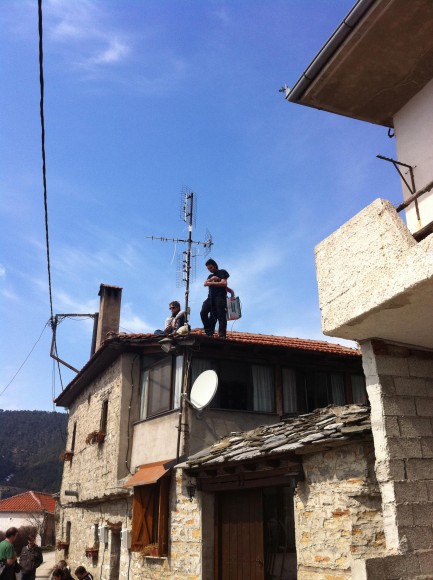
To resolve this issue a group of friends decided to deal with this problem by setting up a community D.I.Y wireless network to provide free internet access to 15 villages in the municipality of Elassona. “Sarantaporo.gr is an open source wireless mesh networking system that relies greatly on voluntary work both for its development and maintenance. Some volunteers are involved in the project by simply installing an antenna on their roof. Others, more actively engaged with the project, are responsible for sustaining the network by hosting meetings and answering technical questions.” [8] (Kalessi 2014) The audience was presented with snippets from a film made by the filmmaking collective Personal Cinema, about the project. It was made so the story of Sarantaporo’s DIY wireless network gets a wider reach, and that others are also inspired to do similar projects themselves.
These projects are dedicated to creating socially grounded and engaged alternatives to the proprietorial, networked frameworks that currently dominate our communication behaviours. These proprietorial systems, whether they are digital or physical are untrustworthy, and control us in ways that reflect their top-down demands but not our common needs. This reflects a wider conversation about who owns our social contexts, our conversations, our fields of practice, the structures we use, the land, the cables, our history, and so on.
Looking at the state of the planet right now you’d be forgiven for betting on a future not far from the director Neill Blomkamp’s vision in the sci-fi movie Elysium where, in the year 2159, humanity is sharply divided between two classes of people: the ultra-rich whom live aboard a luxurious space station called Elysium, and the rest who live a hardscrabble existence in Earth’s ruins. However, in the Off-the-Cloud-Zone talks we encountered an ecology of strategies to protect our own indegenous cultures from the crush of neo-liberalism, we felt part of a grounded movement discovering new conversations and new methodologies that may provide some protection against future colonisation. Perhaps there is a chance, we can build and rebuild stronger relations with each other, beyond: privilege, nation, status, gender, class, race, religion, and career.
The festival this year was less structured and more nuanced than usual. It gave conversation a greater role and a deeper social context, and opened up the process for the many to connect with the ideas being explored. The whole affair seemed to be slowed down and less caught up in the hyper-macho trappings of accelerationism. It seemed less neurotic and spending less effort to impress. I’m sure, next year, on it’s 30th anniversary, all will be sharp and amazing. However, I liked this less glossy, more messy version of Transmediale and I hope it manages to impress the wrong people again, and again.
London’s Permaculture Design Course – Spring Into Action! and Design 4 A.C.T.I.O.N (Active Community Transformation In Our Neighbourhoods) are a different kind of permaculture course – positive design for your life, your community and your world by empowering the genius inside all of us! The format is participatory and dynamic, using diverse visual, audio and kinesthetic learning methods such as group work, games, problem solving, discussion, observation, field trips, practical activities, lectures and slideshows during course sessions. This course will be hosted at The Furtherfield Commons in Finsbury Park, a new and exciting partnership project:
‘We believe that through creative and critical engagement with practices in art and technology people are inspired and enabled to become active co-creators of their cultures and societies.’
Led By: The course will be taught by Graham Burnett (Dip. Perm Des), Claire White (Dip. Perm Des), James Taylor (MSc. Human Ecology) and some great guest teachers.
Cost: We are pleased to announce that we are holding our course fees for another year £780 full cost, £580 – Individual, waged (income less than £25k), £380 concessions/low waged.
The booking form for the course is now live and we are accepting participants.Please note that this course is not organised by Spiralseed – all queries re. booking and accommodation should be made to the course organisers.
What Hope Looks Like After Hope (On Constructive Alienation) is an exhibition conceived by Alexandrian curator Bassam El Baroni as part of Ashkal Alwan’s international cultural forum, Home Works 7. Run by the Lebanese Association for Plastic Arts, Ashkal Alwan is a non-profit organization based in Beirut, Lebanon. The exhibition opened on November 12th and ran until the 10th of December 2015. Drawing from philosophical concepts revolving around the drowning of the contemporary human consciousness and free will, the show is an elaborate discussion of how we are coping with the decline of a future that used to be in our hands. Bassam El Baroni in union with the artists involved raise questions as to how we can mediate and engage with solutions for creating (or disintegrating) prospects of a more ‘hopeful’ future.
The omnipresence of our reliance on technology echoes throughout the large space with the persistent humming of numerous projectors utilised in the exhibition. A correlation is directly created between the open space and the idea of alienation, as the reverberating sound becomes the only contributing factor that disrupts the isolation of each work. What used to be an old furniture factory building was the host for considerations regarding the repercussions of the current world’s most celebrated yet paradoxical phenomena. Perceptions of technology are relentlessly conflicting as there is an inherent drive advocating that we may either perceive the phenomena as good or bad. However, it must be understood that technology cannot be subtracted from human social, political or economic life; today, the two coexist. What Hope Looks Like After Hope (On Constructive Alienation) is divided into sections that are devoted to facilitating each artist’s work and touching upon these separate ideas.
Curated to represent a hotel room, Leonardo Cremonini’s digitally reproduced paintings are coupled with Yuri Pattison’s video 1014 listed in the exhibition guide as “shot in Edward Snowden’s hotel room hideout”. In the format of a hotel room, the piece also involved a bed and two nightstands with lamps, along with Pattinson’s 1014 being looped on a large TV monitor opposite the installed bed. Hotel rooms are standardised, fixed and homogenous in every single way. Cremonini’s paintings are reproductions both in terms of their digital print format and in the context of the general hotel room, where each room has replicated decors. Considering the idea of standardisation, Pattinson’s video appears to be the inception of a paradox as the space is curated to represent a hotel room, whilst a video about a hotel room plays in the background – but this is not any hotel room, it is Edward Snowden’s hotel room.
Snowden’s outing of the NSA’s and Five Eyes’ global surveillance programs to the popular media was readily perceived as a public civil act as it revealed a huge breach of privacy for citizens worldwide. Closely linked to ideas of ubiquitous surveillance versus freedom and civic liberty, Pattinson’s video utters phrases such as ‘I am only just me, I am a passer-by’, ‘Life is so arduous’ and ‘I am too tired to love’. The camera pans throughout the room to expose translucent glass spaces whilst untagged maps are being graphed when the camera pans to the city-landscape outside the window. Pattinson’s video is a survey of a hotel room, metaphorically standing for transitory spaces that can lead to a certain, self-perpetuated superficiality. We are consumers of desires, trapped within the hotel room metaphor.
Desire is an element in need of a risk assessment, and according to Nelmarie du Preez, such a risk assessment can be measured through a set of computerised algorithms. Two performances are displayed on two screens facing each other, du Preez’s to stab and to rely, from her ‘Loops of Relation’ series – both jesting with risk. Thoroughly reminiscent of Abramović’s and Ulay’s The Other: Rest Energy, du Preez positions herself in a certain degree of danger. to rely features du Preez facing a machine with an extended bow and arrow as she holds the tip of the arrow. to stab features du Preez sitting on a table with her hand stretched as a programmed machine repeatedly performs a five finger fillet (FFF); a popular knife-game embedded into American culture as a popular pastime as featured in the movie Aliens where Sigourney Weaver realises that the character Bishop meticulously performing the FFF is an android. Comparable to Aliens and Rest Energy’s notion of unveiling the full potentiality of the body’s endurance and trust over emotions and nerves, du Preez’s reliance on the machine is inherently vital.
She is performing a trust exercise with her programmed piece of technology and promoting a delicate balance between trust and danger. However, the problem in her actions innately exists when considering the core of the AI’s function; a machine does not possess the same sentiments as Ulay did towards Abramovic. A machine owes no responsibility or emotion towards du Preez, and in some sense, the roles have been flipped. Where du Preez is the possessor and programmer of this machine, she is now inflicting herself as the target. She relinquishes herself as the master, challenging the notion of possessing selfhood and allowing her own free will to be diminished. The metaphor of the bow and arrow pits du Preez and the machine as equals; the tension represents the idea that both entities are needed in order for the piece to have significance. Simultaneously, the interplay between du Preez and the machine uncovers a subtle warning of our insentient confidence towards the inescapable technology; du Preez can only stop herself from being in danger if she pulls the plug.
In very close proximity to du Preez’s work and upholding the same ideals of technology contributing to human activities is Salemy’s The Artist is Hyperpresent. The work is a three-headed screen structure overrun by the artist’s own personal social media feeds. Of course, the immediate reaction of any millennial would be to attempt a ‘scroll down’ function on the screens only to be disappointed that the machine did not respond to the command. The Artist is Hyperpresent is an undeviating allegory of the structure wanting a ‘digital life’.
On the other hand, Katia Barrett’s Limiting Metaphors, Enabling Constraint is an interesting take on the self through what appears to be an interrogation or courtroom procedure of a crime. Two large projector screens hang in the middle of the room whilst switching between them, introducing an individual of uncertain sex with blonde hair. The over-the shoulder shot is utilised evidently in preserving the mystery of the individual and the case itself. Someone asks ‘Why are you following me?’ whilst it sounds as though the conversation is happening from the other side of a glass window. Several retorts such as ‘I don’t think he was the victim here’ and ‘I’m the last person, you don’t know how I feel’ are followed by more questions such as ‘Who is watching you?’
The protagonist cannot address the questions because there is a certain degree of perplexity surrounding not only the timing of the event, but also the very core of what took place. The video becomes an act of displacement, as there is ambivalent confusion in the idea of the self being mingled with objects separate from the body. The character’s present environment, sitting in a dark empty room, is ambiguous and in this way begins to evoke Andy Clark’s idea of ‘active externalism’.
Clark is a neuro-philosopher whose concept of active externalism is described in the exhibition guide as ‘a description of subjectivity in which he renders the active role of the environment in driving cognitive processes’. For Clark, ways of perceiving ourselves and those around us are increasingly experiential and dependent on our environment – a notion that extends to Thomas Metzinger’s metaphor of the ‘ego-tunnel,’ which in Metzinger’s book, The Ego Tunnel: The Science of the Mind and the Myth of the Self, refers to the experience of our own consciousness. He states that ‘conscious experience is like a tunnel’ and that ‘the content of our conscious experience is not only an internal construct but also an extremely selective way of representing information’. If in any case Metzinger’s claims that our ‘sensory organs are limited’ and that we are ‘unable to experience and introspectively recognise our self-models as models’ are even remotely true, then Barrett’s work closely relates. It raises questions of how we experience society – is it a conscious exertion or is it partly constructed by our surroundings? It is more commonly believed that we are solely responsible for constituting the meaning of things, but what if we’re not? What if we are limited beings? What if this finitude is a ramification of our unaware reliance on several advancements that were at their pinnacle within our lifetime?
Walid Sadek also explores this thought in his piece The Conversion of St. Paul. The installation is placed in two separate but identical square rooms at very close proximity to each other. Each room is fitted with an overhead projector displaying the inside of a VHS tape. Between the two rooms is a narrow corridor opening up to a larger but empty peripheral area. By standing between these two rooms and focusing your vision straight ahead, an entirely new image forms in the void ahead. In the exhibition guide, Sadek explains that ‘what could allow for the making of an openness in which living is possible even without the promise of a coming eruptive event’. In this sense, the act of looking straight ahead onto the devised new image can be perceived as looking into or towards the future. By creating an allegory of the ‘image-encounter’ (or visual illusion), he allows our mind to utilise aspects from two environments and claims the result as a speculative future and existence.
Speculative existence is also examined in Matthew Poole’s collaboration with Bassam El Baroni titled Société Phantome – two separate projections on the wall presenting what could be the commandments of the ‘new’ world. The poem itself is suggestive of explosive and fiery liturgy sung in religious hymns. It retorts phrases such as ‘We cannot decline’ ‘Our walls are without fervour. Our doors are without zeal’, and resonates Guy Debord’s Society of the Spectacle both in execution and impression. Just as the Society of the Spectacle frames itself as the manifesto of the Situationist movement in the 1960s, perhaps Société Phantome can be in this light too.
Debord’s Society of the Spectacle focuses on the ‘negation of life’ due to the ‘loss of quality’ because of the instant commodification that occurred during the rise of mass media. In this context, we may associate an evolved spectacle that has arisen from our passive unification with technology. Debord’s claims such as ‘Everything that was directly lived has receded into a representation’, and ‘The images detached from every aspect of life merge into a common stream in which the unity of life can no longer be recovered’ are intrinsically concurrent with the alleged futility by which the human dwells in the face of an ever rising technological contemporary society.
Amanda Beech’s Covenant Transport, Move or Die, vocalises a different dimension to What Hope Looks Like After Hope (On Constructive Alienation) – the abstract socio-politics of post-capitalist culture. Beech’s room was curated distinctly with bright green walls, two benches, fitted carpet and two screens; one facing you as you walk in and one to the left of the room. The video is the loudest in the entire exhibition and perhaps the most extravagant of all as it interplays with the concept of the ‘green-room’ where images are being superficially created. The video spits words such as ‘EFFICIENT’, ‘EFFECTIVE’, ‘VOTE’, ‘REPORT’ and titling the excerpts from the front screen as: ‘Round 1’, ‘Round 2’). Covenant Transport, Move or Die comments on the ‘psyche of Capitalism’ as the video’s intentionally unpolished feel adds a new rawness and immediacy to the exhibition’s concept, touching upon the politics of Accelerationism. If Debord’s Society of the Spectacle was the founding awareness of socio-capitalist consequence, then ‘Accelerationism’ is the current age’s pinnacle of consciousness. It comes as no surprise that Debord’s views are being progressed into a condition far more intricate as we ‘accelerate’ through our daily lives.
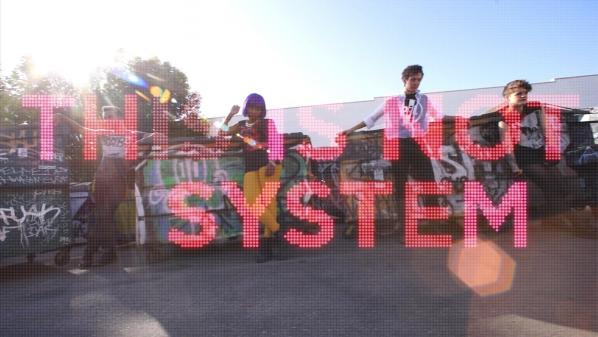
Accelerationism is defined in the book #accelerate, as ‘a political heresy: the insistence that the only radical political response to capitalism is not to protest, disrupt or critique, nor await its demise at the hands of its own contradictions, but to accelerate its uprooting, alienating, decoding, abstractive tendencies’. There are two potential paths to consider when taking into account our current world state (economically, socially, politically etc.). One path would be to embrace the fear of becoming a world of a politique du pire, expecting and expending the worst, and as a result relinquishing all hope. The second path would be to simply hope that capitalism would subside (or die, preferably) of its own internal contradictions. Nevertheless, neither of these choices undertaken, by left-wing or right-wing variants of Accelerationism, are perceived as helpful or realistic in combatting the situation. To the contrary, there must be a future-orientated realist philosophy as ‘extremist caricatures obstruct the consideration of a diverse set of ideas united in the claim of truly progressive political thought’. We are not at the end of the ‘world’ (as we know it) but at the very beginning of an interesting political experiment that is not as bleak as it appears. Such optimism was found during Patricia Reed’s lecture titled ‘Synthesis and Constructive Alienation’, as part of a lecture-series facilitated by Bassam El Baroni to complement the exhibition.
Reed’s lecture makes claims for our ‘social plasticity’ and ‘the need for constant redefinition in light of changing contexts’ revolving around ‘fanaticizing our downfall’. Her assertions opened up a considerably fiery debate at the end of her lecture as she questioned the notion of ‘inexistence’ as a non-being who plays no part in the reasoning of a system. Conclusively, her lecture ruptured the so-called Accelerationist dispute between idealism and realism whilst simultaneously uncovering the inconspicuous anomaly of attempting to guarantee the future when human nature is increasingly malleable.
Furthermore, Reed’s piece Volatile Prophecies was, I personally believe, the most captivating and meditative piece in the show. Placed in the furthest left corner of the exhibition space, Volatile Prophecies was displayed on a giant screen, showing an infinite amount of computer rendered and programmed floating coins moving through the screen in various directions and currents with a soundtrack intentionally (or unintentionally) following the flow of the coins.
The video-installation is described as pinpointing the economy ‘as a global architecture of human relations’. According to an excerpt from the exhibition guide, ‘financial engineers are our contemporary soothsayers and Volatile Prophesies is deploying some of their techniques’. Structures created by these ‘financial engineers’ have the possibility to allow or disallow limitless opportunities of relation, of function, and of structure therefore making them volatile. Floating exists when space becomes abstract, and where space is abstract, time could also be considered as abstract. As a result, the piece appears to be rejecting a harmony to a linear structure of economy and social relations.
https://youtube.com/watch?v=56fU3cho9X4
Parallel aesthetics can be found in Hisham Awad’s commissioned video named Untitled whose mise-en-scène is prodigious. Awad combines the archetype of Delleuze’s ‘time-image’ and applies it to an allegorical narrative. Tackling techniques such a ‘slippage’ and methods of diegetic and non-diegetic sound, his use of particles applied over a post-produced image, invites the viewer to receive it as a form of film essay, stated to be ‘thinking with and against Deleuze’. Awad’s inclusion in What Hope Looks Like After Hope (On Constructive Alienation) is an interesting addition. Through connecting the ‘Deleuzian’ thought to modalities of motivation and logic, Awad may be reconstructing the impulse of freedom, undeniably connected to the tussling against unrealistic expectations of our current socio-political (non) human condition.
Drawing from these unrealistic expectations, Martti Kalliala’s Exostead installation unearths a vital disparity between ‘idealistic’ and ‘utopian’. Exostead is an installation of constructed aluminium steps with various de-potted plants scattered and broken throughout all levels. It seems to take the shape of an island, or a sovereign ‘seastead’. The concept of a ‘seasted’ hopes to form a utopian civilisation drifting in solitude and untouched at sea. However, Kalliala’s Exostead does not seem to be advocating for a utopian state, but rather for the possibility of one if time and human beings were free from their surroundings.

‘Exo’ is Greek for ‘outside’ or ‘out of’ implying that the ‘seastead’ is a way to ‘get out’, but towards and away from what? Instead, should we not be problematized by the seasted and its unmediated future in solitude and sovereignty? Would such a place not be promoting or accelerating the problems faced by contemporary society if it happened to be inhabited by the wrong type of people? Where does the hope of a seastead begin to be probable and where would it end?
What Hopes Looks Like After Hope (On Constructive Alienation) tends to the elusiveness of a concept such as ‘hope’ as a kind of sine qua non in a world where human desires, actions and thoughts are passively governed by cognitive capitalism. (Constructive Alienation) as stated in the title’s parenthesis, finds itself in the anticipatory readiness of desiring to predict the future, not because it is precarious, but because it needs mending to a certain degree. In an age where post-capitalist economic and social organising is at its most glorious foothold, Bassam El Baroni indexes the finitude of the human condition. Yet, we could be in the middle of capitalism, instead of in a state of post-capitalism, and if it is as such, our anxieties for the future will only intensify. As a result, the exhibition does not supply the answers to hope. What it does provide however are the potential outcomes of the imminent contingency enveloping itself in front of our eyes, only to raise more questions as you exit the space.
All photos are courtesy of Bilal Jawiche.
(Brian William Rogers and Yasmine Dubois Ziai were also featured on the opening night however I was absent for their performance.)
Featured Image: Olia Lialina, My Boyfriend Came Back From The War, at MU. Photo Boudewijn Bollmann
Twenty years ago, in 1996, Russian artist Olia Lialina created My Boyfriend Came Back From The War (MBCBFTW). Using the story of a veteran’s girlfriend who has mixed feelings when he returns, the interactive Web narrative quickly became an iconic work that inspired many artists to create their own interpretations of it. At the moment two exhibitions at HEK in Basel and MU in Eidhoven, pay hommage to MBCBFTW, a tribute to a medium and a new approach to keeping history alive.
Participating artists
Inbal Shirin Anlen, Freya Birren (Jennifer Walshe), Vadim Epstein, Dragan Espenschied, JODI, Olia Lialina, Abe Linkoln, Guthrie Lonergan, Armin Medosch, Ignacio Nieto, Anna Russett, Tale of Tales a.k.a. Entropy8Zuper!, Mark Wirblich. With two new works by Constant Dullaart and Foundland (commissioned by MU).
Educated as a journalist and film critic, and curating experimental film programmes in Moscow, in the mid-1990s Olia Lialina quickly embraced the Web and started experimenting with its unique qualities. She made her first net art piece, My Boyfriend Came Back From The War in 1996. Four years later she set up the Last Real Net Art Museum – an initiative to oppose museums that were presenting the first ‘Internet art exhibitions’, and a place on the Web where she could collect and exhibit the projects that responded to MBCBFTW. Ten years after she made her first net artwork, in 2006, in their popular book New Media Art (Taschen) Mark Tribe and Reena Jana wrote about MBCFTW: ‘One indicator of the historical significance of Olia Lialina’s 1996 Net art project, My Boyfriend Came Back From the War, is the numerous times it has been appropriated and remixed by other New Media artists. (…) Perhaps it resonates with other artists because it is among the earliest works of New Media art to produce the kind of compelling and emotionally powerful experience that we have come to expect from older, more established media, particularly film.’
In the meantime, Lialina had moved on and in addition to her online art practice, wrote about new media, Digital Folklore, the vernacular Web, co-founded the Geocities Research Institute, and became an animated GIF model and a professor at Merz Academy in Stuttgart, whilst the ‘mini-drama in hypertext’ MBCBFTW continued to be of interest to many artists, curators and critics. For its fifteenth anniversary, The Creators Project described MBCBFTW as a ‘charmingly simple yet poignant work’, emphasising its importance for the history of net art and its longevity through its interpretations. At the moment, as Lialina tells me, the project is discussed on Twine – an open source tool for telling interactive, nonlinear stories – where people communicate with each other about this ‘early Twine’. It is therefore not surprising that 2016 starts with two anniversary exhibitions, opening almost at the same time but in different frames, of My Boyfriend Came Back From The War. online since 1996. In what follows I asked Olia Lialina to reflect on the lasting popularity of the work, her intentions for making it, and her ideas about ways to go forward with it.
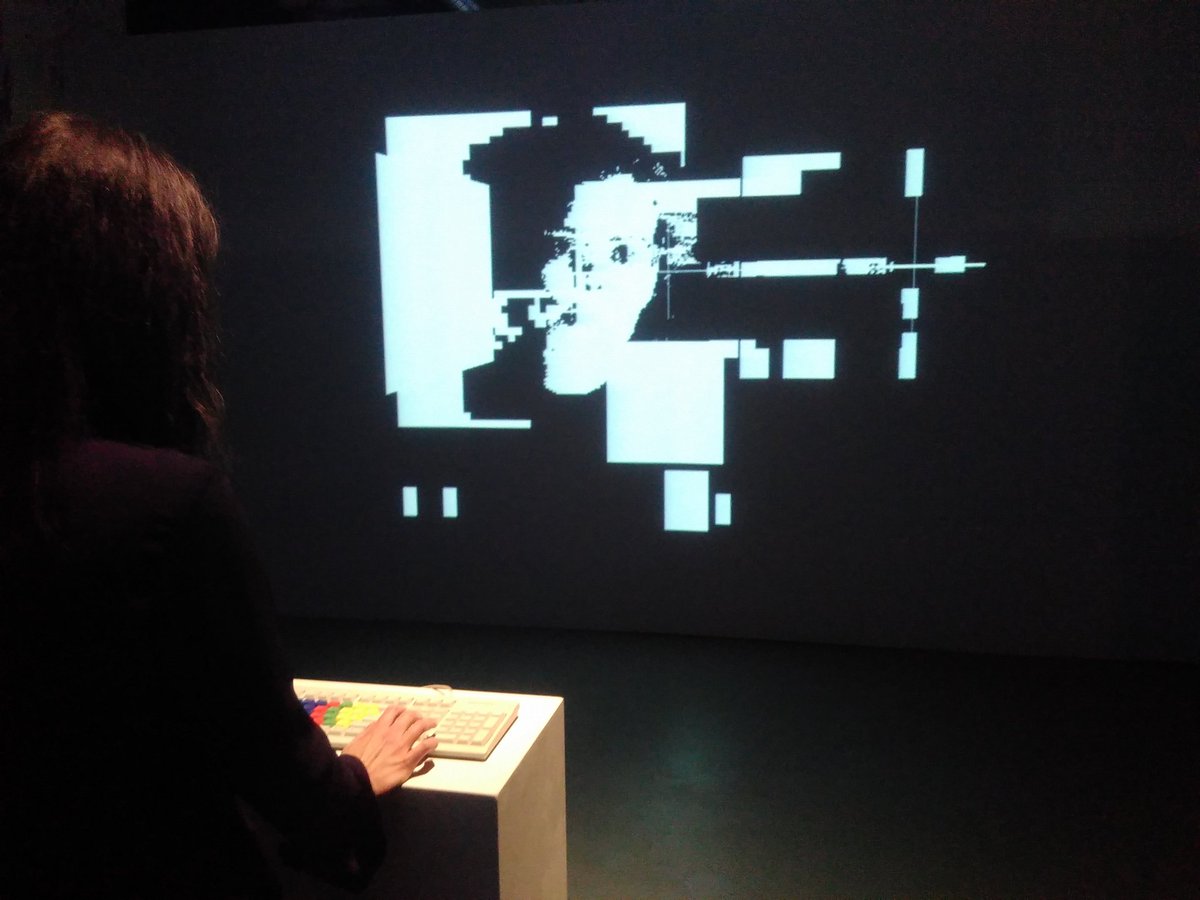
Can you tell me something about your background, how did you end up being an artist and a professor?
Twenty years ago I was absolutely happy with what I did: writing about films, curating film programmes, trying to make my own films. But as with many who embrace the World Wide Web (or were embraced by it) when it left academia in the mid-1990s – I was lucky to have a sudden new life and career. I became an artist only because MBCBFTW became a piece of net art. And I could become a professor four years later because of it 🙂
Could you briefly describe what the work is about?
In my teens I came up with the sentence ‘My boyfriend came back from the war, after dinner they left us alone.’
Мой парень вернулся с войны
И вот мы остались одни
And I always wanted to complete it as a poem, but the next lines never came. Years later, still confused about the phrase, I made it into an ambivalent dialogue with the browser: dividing it into frames. It was never about a war, but about a difficult conversation that doesn’t lead anywhere, and of course about the browser. I wanted to make something that people would spend time with and look at in the browser. This was also possible back then because the connection was much slower – so it took time to go through it. This has changed a lot now: HTML adapts to faster speeds, and most of us aren’t used to waiting – or loading time – anymore. You cannot click slowly if something is fast. That is also why we artificially slowed down the Internet connection for the exhibition.
When you started working on the Web, you came from a background in journalism and film. What sparked your interest in HTML frames?
They were very new at the time, not every browser supported them and you had to install the Netscape 3 version that had just been released – although in specifications I see now that it also worked in Netscape 2, but I remember that it didn’t back then. So, at the time it was cutting-edge technology – even though there was already a ‘I-hate-frames’ movement on the net, which I only discovered later. For me, it was interesting to see that a browser window could be divided up: you could assign coordinates, partition the screen and have multiple HTML documents within the same window. It sounds naive now, but at the time it was very empowering: I felt like a hacker, I could decide what it looked like and how it functioned.
And it reminded me of celluloid. I used to work with experimental 16mm film: cutting and pasting frames together. The editing was a way to work with the material, not just a concept. So, the connection between film and browser frames was something exciting. At the time I always talked about MBCBFTW as a net film. Someone more familiar with CD-ROM art, programming or interactive art would probably see it differently, but for me using frames inside the browser was a way to edit – it was a direct transition from being a filmmaker to a net artist.
While preparing the inventory table with all the elements of MBCBFW for the exhibition and reviewing the HTML code, I saw so many mistakes that I felt a bit ashamed. Mona Ulrich, one of my students, and I noticed warning after warning while reading through the code. So, it’s not only an old code, it is also very buggy, but despite all that it still works! That is the great thing about HTML, it has a very high tolerance, and it’s very forgiving if you write ‘bad’ code. It allows you to make mistakes: it’s not even that it was easy to learn, but rather that you didn’t really have to learn it at all.
In 2000 you started the Last Real Net Art Museum, as an initiative to collect and present interpretations of MBCBFTW. Could you explain the context and purpose of the Last Real Net Art Museum?
The Last Real Net Art Museum was a provocation to museums who in the late 1990s and early 2000s started making their own online net art exhibitions and collections – and at first they seemed to succeed, but it turned out they didn’t. In my title, ‘Real’ meant that an online collection should be based on links, because the net was about making links to people, information, etc. A good example was äda ’web designed by Vivian Selbo and curated by Benjamin Weil for the Walker Art Centre in Minneapolis between 1995 and 1998. Because this and other projects ended, another phenomenon started with museums like the Guggenheim, Tate and Whitney who acquired copies of Internet art and just kept these somewhere on a floppy or a CD, or showed the work in a pop-up window on their website – for me this was not real, and rather disrespectful of the artworks. And ‘Last’ meant that this previous method was completely disappearing.
The Last Real Net Art Museum was also sort of self-referential because of the First Real Net Art Gallery that I made in 1998, where I sold net art. It wasn’t a gallery selling offline art online, but people could buy online art for the first time. Since the First gallery was still well known in 2000, and to make the connection between the works, the second one became the Last…
Talking about museums and collections, was MBCBFTW ever acquired?
Yes, there is a copy at Telepolis, which was sold for what I thought back then was the amazing sum of 300 German Marks, but it was above all a statement. It’s also in a museum collection, MEIAC (http://www.meiac.es/) in Spain, and has been bought by a private collector, too. There is one more edition left. For this one I think it makes sense to sell the complete package: a computer, a monitor with the right resolution (800 x 600) a slowed-down server connection, an emulator with the old Netscape browser and all the other settings. Everything is emulated, simulated and fake, but the work is alive in its most precious state.
I have also adapted the work at certain times, for example around 2006 I added Google Ads to the website, not to become rich, but to reflect the Web of that time. Without the Ads it seemed old-fashioned and I wanted it to be alive and contemporary. About a year ago I removed them, because they made the work look outdated. It was interesting to see what Google thought suited the site – mostly non-governmental sites. Unfortunately, I never captured this version. That’s the irony – part of me is very much involved in preserving the Web, but when it’s about my own work, I change things immediately and forget how it was before.
The adaptations to the medium are striking in all the different interpretations. Seeing all the works next to each other illustrates a historical technical lineage of online practices: from HTML frames to blogs, games, video and VR. In a sense the Web seems almost to be little more than a constantly changing technical environment. Many have argued that this emphasis on medium specificity is one of the reasons why it took/is taking so long for net art to be taken seriously by the traditional art worlds. How do you view the relationship between the concept and the technical or formal aspects of the work?
For me the main concept and message of the work is the medium specificity. When thinking about the MBCBFTW exhibition we noticed now that it is also about the development of the Web. Yes, it has many technical translations. For example, the work by Auriea Harvey and Michaël Samyn (previously known as Entropy8Zuper!) was made in Flash; it was interactive and had sound, and for that time it was the most obvious software to use. Then Blog and Twitter versions were made, people kept changing it to other realities of the Web. What is interesting though is that the last interpretation, by Inbal Shirin Anlen, brought it back to its original classic HTML structure. The variations are some sort of tribute to the medium: these can range from manifestations of particular elements, to an aesthetic message or a personal statement in the medium.
I strongly believe that there is no contradiction between medium specificity and a mature conceptual message. For that reason I also think that it’s important to always emphasise how the work is made – it just being ‘art’ is not enough; I cannot forget about the Web or the net. In my article ‘Flat against the Wall’ of 2007, I wrote that while it is fine that Web art is part of the art market now, it would be a tragedy if we lost its connection to the Web. It can be a topic of contemporary art but it should stay part of the new media art scene.
For the exhibition you choose specific interpretations. What were your criteria for this selection?
We had to make a selection because some things have been lost. At the time of the Last Real Net Art Museum I thought it was important to just have the links to the works rather than showing copies of the works. So, unfortunately now some works are missing because nobody saved them, the Internet Archive didn’t capture them, and the artists (some of them students at the time) said they didn’t have their work anymore. For example, Web comics were popular at the beginning of the century and someone made a version in that style, which unfortunately didn’t survive either.
In the exhibition we left out works that had a similar structure, but almost all of them are featured in the book that was made for the show by House of Electronic Arts (HeK) in Basel, for example, Don Quichote Came Back From The War (2006) by santo_file group. But we also left some out of the exhibition that – perhaps surprisingly – were just too difficult to show such as the beautiful animated gif by Mike Konstantinov. He made this animated gif in 2000 and it was widely used for and known as a website banner. This work was a typical banner, 468 x 60 in size, and because it doesn’t use any of the images from the original work is also mimicked the cheesiness of banners. In the book it is printed frame-by-frame, but it’s difficult to show the banner phenomenon in an exhibition. We thought of several ways: put it on a random website, or against a black background, but in the end we decided not to present it at all. It just didn’t work.
Another example that isn’t included in the exhibition is Roman Leibov’s work. Leibov is the unofficial father of the Russian Internet. In the mid-1990s the Web in Russia had a strong literary tradition, it was all about games with words and meaningful and innovative hypertexts, including of course many references to Russian literature. I made MBCBFTW in English to intentionally distance myself from this tradition. I wanted to create something very formal because I’m very interested in the structures of the browser, the frames, etc. Had I made it in Russian it would have ended up in a different culture. At the time it was a massive effort, because English wasn’t my language. Then I asked Roman Leibov to make a text version and post it on the Russian Internet, which he did. He took every frame and described it like a film critic, and it ends with a monologue, making it into a piece of literature.
How do you see this type of approach now? To me at times it seems there is much less experimentation with templates or in the browser.
Yes, it’s more difficult to be curious now. The browser is still generous, you can open the source code and look at it, but it’s very complicated to change the code, if you can do it at all. The gap between people looking at and those making the pages has become enormous now. At the time it was easy to copy and modify other people’s pages, but now it is much more difficult to do this.
In this sense, perhaps, Blingee is my favourite place to go at the moment. It is a creative community where people fulfil their wish to make something themselves, where they can construct something from other people’s material. It isn’t because they can’t afford Photoshop, it’s about finding things made by others and reusing them such that they become completely different, and also that those layers can be made visible again, showing the elements that have been used. All the layers in the images have value and they are there to be admired. You can also see the tricks people use to fool or misuse the system. Unfortunately, there isn’t a Blingee version of MBCBFTW yet.
What I like about the work from an historical point of view that it consists of two types of archives: the table with all the information and components that are necessary to reconstruct the work, and the living archive of different people’s interpretations. Which method do you prefer?
The archive is an interesting part. MBCBFTW consists of many files, yet it is only 72 KB in size, which is smaller than a small image today. In the early 2000s I wanted to write about the life of a work of art, its making, what is important to keep and its preservation, even though I didn’t think it was necessary for net art. Now I see that it does make sense to write down all these details, so Mona Ulrich and I updated the old table for the exhibition. The table shows all the files, their sizes and which one is used in what frame. Even if someone has never seen the work, it could be reconstructed by following the information on the table. Maybe someone should try it sometime.
However, thinking about the future of the work, I prefer the interpretative approaches, because they are closer to my way of working. I’m also happy, and proud, that people take it as a structure and build something else out of it. I also think it’s interesting to see to what extent it can still be recognised as being an interpretation of MBCFTW, what are those elements? For example, Ignacio Nieto made a tribute for the Chilean soldiers who died in the mountains, it’s his story, and he merely used the same frame structure, but he asked me whether he could make and show the work. It is a bit strange of course, because I don’t have a patent for the frames, yet the specific use of the frames is one of the work’s main characteristics. I also noticed that most people keep the left frame intact and the frames to the right proportionally become smaller. Perhaps it’s similar to the golden ratio in design, but then for frames. A final characteristic is that all the interpretations always end with nothing, with black frames.
The exhibitions My Boyfriend Came Back From The War, online since 1996 are on view till 20 March 2016 at MU in Eindhoven (NL) and HEK in Basel (CH).
Venue: The Photographers’ Gallery, London
Links: http://thephotographersgallery.org.uk/furtherfield-in-residence
What do we find when we search our minds and the web for images of money and finance?
Coins and banknotes, trading floors with angry men shouting into phones, skyscrapers and stock charts.
The financial sector remains alienating and opaque to many people. We often struggle to think about how it works and how money moves. Making the invisible world of global finance visible and accessible is an urgent task and there are now many projects that are attempting to do just that.
Join us at The Photographers’ Gallery to build the ‘Activist Bloomberg terminal’ and to contribute to a mood board of future money.
Get involved in a weekend of image play, jargon-busting discussion, hacking and hands-on-exercises, to find out how we might unveil the financial sector. Together we will get involved with activities from open data mapping and visualisation, photography to computer games and digital art installation pieces to explore how money might be accurately represented in an era of digital payment via offshore tax havens.
This is part of Furtherfield’s Art Data Money programme of art shows labs and debates to build a commons for arts in the network age.

The Bloomberg Terminal is an expensive system that major banks use to get raw data and financial information. The Terminal is out of reach to most ordinary people, but can we create an open-source and open-access alternative Bloomberg to collect, distribute and visualise critical data on high finance? Let’s try!
Saturday 10.30 – 11.30: Brett Scott provides a recap of the first lab*
Open to all, an excellent introduction to the weekend activities.
Saturday 11.30 – 18:00 & Sunday 11:00 – 13:00: Discussions, guided group research, exercises and hands-on activities to familiarise yourself with finance and to build an ‘activist Bloomberg terminal’.
+ Read more about the first lab ‘Building the Activist Bloomberg to demystify High Finance’

What do we find when we search our minds (or the web) for images of money and finance?
And does it matter if we don’t like what we find? We think it does. We assert that money is an emotional, irrational and mysterious medium of networked trust and that the more we can reclaim its images and associations for communal play and circulation the more likely we are to shape it to our interests. That’s why we are building a new mood board for future money.
Saturday 12:00 – 13:00: introduction to the image of money
Talk – Brett Scott (LSFA) introduces the topic with a broad sweep history of money from the primordial swamp to High Frequency Trading
Saturday 13.00 – 17.00: Money mood board workshop
Participants are invited to drop in and take a series of challenges to make, remix and reappropriate photographs – going out onto the streets, searching, interpreting and tagging photographs from some great digital archives and the World Wide Web to create a new image bank for money past, present and future – online and on the walls of The Photographers Gallery
Sunday 11.00 – 13.00: Money mood board workshop continued
Sunday 14.00 – 17.00: Sunday Workshop – Money Masks
Furtherfield take over our regular drop-in workshop for all ages. Visitors are invited to imagine the main players in the future of money and finance: mysterious, glamorous, fierce or ethereal, human or machine. Download, print, collage and assemble masks for a carnival of characters in the future of money.
Reclaim money for the good of us all, and have fun doing it, join us for a weekend.
All events are included with exhibition day pass charge, no booking necessary
Featured Image: Black Shoals: Dark Matter’, Joshua Portway, Lise Autogena, Big Bang Data.
Big Bang Data is a major travelling exhibition currently set within London’s Somerset House. That a large institution is presenting a journey via data capture through ‘selfies, surveillance and infographics’ is in itself an interesting patchwork of intent and realisation. The aim of the exhibition is to ‘demystify data’. This is a grand, summative and in actuality slightly awkward claim which, in my view, encapsulates the character of an interesting, textured exhibition in an unintentionally astute way.
As Big Bang Data is dedicated to revealing data comprehensively through its various architectures and iterations, it makes sense for the underrepresented materiality of information to have prominence early on. This materiality, perhaps inevitably, was compromised in the gallery space. Entering the first room brings you face to face with Timo Arnall’s Internet Machine, which takes the form of multiscreen video documentation of not just the machines, but also the architecture, which supports mobile telephony.

I would have loved to have experienced the spaces shown more intimately and walked around one of these structures; the installation was illuminating but I was still most certainly watching at a remove. This initial interplay of removal and involvement is central to the way we experience data. How can people begin to understand something which exists as multiple codes and flows, on a scale and at a speed which is not concerned with making itself understood by humans? What form could an understanding of data possibly take? When learning about something this far from our grasp, it seems that ‘understanding’ must be replaced by ‘awareness’. Rather than seeking one answer via one route the visitor to Big Bang Data has to build an impression, obviously subjective and subject to change.
In its quest to expose and explain data’s social and cultural uses, it presents a fairly overwhelming amount of information. It is interesting to walk through the space thinking about how this information has been channeled by each specific project. Some representations, such as Owen Mundy’s ‘I Know Where Your Cat Lives’, link distant people and spaces via connected points, while others such as Phillip Adrian’s ‘One Second’ capture in great detail one specific point in time and space.
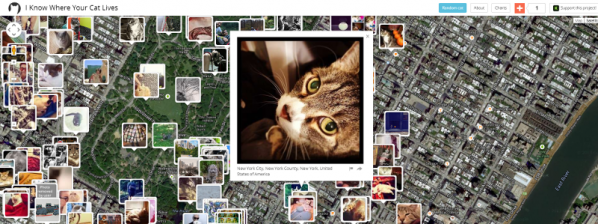
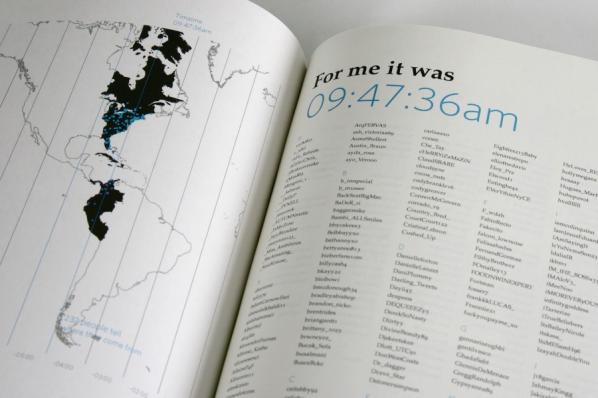
Julian Oliver’s ‘Transparency Grenade’ brings together graphical, console and physical representations of data to offer a transportable means of leaking information as a response to impenetrable governing systems. Each of the works on display demonstrates a negotiation between temporality, materiality and spatiality, and often one is sidelined in favour of the other. Again, considering the exhibition in this way is also to consider the world of data in all its contrariness.
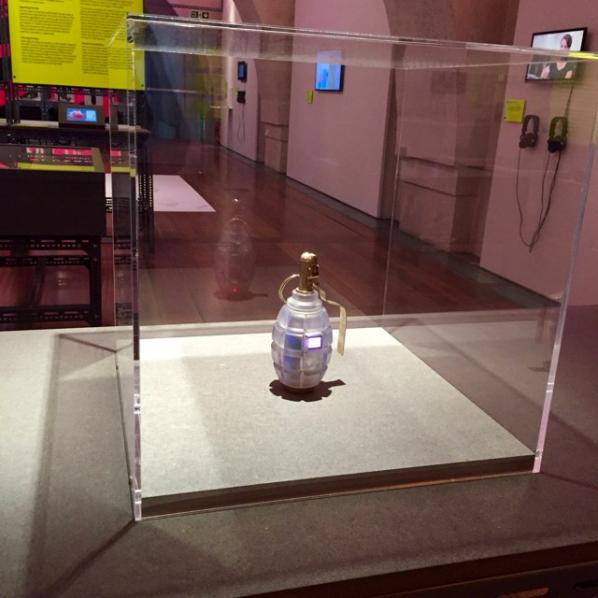
Data manifests itself at the same time locally and globally. As well as addressing specificity, the projects shown in Big Bang Data dwell repeatedly on scale. Works such as Tejka’s ‘London Data Streams’ and Nicholas Felton’s ‘Annual Reports’ pit scales against each other to cast light on the filters through which data is processed.
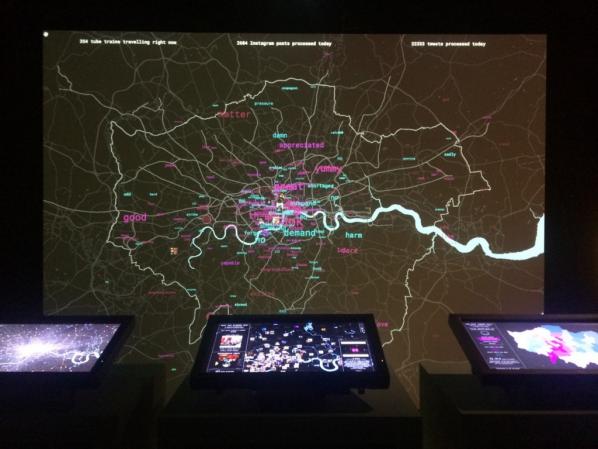
Ingo Günther’s ‘World Processor’ and Forensic Architecture’s ‘Liquid Traces: The Left-To-Die Boat Case’ are examples of resonant, atypical data visualisations which mutate familiar imagery and present alternative summaries of events. The section entitled ‘Data For The Common Good’ shows some of the ways data is being actively used in society to empower citizens with works such as Safecast’s ‘bGeigie Nano’ and IF’s ‘Data Licenses’, while a series of video interviews with journalists and other professionals working with data illuminate the processes through which information becomes communication.

The previously mentioned tension between object and their presentation recurs at various points throughout the exhibition, a great example being the array of undersea telephone cables, presented in cases of wood and glass which could have been magpied from a display of historical artifacts (each cable segment has a number next to it which corresponds to a factual description). It felt strange not being able to touch them. A work which I felt fully occupied, and knowingly played with, its surroundings was Ellie Harrison’s vending machine, which sits unassumingly in the gift shop; its secret is that when search terms connected to the recession make the headlines, free snacks are dispensed. Its presence in a exhibition on data in a gallery space felt appropriate.

Big Bang Data, which runs alongside a programme of events and has previously been exhibited at CCCB in Barcelona, comes at a moment where large organisations are more frequently bringing concepts such as surveillance, open source and free software into public spaces. There is a great need to bring the concepts and processes surrounding data more wholly into the public eye, and this exhibition strikes me as, overall, a big step in a good direction. It makes real and challenging efforts to bring together world-spanning processes, complex concepts and extremely diverse content into an exhibition space. The task of the exhibition’s curatorial and production teams must have been difficult.
Of course the challenges they faced have been dealt with before many times in many ways, and of course the practical decision-making involved in producing an exhibition invariably creates tension points. The reason I’ve dwelt on the problems of the organisers here is that the tensions evidenced within the space at Somerset House say much not just about the response of the publicly funded arts to data but also about the nature of data itself. The exhibition turns into at times a museum, a bedroom, a classroom, an information point, a scruffy new gallery space and a state of the art new media space. In bringing together the story of data the exhibition also brings together the story of representation in space more generally.
In writing about Big Bang Data I have had to choose to highlight certain works and not others. Your interpretation will be entirely different from mine, which is as it should be where data and cultural inclusion is concerned. What’s important is that the exhibition’s prominence and texture opens up conversation and critique. The exhibition is detailed, procedural and expansive. It is also alive with contrariness, generality and awkwardness. Perhaps one of the great things about the show is that these qualities are left to jostle for space. For me, reading this exhibition as a performative event was useful; others may leave Somerset House with an entirely different view having taken an entirely different route. This is inevitable where data is concerned – learning is incremental and procedural, but not traditionally linear.
Features Image: “Dead Copyright” installation view, 2015
Antonio Roberts is a digital artist based in Birmingham. In 2011 he has completed his Masters level studies in Digital Arts in Performance at Birmingham City University. His artwork focuses on the errors and glitches generated by digital technology. An underlying theme of his work is open source software and collaborative practices. His video work has been screened in Chicago, Illinois, at GLI.TC/H, Notacon in Cleaveland, Ohio, and Newcastle Borough Museum and Art Gallery, amongst other places.
In October 2015 he opened his first solo exhibition, “Permission Taken“, at Birmingham Open Media and in these weeks is taking part to “Jerwood Encounters: Common Property” (15th January – 21st February 2016, Jerwood Visual Arts), a group show curated by Hannah Pierce focused on the limits of Copyright when it’s about visual arts, with two projects: the installation “Transformative Use” and a collection of four works, “I Disappear”, “Blurred Lines”, “My Sweet Lord” and “Ice Ice Baby”.
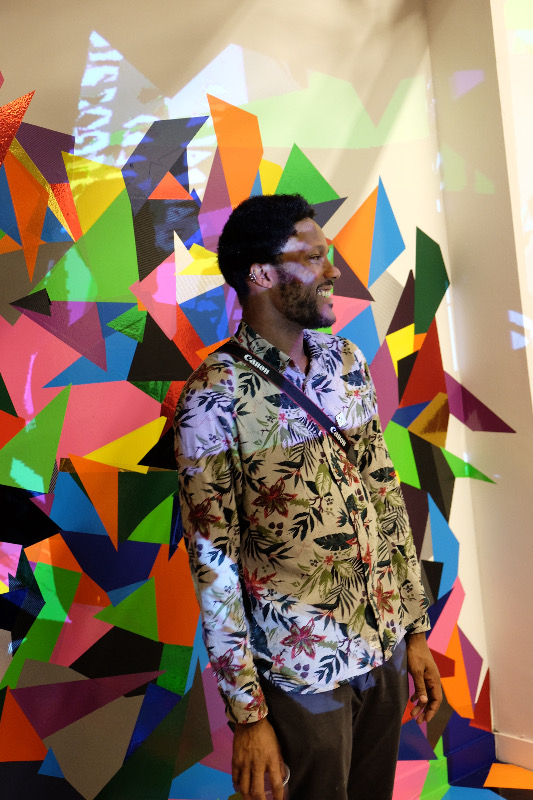
Filippo Lorenzin: You’ve been always interested in how corporate and industrial logics affect daily life and art. How did you get interested in these questions?
Antonio Roberts: It’s a by-product of my interest in open source software and free culture, something which I’ve been interested in from as early as 2002 but only started taking seriously around 2007. One of the main motivators of this was my reaction to Adobe Photoshop and its influence on creative practices. My experience of studying Multimedia Graphics – and I’m sure the same can be said for Graphic Design, Illustration and any creative practice – was that it seemed more like an exercise in how to use Adobe products, not how to be creative with tools. It felt like Adobe software had gone from being one of the many tools for creating art to the art in itself. This corporate sponsorship of course has many implications for how we create and disseminate art. It poses restrictions and dictates who and who cannot create art.

FL: Copyright issues are one of the main focuses of your research and this fascinates me because of your age. You (as me, by the way) have experienced probably the most troublesome period for Copyright systems, with the wide spread of p2p networking and remixing approaches to cultural industry products. What do you think?
AR: I’m inclined to agree. I’ve had access to the internet since I was around 14 years old and in that time I’ve seen the internet and culture as a whole change drastically. For me the rise and fall of Napster, spearheaded by Metallica’s very public outcry against it, signalled the beginning of the end of the free internet that I had only known for not even a year.
Around that time Digital Rights Management (DRM) became a hot topic. The entertainment industry saw it (and suing everyone) as the only way to protect their property and so kept bundling DRM with their products, which often at times resulted in a broken experience for the user. One example that springs to mind was the attempt to make CDs unreadable by computers (and so prevent ripping), by adding in corrupted data at the beginning of CD. Whilst it did temporarily stop people to using it on computers – you could simply use a marker pen to circumvent it – it also prevented some CD players from using the CD and in general was obtrusive. This cat and mouse game is still going on to the point where simply attempting to bypass DRM to watch/listen to something that you have purchased, can be an illegal act.
As mentioned before, It wasn’t until around 2007 that I began to reconsider how Copyright affected my work. By this time I saw that there was more weight being pushed behind open source software, free culture and things like the Creative Commons licences, and so I started to get involved myself. The first stage was ditching all proprietary software (which I did in 2009) and then licensing my work under Creative Commons licences.

FL: “Jerwood Encounters: Common Property”, curated by Hannah Pierce, is a group show that seeks to investigate the new borders of Copyright, especially in regard of art. How would you define the state of these questions in UK?
AR: I think Copyright as a whole is in a terrible state. As Cory Doctorow suggests in the exhibition programme (which is in itself an excerpt from his book “Information Doesn’t want to be Free”) Copyright as we know it isn’t written for artists or any individual. Its verbose terms and complexities cannot be understood and are probably not even read by most of us. They are written for other lawyers. If, in order to go about our creative business, we are expected to read and understand the terms and conditions and law – it is estimated that it would take 76 days to read all of the Ts and Cs of websites we use – what time do we have to be creative?
FL: What’s your point of view, from your position as an artist?
AR: I think Copyright is a mess because it tries to dictate how we should be creative. Creativity is free-flowing. Copyright, and its cousins patents and trademarks, justify their existence by saying that these restrictions encourage innovative new ideas but what they do is just stop us.

FL: “Dead Copyright” reminds me some reflections by Walter Benjamin on the shock of the city, about how advertising assaults our senses 24/7 with louder and louder messages – until it reaches a state of entropy. At this stage the message isn’t actually more important than the media itself, quoting Marshall McLuhan, and all the brands create a single, colourful ambient. How much this reality has been voluntarily planned by corporations, in your own opinion?
AR: I think it’s all completely planned. The more pervasive the advertising becomes the more we accept it as part of our every day life and culture. On the other side this does mean that they have to try ever more invasive methods to get our attention. Think about the uproar over the Coca Cola van at Christmas, or Cadbury’s at Easter. They have usurped the original holidays and are more important.
FL: The reduction of brands to colorful simple shapes created something that visually reminds some of op art works, a movement that experimented with visual perceptions and that has been an important inspiration for fashion and design. I was just wondering what you think of this similarity: is there any real connection between your work and those works?
AR: Yes, certainly and this comes through with my use of glitch art techniques. In glitch art we’re often trying to find signal in the noise, and I find that many successful glitch art works (however you define successful) have some resemblance to the original yet are transformed and destroyed in way.
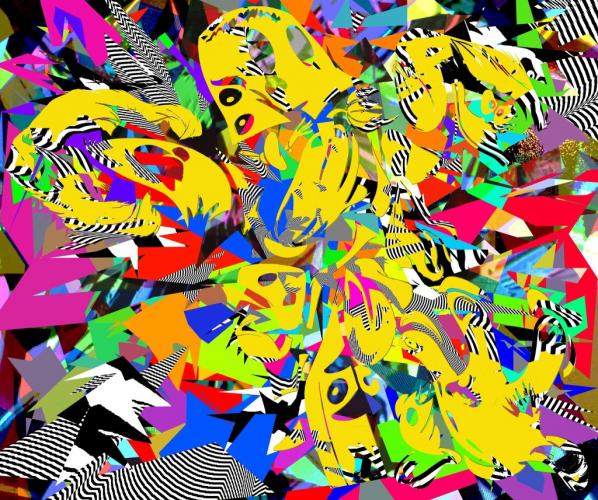
FL: With “Transformative Use” you use shapes that recall not just brands, but a wider imagery. It’s as if you’re focusing on other targets: can I ask you how did you get interested in this new research?
AR: I recalled all that I had learnt during my residency at University of Birmingham and during the CopyrightX course. From this I paid particular focus to the Sonny Bono act from 1998. This effectively extended the Copyright terms so that it won’t be until 2023 until works from 1923 begin to enter the Public Domain. This act is sometimes called the Mickey Mouse Protection Act, which led me to use them as a focus point for the work. Mickey Mouse should, by now, be in the Public Domain but they’ve fought to stop this in order to “protect” their brand.
People in favour of long or perpetual Copyright terms usually point to it allowing artists to reap the benefits of creating work. In truth, however, only a very small percentage of works made will be profitable in the future. To put it another way, how many books published today will see reprints? I don’t have any official statistics, but I know it would be a small percentage. So, extended Copyright terms only really benefit the small percentage of artists or publishers, whilst harming everyone else.
FL: What does it mean to deal with corporate imagery within such a chaotic and in a somewhat charming ambience? I mean, what remains a logo or a character when it gets lost within this borderless blob? Are the corporations losing their borders too, maybe?
AR: Yes.
FL: As discussed before, “Transformative Use” has been inspired by two previous projects: do you think that in future you’ll make a work that will update for the fourth time these reflections of yours?
AR: Most certainly yes. “Permission Taken” will be having an iteration at the University of Birmingham in March 2016 and will feature new and existing work. Aside from this I will continue to work with found materials but with a more explicit intention to provoke discussion around Copyright.
Featured image: The facade of Kunstquartier Bethanien. Image by Nadine Nelken.
After a full year of events focusing on several topics, from drones to surveillance, cyberfeminism to hacktivism, or even the famous Technoviking and a hot debate on the politics of the Porntubes, the Disruption Network Lab wraps up 2015 with its event STUNTS, focusing on political stunts, interventions, pranks and viralities. It was a year of great success for the DNL and proof of that was a full house, in the middle of a cold Berlin winter, full of people eager to take part of this last gathering on art research, hacktivism and disruption.
Just at the entrance, in the castle-like facade of Kunstquartier Bethanien, the Free Chelsea Manning Initiative projected a video including phrases of support, denouncing the system that violently charges against all the whistleblowers who bravely stand against state-crime. Chelsea Manning, sentenced in August 2013 to 35-years of imprisonment, turned 28 years old on the 17th December. The initiative took the occasion to celebrate her anniversary but also to remind us of her cause and of how vulnerable whistleblowers are under the purview of “justice”.

Peter Sunde, one of the founders of Peter Bay, has recently given an interview stating “I have given up” when asked about the current state of free and open internet. The pessimistic tone that might loom among hacktivism has its reasons. With a growing and raging state surveillance, invigorated politics of fear veiled as anti-terrorism propaganda, or the alienating neoliberal order, the seemingly scarce possibilities to fight back can be easily overtaken by a sense of hopelessness. Yet, the proposal of STUNTS claims the possibility of new futures; suggesting that new artistic militancies and political subversions of neoliberal networked digital technologies, hoping to provide a glimpse of another world. What can be done? There’s still a lot to be done.

The opening keynote was reserved to John Law, original member of the Suicide Club and Cacophony Society, and one of the initiators of the Burning Man Festival, who gave an inspiring speech condensing 40 years of disruptive movements in the city of San Francisco. Law highlighted how important it was to live in San Francisco, a well-known refuge for many weirdos, hippies and punks, and how the city served as fertile ground for the foundation of many movements of disruption, such as the Suicide Club or the Cacophony Society.
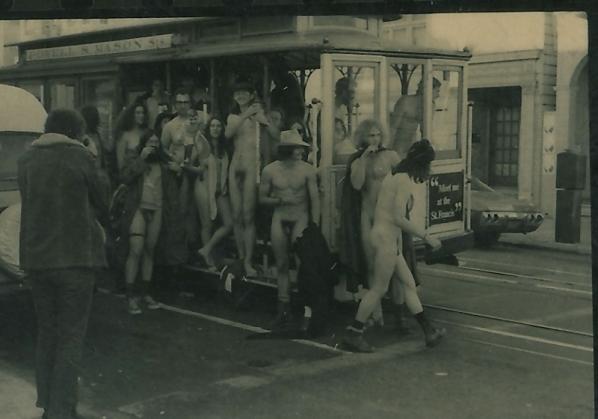
The Suicide Club, born from a course at the Free School Movement (also known as Communiversity) in the late 70s, was one of the pioneers with its events of urban exploration, street theatre and pranks. For several years, its members engendered actions of occupation and appropriation of public spaces, aiming to subvert the order of these spaces and highjack the authorities. Later on, some of its members founded the Cacophony Society which followed the same footsteps, creating social experiments and stunts, which according to Law didn’t necessarily mention being political but instead playful acts of liberation from the norm. Yet, in an age of overwhelming neoliberal labour exploitation, we can wonder if having fun among the working class isn’t already a political act. As Law said, “the events were illegal but not immoral” reminding everyone that in ethics and politics of disruption, right and wrong should never be defined by law. It seems that disruption is intrinsically political in the sense it questions the ruling order while also being an emancipatory act of dissidence.
PANEL: STUNTS & DUMPS – THE MAKING OF A VIRAL CAUSE

The panel, moderated by Ruth Catlow, one of the founders of Furtherfield, included a group of four hacktivists and disruptors, two of whom claimed to have once been Luther Blissett, an open-pseudonym used by several artists and activists as an hoax who has taken credit and responsibility over several stunts and pranks over the past 20 years. Following the thread of adopting an emancipatory praxis in the demand for privacy, M.C.McGrath presents the Transparency Toolkit. Motivated to refuse of data collection and the brute quantification that intelligence and corporations enforce as an interpretative lens for evaluating people’s lives, with this toolkit McGrath intends to facilitate the access to a database that allows journalists and civilians to surveil the surveyors. Providing easy access to personal data of the intelligence community, he gives intelligence a taste of its own poison. In response to the predictive justice portrayed by nowadays algorithmic supremacy, the Transparency Toolkit disturbs the power asymmetry while possibly enabling for even some form of critical mob justice.

Andrea Natella, creative director of guerrigliamarketing.it and KOOK Artgency, seeks for justice by creating elaborate hoaxes that corrupt corporate advertisement. Hoaxes such as the fake air company Ryanfair which claimed to “welcome aboard refugees” under the Geneva Convention, enabling refugees to fly without a visa. The ingenious mockery resulted in a flamed response from the ‘real’ company debunking the advertisement while at the same time it has received a great attention from the media, resulting in a broader public discussion on the refugee situation. Once again, Natella presents us with the power of disruption by taking advantage of tools used by the prevailing order.

The undergraduate in Computer Sciences Mustafa Al-Bassam has gained notoriety for being a part of LulzSec, a computer hacking group responsible a number of high profile attacks, resulting in being legally banned from the Internet for two years. From an early age Mustafa focused his time in the creation of tools to unmask the tenacious mechanisms of domination. From ironically proving the negative correlation between tests scores and the amount of assigned homework to denouncing violations of online privacy and security perpetrated by state agencies such as the FBI, Mustafa has been a main character in the defence of human rights in the post-digital era.
To close the panel, Jean Peters, co-founder of the Peng! collective, shifts the perspective of the debate. What if instead of blaming or attacking members of intelligence we could provide them the tools to liberate them from their own institutions? Recognising that within the intelligence community resides a great number of whistleblowers, Intelexit, which started as a hoax, is now an initiative that helps people leave the secret service and build a new life. Aimed specially at members of agencies such as CGHQ or NSA, Intelexit offers safe and encrypted channels of communication through which intelligence members can get access to legal and moral support. Without the intention of dismissing responsibility of these members, claiming some banality of evil, by emancipating intelligence members Intelexit conceives another possibility to disrupt the system from within.
CELEBRATING AT SPEKTRUM

With an incredible array of playfully disruptive tools and practices, the ending tone of the panel is of hope and optimism. Maybe this is the kind of optimism that inspired Chuck Palahniuk into writing the Fight Club, clearly influenced by the Cacophony Society of which he was a member. Optimistic disruption seems to pave way to new worlds of possibilities, into a new future envisioned with the help of DNL.
To close STUNTS in an even more optimistic way, the celebration of a year of DNL was at SPEKTRUM, another outstanding initiative in Berlin and another example of success. After less than a year of activity, SPEKTRUM, an open space that aims to link art and science, has already gathered a solid reputation in the field along with a trustee community of followers and participants. While we cross fingers for another year of funding for DNL, SPEKTRUM will continue to offer a rich program of concerts, performances, installations and debates.
Last Review – PORNTUBES: Reveals All @Disruption Network Lab, Berlin. By Pedro Marum, 2015
http://furtherfield.org/features/porntubes-reveals-all-disruption-network-lab-berlin
A discussion event with presentation and film screening. (free lunch)
Interruptions is a new research project by The Bad Vibes Club commissioned by Field Broadcast. Interruptions will present a new history of interruption as an artistic practice, focusing on British artists’ film, video, moving image and digital art.
Join The Bad Vibes Club (Sam Mercer and Matthew de Kersaint Giraudeau) for an afternoon of presentations, discussions and films about interruption and its relationship to art practice and contemporary culture.
Sam and Matt will begin by presenting the I nterruptions project. This will be followed by an open discussion of interruptions in response to the project, with a vegetarian lunch provided by The Bad Vibes Club. The afternoon will end with a film screening of some interruptive works.
12 midday Introduction to Interruptions by The Bad Vibes Club
1pm Discussion (with free lunch)
3pm Film screening
The Bad Vibes Club will produce public moments of research throughout the Interruptions project in the form of a continually updated tumblr , videos and multimedia research published at fieldbroadcast.org , and discussions and screening events at Peter Scott Gallery, Lancaster Arts, MK Gallery, Furtherfield and Open School East.
Interruptions will culminate in a new series of broadcasts by The Bad Vibes Club in May 2016 using the Field Broadcast app.
The Bad Vibes Club is a research project into morbid ethics and the productive possibilities of negative states. For Interruptions, the artists Matthew de Kersaint Giraudeau and Sam Mercer, will be working as The Bad Vibes Club.
Field Broadcast is a live broadcast project connecting artists, audiences and obscure locations through the portal of the computer desktop. Field Broadcast has developed through the practice of, and is run by, artists Rebecca Birch and Rob Smith.
Interruptions is supported by Arts Council England, with thanks to Peter Scott Gallery, Lancaster Arts, MK Gallery, Furtherfield, Open School East, Nottingham Trent University, LUX and the British Artists’ Film and Video Study Collection.
The Wrong Biennial, organized by David Quiles Guilló, is possibly the largest internet-based exhibition to date. With a flexible roster of 90 curators and 1100+ artists, this estimation of the exhibition may just be correct. However, as with any project of such a size, The Wrong may serve to be, as well as an overwhelming survey of contemporary media art, it could also be a mirror of individual critics and curators’ desires. But what it also represents for me is a grand bazaar of the current state of media art, and what I would like to discuss, along with a couple of the ‘pavilions’, which are the meta-effects of the exhibition.
But when I talk about The Wrong being a mirror for the hopes and desires of the curators and critics is that the reviews to date are as broad as the exhibition, and sometimes shaped to that critic’s interests or familiar territory. One critic recuses himself as more of a brick and mortar type, looks at a couple pavilions, and then addresses Lorna Mills’ post-internet satire of John Berger’s Ways of Seeing as a possible move to currently familiar territory.Conversely, the business magazine Fast Company, asks if The Wrong will finally allow digital art to sell. A virtual worlds blog hails the FrancoGrid SecondLife-like pavilion as yet another chance for “the art world to finally see the brilliant work happening inside virtual worlds”.

On Facebook, a thread with post-internet & glitch artists muse as to whether the non-institutional nature of The Wrong might constitute some dilution of the work in galleries. The views of The Wrong seem to be, in light of its sheer scope, more a reflection of what the critic finds familiar than tackling the overall project.

These are cursory cross-sections of the discussions happening online. From one review to the next, as important as the art and the artists, is the fact that Guilló has undeniably blown open a gigantic conversation about the nature of electronic art.The Wrong Biennial, regardless of its composition, structure, etc., has proven and a disruptive moment in this moment of hyperprofessionalized media art practice, and has created an online/offline archipelago larger than any festival, such as Ars Electronica, ISEA or Transmediale. And it’s free. But with the size and open nature of such an event in light of professional pressures from student loans to art fairs one asks, what good is being exceptional when you open the gates for undifferentiated curatorial practice? But conversely, art critic Jerry Saltz mentioned that the work he saw after the last art crash in the late 2000’s was more and better after the flattening effect of the crash. Could the rhizomatic effect of the bazaaring of net art created by the sheer scope of The Wrong have created one of the greatest analogies for the current explosion of media art today by giving a lot of it to the online public and creating an agora for discussion as well?
While the effects of The Wrong I am explaining may seem like the title of the Performa ’09 biennial in saying, “Everywhere, All at Once”, Guilló took a flexible, but very rigorous approach to constructing the exhibition. In the beginning, Guillósought funding for the project on Indiegogo, and set up bienniale and curator group pages on Facebook, as well as an extensive exhibition catalogue website. These set a framework for the numerous on/offline “pavilions”, all linked through the biennial online sites. And, periodically, there are docented online “tours” of the Biennial every week or so that attempt to make sense of the content onslaught that The Wrong presents. In a way, this biennial uses the aesthetics of the Long Tail to situate itself somewhere between “snack culture” (Wired, 2007) and recursive self-curation/the “curated life” in its structure to mirror the current cultural sociological terrain. In other words, what is as impressive regarding The Wrong is its structure as much as its content.
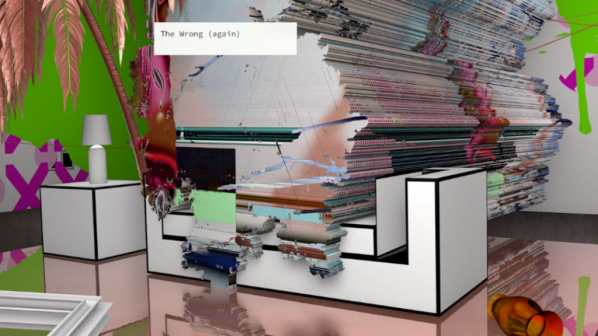

In allowing myself to peer into the abyssal mirror of content implicit in The Wrong and see my own reflection in it, I see a project I did in 1998. I curated a show called Through the Looking Glass for the Beachwood Center for the Arts in Cleveland, a 3000+ sq. foot space. More or less, there were a number of kindly locals who were curious about digital art. For this show, I got 80+ physical artists and 40 or more online artists to show the breadth of the current scene from every continent (there was even an Antarctican photo installation…) Artists included Michael Rees, Scott Draves, Helene Black, RTMark, and many more. The show included a physical space as well as the show website (http://voyd.com/ttlg/) which also included a number of other artists. The exhibition was promoted/discussed on sites like The Thing and Rhizome, and was documented in Christiane Paul’s New Media in the White Cube and Beyond, (UC Press, 2008), somewhat mirroring Guilló’s discursive hydra. The importance was that it got a regional and international dialogue going about the state of media art at the time, much like The Wrong, but only at a fraction of the latter’s scale.

Guilló’s project transcended the museum, as in conversation online he was enroute to one of the museums he has spoken on the subject, including sites Europe, North America (SAIC) and others. In this regard, the reach of the project, while theoretically only possible as something like Ars Electronica’s Net.Condition or the Walker’s Art Entertainment Network in the late 90’s, has engaged the many social media layers from Facebook, Twitter, as well as net.distribution and reached a much wider audience. In this way, I feel Guilló has sidestepped the institution to make an exhibition that reflects the cultural terrain and social practices of its milieu – the Internet. In some ways, I feel that The Wrong could be the first true net.biennial.
With nearly a hundred “pavilions” to view, writing on any one cannot address the scope and structure of The Wrong. Perhaps I am less enthralled with ones that deal with individual artists, moreso with thematic pavilions, and more with the open call ones, as they create a generative basis for expansion of the biennial itself, creating more diversity within it.

One of the open calls that I liked well enough to volunteer for was Brazilian Gabriel Menotti’s Approximately 800 cm³ of PLA, which was an open, print-til-we-run-out, Fluxus-reminiscent, “give us a file and we’ll print it exhibition”. The resultant models were put on display at Baile, in Vitoria, Brazil, and included pieces from veteran Chicago 3D print artists Tom Burtonwood and Taylor Hokanson. Another pavilion of interest (again using the mirror metaphor, as I have been known to do work in virtual worlds) is that of the Wronggrid Pavilion in FrancoGrid, a Francophonic OpenSim (read: open source Second Life) that hosted a 6-month residency with sixteen artists. The WrongGrid Pavilion has generated a great deal of content, especially from Jeannot GrandLapin (Frère Reinert?) as the big avatar rabbit GrandLapin, and another Chicagoan, Paul Hertz. The WrongGrid virtual vernissage was one of the more memorable events in The Wrong as it gave one of the few opportunities for people to meet in the virtual across continents and share in the work in real time. But these are only two of nearly 90 sites that constitute this massive undertaking.
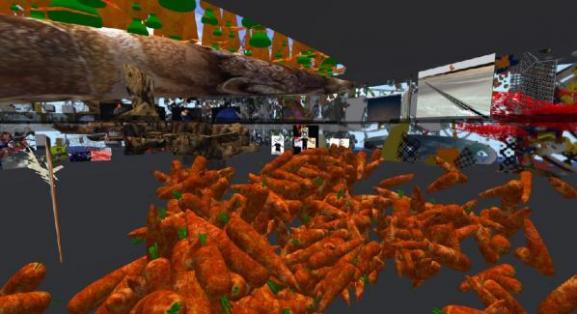
David Quiles Guilló has created a juggernaut – significant enough to get the #3 nod from Hyperallergic for top shows in 2015. From its size and scope, it represents a breadth of artists and themes that shows a fantastic cross-section of the current electronic media art ecosystem. In addition, The Wrong engages avant practices of open curation, nested participation, and relational organization while challenging the necessity of institutions and art fairs. While The Wrong may be as hard as Benjamin’s Arcades Project to get through, most sites give rich experiences, and some give empty links. What is important about The Wrong Bienniale is that it appears to be one of the few projects that is a true net.biennial in terms that it is about the net, how its links with the physical, and how it refers to projects like the Fluxus-inspired Eternal Network that explore how we create through social and technological networks. The Wrong Bienniale is a disruptive site of cultural engagement in a social milieu complaining of malaise and cynicism. It’s time to consider what media art is; how our communities interact; how we operate as a community; and what it means to be a media artist in a mediated culture.
In a mysterious pine forest, inhabited by half-human, half-animal creatures, the dismembered white body of a furry god is slowly reassembled. A creature with the head of a black bear pulls down the decapitated body from a tall rock. A red-robed character with a crimson wolf’s face, decorated with sharp white teeth, fetches the severed head. Another brings the eyeballs; another, the skull. Finally, in an illuminated multi-coloured tent glowing in the darkness of the woods, a character with the head of a triceratops and a cloak of many-coloured feathers performs a ritual involving magic crystals and a dead bird doused in blood. The film ends with a single glimpse of the white god’s foot, planted in a field of snow, sufficient to suggest that he, she or it has been brought back to life.
I first came across Magic Blood Machine as one of the staff picks on the Vimeo site in October 2014. It was on a list of spooky videos for Hallowe’en. The rest of them looked fairly conventional, but the still for Magic Blood Machine stood out: the red-robed character from the film standing amongst dark pine trees, looking a bit like a Roman Catholic Cardinal, a bit like Anubis – the jackal-headed god of Egyptian mythology – and a bit like Reynard the Fox. When I watched the video, I was struck by the same mixture of associations: it seemed to combine elements of the crucifiction and resurrection of Jesus, the dismemberment and restoration of Osiris, and the Green Man myth. Folk-stories, mythology, the occult, the macabre, and even a touch of science fiction were all in the mix. But its visual design, filmic and narrative qualities were just as striking. There are no words spoken, and the pace is slow, but nevertheless the film exerts a powerful compulsion, partly because of the expertise with which each sequence unfolds and leads us to the next, and partly because it’s so full of unanswered questions. The actions of the strange characters in the pine forest seem charged with hidden meaning, as do the characters themselves, sharply-differentiated from one another as they are by virtue of the brilliant costume-design. There is a strong sense of place in the outdoor filming, and a strong sense of the tactile as well: the way the characters stroke the dead god’s fur, fondle the magic crystals or pour blood over the breast of the dead bird, for example. And despite the use of expressionless masks, there are moments of powerful emotion. When the red creature, having retrieved the white god’s severed head, lays it next to the rest of the body and then sits beside the corpse, holding its hand, it eloquently conveys a sense of love and grief.
Magic Blood Machine was made by a Norwegian artist and film-maker called Ingrid Torvund, in close collaboration with her partner Jonas Mailand, and with music by Jan Erik Mikalsen. It took three years to make (2009-12), and a sequel called When I Go Out I Bleed Magic – which Ingrid describes as the second part of a trilogy – was released earlier in 2015. For me, When I Go Out I Bleed Magic is less compelling than its predecessor, but if anything the design of the film, in terms of costumes and settings, is even more impressive. Ingrid makes almost all the costumes and props herself, and they are works of art in their own right, some of which she has exhibited separately. She has also exhibited her drawings and published many of them in a book, again with the title When I Go Out I Bleed Magic.

Ingrid’s work strikes me as an example of the enabling power of the Web, which can sometimes allow genuinely original artists to reach international audiences they would have found it very difficult to access at any time before the 1990s. It also allows the likes of me to get in touch and start up a conversation out of the blue. Accordingly, I contacted Ingrid via email to ask about her work, and the results are reproduced below.

Edward Picot: Can I ask you about the making of the costumes and props for your films?
Ingrid Torvund: I make the costumes and props myself mostly, sometimes I get some help from my friends and family, if it´s large set pieces and so on. I like to take my time making these things, it`s a slow process but it´s one of these things that makes life worth living.
EP: Were you at art school, and if so did you study art, textiles, film or all three?
IT: I went to Oslo National Academy of the Arts,where I took a bachelor degree in fine art. While I was there I made my first short, “Magic Blood Machine“, and I worked on it for three years. I took courses in film, philosophy and many other subjects.
EP: Can you describe your creative process a little bit? Do you start off with an idea for a story, or with sketches in your sketchbook?

IT: it’s really random how I find inspiration, but sometimes I find a nice tactile material that I want to work with and I start by just trying out how and then I can make something that gives the audience the same feeling I got when I first saw it. And sometimes I get a picture in my head of a scene I want to make and then I try to figure out how to make it, then I draw it (but not very detailed and not very good 🙂
I wish I could say I plan out projects better, but I usually just make what I want to make. Over the years the planning of the filmprojects has become more detailed, but this is because I have to [plan things out] when I apply for funding and it’s a real creative killer.
For the last film “When I Go Out I Bleed Magic” we (me and Jonas) made a long storyboard with many scenes, but in the end we didn’t get to make them all due to lack of funding, lack of time and plain exhaustion.
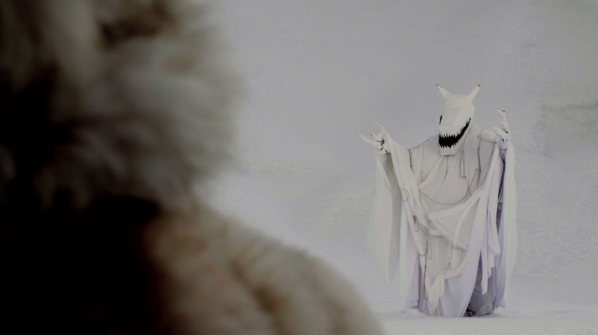
EP: You say you like to take your time making the costumes, props and so forth. Does this mean that your ideas about the film you’re going to make grow quite slowly and organically as you’re in the process of making things?
IT: Yes it does, it’s a long process and I usually try to finish one little part at a time: a costume, a set piece and so forth. But when the time comes to shoot the scene, I have to but all the pieces together, and then I have a time limit. In the two films I’ve made so far I’ve been borrowing my dad’s place, because there I have the space to actually build a little studio in the summer. But since this is his workplace normally, I have to clean it out before they come back from their holiday 🙂 So the summer is a really intense period in the year for me and I have to plan it out more, due to the fact that when I go to work there, I can’t get away, so I must buy all the materials I need before I go. I don’t have a car or a licence and it’s in the countryside. We do have a little boat that I can take to the grocery store 🙂



EP: You mention you’ve got a boat – and lo and behold, there’s the red character rowing a boat in Magic Blood Machine. I’m guessing from this that the boat in the film is your own boat, and the lake which appears in both films is the lake where you live.
IT: Yes, most of the places in the movies are from around where I grew up. I also think that it’s important to find inspiration from real and often personal things in life. it feels important to me to know that the project has some kind of root in something real. At my last exhibition my mother gave me some very old school books that I had made some drawings in, and it was almost disturbing how much some of them resembled some of my more current drawings!

EP: Let me ask you about Jonas. How do you work with him? How did you get to know each other and work together, and do you write together, or does he do the camerawork while you put on the costumes and do the acting?
IT: I met Jonas while we were going to an art school in Oslo seven years ago, at the time I was already making characters and installations and we started to date while I was building a forest installation inside a room. He has always had great interest for films and making them, and at that point I was thinking of trying to bring my characters to life by making them into costumes I could wear. After a year we started working on Magic Blood Machine. From that point he has done all the camerawork, while I do all the costumes, set pieces and “acting”. We usually edit the films together and sometimes we make an edit each and then compare them, and choose what we think works the best. I’ve been asked before how we collaborate on these projects and sometimes I find it a little difficult to answer, because we live and work together and we have no rules on who does what in these films. But I do know I spend most of my time thinking or working on these films and Jonas takes part in that if I ask him to. Without him I would not be able to make films like these and my life would suck.


EP: Lastly, would you like to say a bit about the mixture of mythological references in your films?
IT: I have always been fascinated with the mixture of pagan and Christian culture. When I was young I found a book called “Norske Hexeformularer og magiske opskrifter”: it’s a collection of spells and magical recepies from 1600-1900. The spells are collected from small black books found throughout the country, often hidden away. Some would put them under the church steps in an attempt to get rid of them. My films are inspired by these rituals and the conflict between nature and religion. I grew up going to church a lot and I think the mix of church and folklore is something I use as inspiration when I make films.
I think I find the history of how people lived and their traditions even more fascinating then fairy tales, for example people used to think that their newborn babies sometimes got exchanged with a person from under the earth.The child then got some kind of physical change,like a weird growth or huge eyes or it suddenly looks very old. The only way to fix it was to lure the under earth person to tell you their real age. You did this by doing weird and absurd stuff, like making porridge in an eggshell or making blood sausage in an catskin. Then it would suddenly tell you how old it was and then it would die. Leaving a little lump of ash and bones…
More information about Ingrid Torvund can be found on her website, http://torvund.tumblr.com/. Magic Blood Machine is on Vimeo at https://vimeo.com/44936472, and When I Go Out I Bleed Magic is also on Vimeo, at https://vimeo.com/44936472.
Featured image: “Binoculars” at CHB in Berlin (2013)
Varvara Guljajeva & Mar Canet have been working together as an artist duo since 2009. They have exhibited their art pieces in a number of international shows and festivals. As an artist duo they locate thermselves in the fields of art and technology, and are interested in new forms of art and innovation, which includes the application of knitting digital fabrication. They use and challenge technology in order to explore novel concepts in art and design. Hence, research is an integral part of their creative practice. In addition to kinetic and interactive installations, the artists have also experience with working in public spaces and with urban media.
Varvara is originally from Estonia, and gained her bachelor degree in IT from Estonian IT College, and a masters degree in digital media from ISNM in Germany and currently is a PhD candidate at the Estonian Art Academy in the department of Art and Design. Mar (born in Barcelona) has two degrees: in art and design from ESDI in Barcelona and in computer game development from University Central Lancashire in UK. He is also a co-founder of Derivart and Lummo.

Filippo Lorenzin: Open culture is one of the main points of your research and activity. Could you describe how this influences your art practice?
Varvara & Mar: We are living in very exciting times. Open source has introduced democratization of production and creation. Now you can build your own 3D printer, laser cutter, knitting machine, make a light dimmer circuit or develop a body tracking system. Some years ago we couldn’t even imagine this and now we have access to this knowledge. People share their creations and these process, which is incredibly inspiring for us and many more people. Thus, knowledge is built on top of knowledge. We make use of open source marterial in our work and we try also to contribute back. This is the whole point of open source in our mind. And if one looks in the perspective of art to open source projects, then really many open source projects have artists on board, for example, OpenFrameworks, Processing, and more.
Open source also has an educational aspec. We do many workshops with people and teach what we know and how we work. We think open source culture is largely based on the spirit being open to sharing knowledge with many others.
FL: I’m really fascinated by your interest in textile fabrication. it reminds me the early industrial developments that were deeply connected to in the textiles industry. How and why would knitting be integrated these days as part of a makers’ culture?

V&M: The process of integration is well under way. There has been a good number of makerspaces who have dedicated areas for textile production, like WeMake in Milan and STPLN in Malmö. And believe it or not this simple thing helps to introduce gender balance in these kind of places. We’re not just talking about innovation, which can boost gender equality when you introduce knitting to hacking. We’re also talking about the democratisation of production, when thinking about clothing too. This area is quite vital and commonly understood. 3D printing toys is a cool activity for a weekend, but then it becomes boring. Knitting a sweater or a scarf has real value and the quality is always higher than a typical mass produced factory product.
For 3D printing we cannot say the same. Don’t get us wrong, we are not against the 3D printing. We love it and have six printers in our studio. Our point is that the areas of concern for digital fabrication are not complete, and the founders of FabLab have overlooked the whole area of textiles.
FL: You’ve run many workshops taking in account various topics such as 3D printing, solar energy and knitting, of course. How do these activities connect with your research?
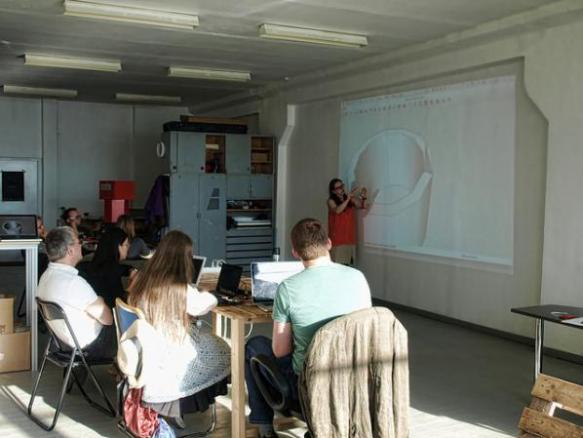
V&M: First of all, we like to teach and interact with our students. Second, preparing a workshop, allows us to research more about the field, and organise and share our accumulated knowledge and experience.
And finally, workshops are one part of our income. We don’t have any other jobs on the side, and exhibitions and commissions are not regular and do not always pay well, and yet the bills keep coming in. Hence, workshops help us to pay our bills.
FL: One of your works which most fascinate me is “Sonima” (2010). It’s a project that takes in account questions that have become quite recurrent in last months, mostly linked to Anthropocene discussions. The soft coexistence of technology and nature which is organic and artifical. Which is one of the main topics of your research: why are you so interested in this question? It looks like you’re trying to develop experiments for an utopistic future in which humans and nature live in symbiosis. Am I wrong?

V&M: Yes, many of our works express our futuristic thoughts or imagination where the digital age will lead us and our planet to. It is nice that you have noticed this. I would say this kind of concept in 2010 was quite subconscious. I (Varvara) was very interested in organic form but with mutational origins but still adapted by nature.
More conscious approach towards anthropocene epoch can be seen and felt in “Tree of Hands” (2015), which is one of our recent works. However, it looks like we have touched quite a taboo topic. For instance, “Tree of Hands” was rejected by jury of PAD London fair because of its depressive concept.
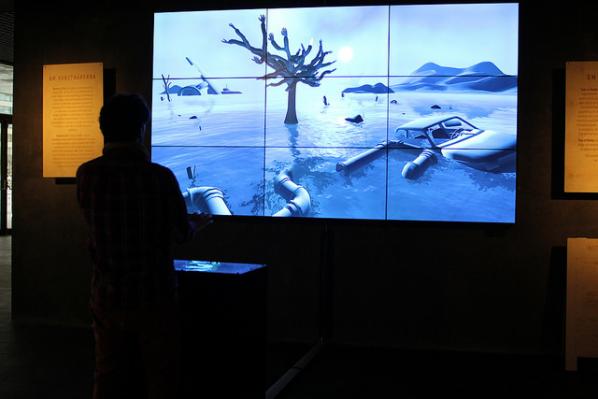
FL: “Shopping in 1 Minute” (2011) is another project I would like to ask you about. This work is about consumerism at its finest (or worst), turning one of the most typical capitalistic places (supermarkets) into ludic spaces. It’s a piece of social art that presents itself without informing the public what is right and what is wrong, but it rather suggests in a more subtle way the perversion at the base of that system. What do you think?
V&M: Yes. What we are doing is the absurd exaggeration of the same action (buying) to a maximum with one but: not buying and playing instead. There is a saying that shopping is 5 min happiness. The artwork tries to create a synthetic feeling of satisfaction of the ability to buy. The shopping centers are doing everything to stimulate our consumption needs, and our artwork manages to get inside their ecosystem and playfully releases that artificial desire to buy.
FL: With at least a couple of projects, you’ve also worked to the redefine hurban landscapes by looking at the invisble while at the same time taking on rather specific forces such as mass use of Wi-Fi networks becoming part of the everyday. I can’t help thinking that this is somehow related to privacy questions, probably because one of the most notorious scandals some years ago was Google’s secret recording of Wi-Fi networks with their Street View cars. Am I wrong?
V&M: Not really. But definitely Google has played a role in feeing our concerns about being watched, spied, hacked, scanned, etc. For example, the last scan for WiFi router names we did last summer in Tallinn some people were quite freaked out seeing a person on a bike with a camera on its head and tablet in front. I was even once asked if I worked for Google. 🙂 Anyways, the project was great fun for us, and we got to explore the city and discover the whole invisible communications networks and the self expressive layers of it all. After the Tallinn scan we even changed our minds about the 32-character local Twitter that the WiFi router SSID could be used for. The Tallinn experience showed us the new tendency: where people would use radio waves for semi-anonymous graffiti, communicating sometimes silly, protective, racist or political messages.

Talking about inspiration for this project, we got our interest for WiFi names from one article talking about the ability to track down pro- and contra-Obama communities by just looking at WiFi names in the neighborhood. This was before the US president election. Then we started to thinking of an art project on this topic.
FL: “The Rythm of City” (2011) is another project which is also ‘subtly’ related to control issues. The idea that someone can depict the state of a city by looking at data deducted from social media and web platforms. This type of thing is real now isn’t it – what do you think?

V&M: Definitely it is. However, the work’s main intention is not to talk about control issues rather about big data and its applications. Perhaps the main intention of this work is to offer to the viewer(s) a birds eye view on different cities in real time. In other words, The Rhythm of City allows you to zoom out and witness the larger picture on the current situation. And this larger picture is formed by everybody’s activity on social media, which is tracked down every minute. We call this action ‘unaware participation’ by digital inhabitants. The urban studies of Bornstein & Bornstein from early 1970s served as an inspiration for this artwork. They had discovered a positive correlation between the walking speed of pedestrians and the size of a city. Simply put: the bigger a city, the faster people move. The artwork demonstrates our interpretation of a city’s tempo through in its digital form or life. Hence, The artwork talks about pace of life in different cities at the same moment when the piece is viewed.
FL: What have you been working on these last few months and what plans do you have for 2016?
V&M: We are working on a series of new works talking about money. When we have completed “Wishing Wall” in London in 2014, since then we have noticed that the majority of people, especially a younger audience, wish for money. This really caught our attention. The ongoing hard economical situation in Europe pushes forward the need for money and also introduces a growing gap between the economical classes. So we’re investigating people’s desire for money and its connection with happiness. Making use of interactive technology we are aiming to approach playfully and magically the desire for becoming rich. At the same time, we cannot let go of knitting. At present, we are working on an open source flat knitting machine, which will be able to knit patterns also. Besides the new productions, we are showing our existing works in various exhibitions. For the confirmed ones, “The Rhythm of City” will be part of “REAL-TIME” a group show curated by Pau Waelder in Santa Monica museum in Barcelona from the 28th January. In February “Digital Revolution” (the touring exhibition by Barbican), which “Wishing Wall” is part of, moves from Onassis Cultural Center in Athens to Zorlu Center in Istanbul. And hopefully we get couple of other shows and new productions that are in the air at the moment and still to be confirmed soon.
Featured image: @mothgenerator by Everest Pipkin and Loren Schmidt
Taina Bucher interviews artist and bot maker Everest Pipkin about their most popular Twitter bots, how they work and what they mean. Indeed, what are bots, who else is engaged in artistic bot-making, and how will social media bots evolve?
Meet Tiny Star Fields. Several times a day, the Twitter account publishes a field of stars in different shapes to a dedicated 51.000 followers. The latest tweet, published 53 minutes ago, has already been retweeted 151 times and gathered 114 favourites. Tiny Star Fields is a Twitter bot. During the last few years, bots, or automated pieces of software, have become an integral part of the Twitter platform. As some recent reports suggest, bots now generate as much as twenty-four per cent of posts on Twitter, yet we still know very little about who these bots are, what they do, or how we should attend to these bots. Admittedly, star-tweeting bots like Tiny do not belong to the kinds of bots that are most talked about. When people usually think of bots, they mostly have a specific type of bot in mind, which animates feelings of annoyance and disturbance. The spam bot, however, is but one kind of bot.
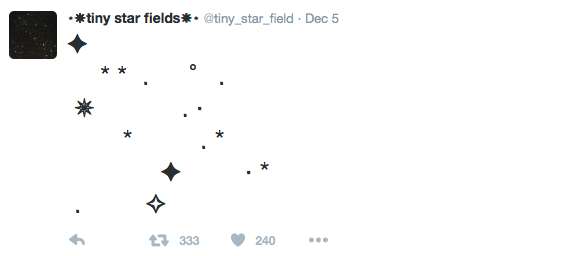
As Tiny and many others like to attest, bots are just like people. They are different. They tweet for different reasons, have specific audiences and engage with the world in various ways. Guided by their human programmers or taught to learn from existing data in playful ways, bots are legitimate users of platforms. But bots would be nothing without their creators, their makers who have conceptualized and brought these digital personas ‘to life’. So let’s not just meet Tiny Star Fields but also Everest Pipkin, the 24-year-old artist and creator of Tiny Star Fields.
Everest why don’t you tell us briefly about yourself and your background?
I grew up in the woods of Austin, Texas, where I also attended university for my undergraduate degree in studio art. Most of my work there was focused on drawing and installation, but I was also curating internet ephemera and beginning some rudimentary code projects at the time (albeit in isolation from others doing similar work). I also have a history in curation and have run creative spaces for many years. I’m currently pursuing my MFA at Carnegie Mellon in Pittsburgh.
What got you started with making Twitter bots?
I started making bots in the summer of 2014. I moved to a tiny town in rural Minnesota (population 900) for a longer-term artist residency and was quite isolated. I didn’t have a car, there was no bus or train, and I didn’t know anyone there. I was used to being alone on residency, but often I had friends near enough to visit or a local coffee shop to haunt. With no other options, I was at home and online almost constantly. The internet has always been important to my practice (and my social life), but I attached myself to it as a lifeline in that period.
I was already following Twitter bots (@everycolorbot, @youarecarrying, @twoheadlines, @minecraftsigns, @oliviataters, @prince_stolas, and I’m sure many others), but being online constantly shifted how I thought of them, rather than just seeing their occasional statements as charming non-sequiturs in a human space, I started to notice their underlying personalities, the structure of code that differentiated one from another; when they posted, the kind of source materials used, how they interacted with others. With nobody to keep up with locally, I also began sleeping in erratic structures- some nights for 5 hours, others for 14. As a side effect, I would catch off times on Twitter, where everyone but the bots were asleep. These timelines of automation had a striking effect. I was particularly fond of the bot chorus around the turn of the hour- bot ‘o clock, as some call it.
I had been following and aware of @negatendo’s #BOTALLY posts (a sort of # organizing structure for bot-related news and resources) for a while, but I also started following @thricedotted, @inky, @beaugunderson, @tullyhansen, @aparrish, @boodooperson and @tinysubversions (and many others!) in this period. There were new bots almost every day, all unique, and I was really taken by how people interacted with them and how they operated in that social space.
How did you go about making your first bot?
I got node.js set up on my laptop (no small task for me then) and figured out some fundamentals of text manipulation in javascript. After several false starts, I made my first bot, @feelings.js, in the afternoon. I made @tiny_star_field five days later, in the middle of the night, hiding in my basement during a tornado. The power was out, and I’m almost certain I got the structure done in one laptop charge. I deployed it when the power and internet came back the next day.
You waited for the sky to clear and become sprinkled with stars again. In the meantime, you made your own digital sky, that’s cool. Did you do a lot of programming before starting with making bots?
I suppose that depends on what you mean by programming. I had worked in and around browser-based experiences for years but had never taken a structural approach to learning code. Every new idea and project had a particular set of problems that I attacked with utter naivete, writing vast messes that were shocking when they worked. Looking at my source code for those projects now is very much like looking at an outsider-art approach to computer science. Which is, I suppose, what they are.
I still sometimes struggle with basic concepts just because I haven’t run into them before- I learn best when directed at a goal, and sometimes those goals skirt fundamental structures. My knowledge is a funny hodge-podge assemblage of extremely difficult concepts I needed for some project or another, while I may forget the syntax for a basic sentiment. I keep telling myself I’ll read a book or take a course on putting code together properly, but so far I keep learning what I need. I am sure I will feel the same about my current projects in a year or two as I do about my older ones. My first bots are very embarrassing inside and it has only been a year and change.

You’ve said that @tiny_star_field is your most popular bot, but your personal favourite is @feelings_js. Would you care to elaborate?
Neither of those bots came from a particularly well-considered place technically; they were the first I made, and I was learning. I was tickled by the idea of a bot that did nothing but emote; it seemed like a charming inversion of the coldness that often creeps into automata. Tiny was a simple reflection of my Unicode character habit; I have a hobby of making little vignettes or dioramas combining characters and atypical symbols, and I have been enjoying automating them. (I am also now a Unicode Consortium member and am working structurally with these characters.)
That comment about favourites was from a long while back, and my favourite bot is probably now Moth Generator (@mothgenerator), which was a collaboration with @lorenschmidt. It’s different from many of my bots; it’s just a wrapper on an image generator, but it is the first bot I’ve made that I felt used @-replies in a truly useful manner. It takes the text of the tweet sent to it to seed the generator with a unique number; therefore, the ‘moth’ moth will always look like every other ‘moth’ moth, while a ‘bot’ moth would shift in many ways. A ‘moth bot’ moth would share characteristics of both.

How do these bots work?
Feelings.js (and a few others like it) is basically a fill-in-the-blank Wordnik wrapper. It has a variety of possible sentence structures on a switch statement and then pulls parts of speech from the dictionary API. I have a few structural rules that slightly favour alliteration and a few other cute tendencies (blocking offensive words), but it is basically mad-libs.
Tiny is even simpler; it has a large array of star and space options and pulls randomly from the available options. The biggest challenge was finding an ideal balance between character frequencies. I tweak it occasionally and don’t feel it is ideal yet. I am tempted to make it sparser. I am also in the process of making a Tiny Star Fields clone that uses actual astronomical data at varying scales, so the tweets will be a literal patch of sky.
Some of my other bots are a little bit more complicated- Moth Generator is a wildly long drawing routine in Javascript, Sea Change (@100yearsrising), tweets unicode characters mapped to sea-level rise predictions over the next century. Others use more obscure text manipulation techniques and large corpuses. But I think it is important to note for folks just starting that complication does not necessarily make them stronger artistically or more popular socially- the best things are almost always just good ideas.

What has been the response to your bots?
There is certainly an audience of bot appreciators; sometimes, I will see people who follow 30 or 40 bots but none of their makers. Bots also have their own secret lives outside of intention. Tiny auto-followed people back for a while (something like the first 6k) made for a truly wonderful sample! Very few are in the bot community; I think the vast majority are One Direction fans. It is a fascinating slice of social life I would never think to seek out myself.
What is the bot community that you are referring to?
Gosh, what is the bot community, good question. I suppose it seems to be a loosely associated group of folks interested in social bots. People seem to come from all walks- programmers, game developers, linguists, writers, artists, analysts, and poets. Making the skeleton of a Twitter bot is a fairly simple exercise and doesn’t inherently have the high knowledge overhead of some other creative programming tasks. They are also incredibly flexible in content and process, and I think that mutability allows a certain wealth of intent from bot to bot. These two avenues of openness mean they are used for all sorts of things! As entities, they are as unique as the people who make them.
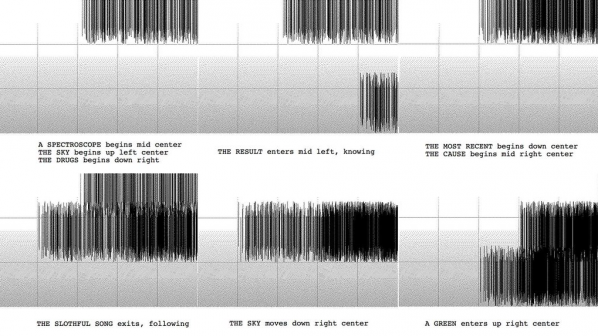
In general, I’ve found folks who are organized around making bots to be nothing but supportive, kind and interested in helping others get started with producing their own work in this realm. Within that community, structure are also all the folks that might not make bots (yet) but know what they are, and are interested in their processes, or write about them, or consider them valid as artworks or creative entities.
What, indeed, are bots?
What are bots? Gosh, this is an even better question than the one about bot communities. So, there are many ways to think about bots, and in my opinion, they are stackable and do not refute one another. But here are my thoughts:
Firstly, they aren’t new automata has been around for a very, very long time. One can look at examples of clockwork machines or candle-powered toys from over 1000 years ago. Even beyond physical examples of automata, the idea of bots is pervasive culturally; stories about golems and enchanted armour or physical objects imbued with personality have been with us since stories began.

Digital bots (especially those living in social spaces) fit into this long history of objects granted almost humanness. They fill in for a part of human action, the slice of person granted to digital representations of ourselves. Just like the golem that guards a passage, their tasks are programmed, but we grant them entity because they do these tasks on their own (guard, tweet). Perhaps this is as much doubt (“Is it /really/ a bot, though? Maybe it’s just a person pretending?”) as it is a gift.
Secondly, I do think there is an aspect of doubling or mirroring that these bots employ. They are widening the reach of their creators; they are automated versions of a specific slice of their creators. Many, many bots fall into this category. Something Darius Kazemi once said first got me thinking this way. It was advice to a want-to-be bot maker who didn’t have an idea for a bot. Darius suggested ‘come up with a funny but formulaic joke and automate it’. This type of repetitive production is not just seen in joke bots but almost all bots that are not attempting to emulate humanness. The maker would have made the joke once; by making a bot, it is made many times (but also, perhaps made better than it would have been once).
To expand, the goal of work-by-generation is a fundamentally similar but shifted process from that of work-by-hand; rather than identifying and chasing the qualities of a singular desired artwork, one instead defines ranges of interesting permutations, their interpersonal interactions and how one ruleset speaks to another. Here, the cartographer draws the cliffs that contain a sea of one hundred thousand artworks. And then, one searches for the most beautiful piece of coral inside of their waters.
So, I suppose this is where bots are truly interesting to me because this kind of making (looking for the best moment in a sea of automated possibilities) is a methodology of construction that feels, in some ways, new.
I like the notion of bots leading secret lives. Are you ever not in control over your bots? Or what does this secrecy entail?
I take a pretty lax approach to keeping up with my bots. I rarely log into their accounts or closely monitor what they are up to. I censor certain offensive words, follow them on my Twitter account, and hope to catch them if they break. This means that their notifications never reach me; the things that are said to them (or their own replies) are often invisible to everyone but them.
In what ways do people or other bots interact with your bots?
Most (although not all) of my bots are non-interactive, meaning they do not @reply back when spoken to. That being said, they are absolutely interacted with. Tiny star fields, in particular, get a ton of messages; lots of people will have conversations in the mentions. I find them pretty charming and will occasionally peek at what people are saying to one another. Since I generally keep @replies off, I don’t get the bot-to-bot eternity loops you’ll sometimes see with the image bots, ebooks bots, or others that reply. But I always like it when spam bots or Reddit bots find mine by keyword search. The best example of designed bot interaction might be Eli Brody’s tiny astronaut (https://twitter.com/tiny_astro_naut), which inserts spaceship emoji into Tiny star fields’ tweets, or its conceptual sibling, tiny space poo (https://twitter.com/tiny_space_poo).
How many of your bot’s followers do you reckon are other bots, and is bot-to-bot interaction different to how humans interact with bots?
I haven’t done the numbers, but it seems like there is a slightly higher percentage of bot-to-bot followers than human-to-bot. I would guess this combines auto-following routines and being manually directed to follow entire lists of other bots. Perhaps also, they are more patient with repetitive or nonsensical tweets and stick around longer.
Most bots now have conversational abandonment built in, but this was not always the case- it was once pretty common to see two replying bots get into a conversation with one another that would last hours or days, to the tune of thousands of tweets, one every few seconds. I once got accidentally caught in mentioning one of these cycles and had to wait for one of the bot’s owners to wake up and reset their servers. It was amazing, and I also had to turn off all notifications on every device I own.
Now, I think most bots use more intelligent replying- just to one person, randomly across their followers, or only every 10 hours, or perhaps replying to keywords or requests. To me, this has made bot-to-bot interactions feel a lot more human.

Do people ever wonder about you, the human behind the bot?
Many people who follow Tiny Star Fields do not understand that it is a bot! Or that bots are even on Twitter. The predominant interaction that seems to occur runs along the lines of “DO YOU SLEEP” or “what is this” or “I love these thank you so much for making them all the time”. I find that disconnect pretty delightful- the assumption of a (very) dedicated human somewhere. I’m also fond of the interpersonal conversations in the comments, often having nothing to do with the original stars; it occasionally functions as a bit of a forum for strangers to connect.
Where do you see Twitter bots or social media bots generally evolving?
I have found myself moving off of Twitter and back into non-social spaces for much of my work. Part of this is probably personal; my interests shift project-to-project. Part of it is intrinsic limitations in the media, the 140-character limit, and the difficulty of keeping up with Twitter’s often evolving terms of service. I am interested in physical robots or the housing of digital spaces- where these bots live- and a lot of my studio practice is now exploring tangible machines. Some of the best bots I’m seeing out of others use neural nets or very clever source material. In my own work, I am looking forward to more physical-digital integration, especially as I pick up some new toolsets required for more complicated work. I am interested in biological emulation and the hidden data that Twitter links to every tweet (perhaps my next bot will not be readable on the Twitter web client but instead comes alive in an API call?).
A small part of me also feels like others have taken up the call (and doing it better than I ever could have). This is to say, Twitter bots are in a kind of renaissance- tools like George Buckenham’s Cheap Bots Done Quick (which uses Kate Compton’s Tracery) and the plethora of tutorials and frameworks have radically democratized the process, and it seems like every day I see someone new to this space building interesting or beautiful things. I am learning as much from newcomers to the form as anything!
In short, for the future- who knows? But now, bots are serving as a fascinating space to test new ideas, construct entities and artwork of generated text and data, and publish those experiments to an audience excited to see them in the world. What more could one hope for?
Finally, what are your favourite bots at the moment?
https://twitter.com/CreatureList – automata bestiary from @samteebee
https://twitter.com/FFD8FFDB – image-processed security cameras by @derekarnold
https://twitter.com/imgconvos – a @thricedotted answer to image-bot loops
https://twitter.com/everycolorbot – The first bot truly dear to me still going strong, thanks to @vogon
https://twitter.com/reverseocr – a @tinysubversions bot that randomly draws until it hits whatever word it is trying to match in an OCR library
https://twitter.com/ARealRiver – the only real way to view this (very clever) bot is in its own timeline, probably on mobile. from @muffinista
https://twitter.com/LSystemBot – l systems by @objelisks
https://twitter.com/INTERESTING_JPG – a bot-form of deep learning, which attempts to describe human images with computer vision, by @cmyr
https://twitter.com/park_your_car – compelling use of google maps highlighting available car space by @elibrody
https://twitter.com/wikishoutouts – shoutouts to the disambiguation pages of Wikipedia
https://twitter.com/soft_focuses – a very quiet mysterious bot from @thricedotted
https://twitter.com/TVCommentBot – attempted image recognition of television, @DavidLublin
https://twitter.com/GenerateACat – procedural cats – @mousefountain and @bzgeb
https://twitter.com/pentametron – a bot that looks for tweets in accidental iambic pentameter by @ranjit
https://twitter.com/RestroomGender – @lichlike’s gendered restroom sign generator
https://twitter.com/digital_henge – This bot by @alicemazzy tweets moon phases, eclipses, and other solar and lunar phenomena
https://twitter.com/a_lovely_cloud – digital cloud watching from @rainshapes
https://twitter.com/the_ephemerides – computer-generated poetry with outer space probe imagery, @aparrish
To find out more about Everest Pipkin’s latest projects, please visit Everest Pipkin
Featured image: Nishant Shah, Roy Klabin, Francesco Warbear Macarone Palmieri, PG Macioti and Liad Kantorowicz
Finally I had the pleasure to attend to a session of the Disruption Network Lab. Physically, let’s say. Even though this was the first time I’ve managed to be in Berlin for one of its events, I’ve been a compulsory virtual follower, watching the videos of their fully recorded sessions. This is a hint for anyone who would like to watch all the previous keynotes and talks.
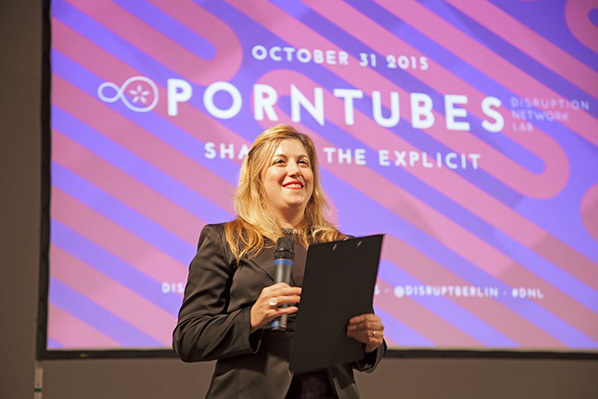
With its first edition in April, Disruption Network Lab is an ongoing platform of events and research on art, hacktivism and disruption, held at Studio 1 of Kunstquartier Bethanien, in partnership with Kunstraum Kreuzberg/Bethanien, in Berlin. On 31st of October it has held its 5th session, PORNTUBES: Sharing the Explicit. Aiming to discuss the role of porntubes in the sex and porn industry it gathered porn practitioners, entrepreneurs, sex work activists and researchers, to engage in a debate on the intertwining of porn with the Internet.
Pornography has always been a pioneer in using new technologies for its distribution and promotion. Internet, by allowing anonymous access to porn from the comfort of everyone’s home it seemed to be the ultimate tool for the porn industry’s expansion, to say the least. As pointed by Roy Klabin during the talk, 38,5% of the time we spend on the Internet is spent watching porn. As in many other spheres, it also seemed to be the beginning of a new era of labour liberation with an apparent decentralisation from the big porn production houses. This has allowed the blossoming of new small and independent companies with their own place in the market. But if cyberspace once seemed to offer a possibility to escape the tentacular control and exploitation exercised by the corporative monopolies, it is now known that the rebellion of the cybernetic innovators – creators of porntubes and new online sex tools – seems to be purely a coup d’etat.

The opening keynote was by Carmen Rivera, a Mistress and Fetish-SM-performer, with a long history in the porn industry business, with an experience of the migration of porn from cinema to VHS and later to the Internet and then onto the porntubes. In conversation with Gaia Novati, a net activist and indie porn researcher, Carmen tells us her personal and professional story and immediately gives a better understanding on how porntubes – such as Redtube, X-Hamster or Youporn – have an ambiguous influence in the porn industry. Once perceived as a democratic tool allowing small porn producers to expand their radius of audience-reach, Rivera explains how much of a perverse tool of exploitation it has become and one that small producers have become too dependent on.
The fast pace of the Internet creates a lot of pressure to satisfy the hunger of porn consumers. As has become virtually infinite “fast-porn” is closely aligned with the capitalist paradigm of production, putting a bigger focus on quantity rather than quality. As the Internet leaves no space for durability — one day you’re in, the next day you’re out — careers become frail, the work of these companies are highly precarious and the concept of the “porn-star” is a short lived mirage.
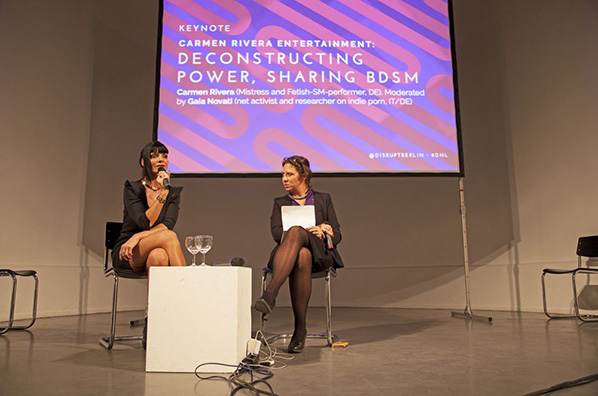
Rivera also highlights how online piracy has become virtually unavoidable resulting in gigantic losses to the porn industry. As producers see their films ending up on porntubes free of access, lawsuits don’t come as a viable solution but as financial black holes for any small or even medium companies. Even though the future doesn’t seem bright, Rivera doesn’t quit. Her battle cry: we need to create a bigger awareness of the pestilent system that controls the online porn industry. New tools of disruption need to be found to fight against these new power asymmetries established through the domination of cybernetic capital.
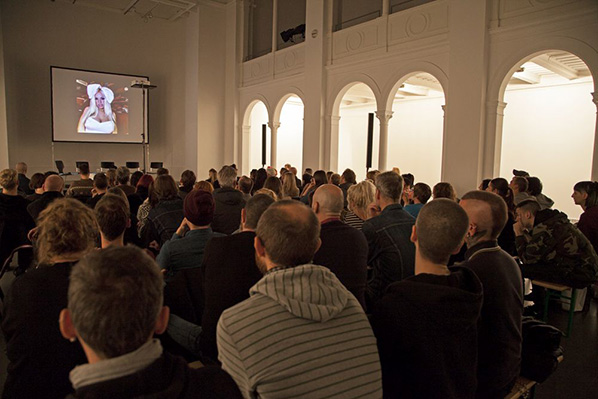
After the keynote, the discussion shifted to examining new tools of online sex work such as the project PiggyBankGirls, self-proclaimed as the first erotic crowdfunding for girls. Unfortunately, Sascha Schoonen, CEO of the project, wasn’t able to attend. Instead a short promo video was presented introducing the project, giving some tongue-in-cheek examples on how girls could profit from this crowdsourcing tool.
Women upload videos pitching their ideas or projects – financing a shelter for stray animals, the payment of tuition fees, a trip to Japan, – and then share online porn performances in exchange for support from “occasional sugar daddies”. Although one wonders if this isn’t just a euphemism – a sanitised version, let’s say – of already existing tools used by women who need money, regardless of them making public how they intend to spend money Nevertheless, it is true that the actual exploitative system needs to be dismantled, workers should be getting a bigger share for their labour and PiggyBankGirls poses as one more tool to do so, however this project also left many unanswered questions. Who are actually the women who can profit out of it? PiggyBankGirls promo tries to make this form of sex labour sound “cute”, easy and accessible. However, is just another tool for established porn actresses to diversify their means of income?
The panel, moderated by Francesco Warbear Macarone Palmieri, socio-antrophologist and geographer of sexualities, included abstracts showing a wide array of perspectives on the issue of porntubes and online sex work. The researcher Nishant Shah opened the panel with a wonderful talk ranging from porn consumerism to porn politics and how porn is influencing our digital identities. In a porn-consuming society, from establishing clear distinctions between “love” and “porn”, respectively meaningful and perverse, desirable and visceral desire, porn seems to be contingent on the morals of the spectator – as it only exists through the spectator it has also become a tool of puritan regulation. From Facebook teams of censorship and sanitisation of the virtual space to websites such as isitporn.com it is possible to understand that the concept of porn becomes itself a regulator of our sexual expressions, defining the line that separates decency from indecency. Paving the way to the pathologization of porn practices but yet dictating the meaning of authentic sexual performances, as the only visceral forms of sexual performances available, Shah pointed out how pornography, as a cultural and digital artefact, works in the regulation of our societies and in the production of our identities. Giving the example of Amanda Todd, who committed suicide after suffering from bullying for exposing her sexual body online, Shah shows how new forms of “porn” take place in the digital, from doxxing to unintended porn being perceived as such, enabling new forms of violence – let’s say porn-shaming.
Also focusing on porn consumerism, Roy Klabin, investigative documentarist/filmmaker, goes back to the discussion initiated with Carmen Rivera on porntubes VS porn producers and how producers make money. According to Roy, MindGeek, the company that owns most of the porntubes – from Youporn to Redtube – has been one of the main entities responsible of the destruction of the porn industry. By creating piracy websites holding gigantic libraries of free access to porn and making revenue out of the advertisement, resulting in huge losses for the porn companies which at the same time had become dependent on the tubes to advertise their work. Roy makes an appeal to porn producers to diversify their strategies: from webcams to virtual reality, the porn industry needs to be one step ahead of the contemporary systems of digital exploitation.
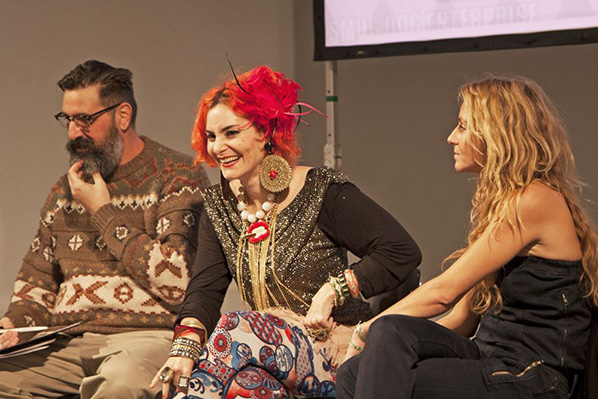
PG Macioti, a researcher and sex workers rights advocate and activist, together with Liad Kantorowicz, performer and sex workers’ activist, presented an overview on how the Internet has reshaped sex work – from sustainability to work conditions – listing some of the outcomes, pros and cons, of the extension of sex work to the virtual spaces. Online sex work, namely erotic webcam work, has enabled a proliferation of sex work by offering safe, independent and anonymous services. On the other hand with the insertion of sex work on the capitalist mode of production, just like in many other forms of digital labour it has rendered a bigger alienation to the workers – who work mainly alone and, also due to stigma, don’t share any contact with fellow colleagues – resulting in a more and more precarious labour, with sex workers being paid by minute, having to pay for their own means of production and usually paying a big share of their income to the middleman webcam services host agency.

Overall, the Internet has enabled a multiplication of narratives on sex work but the power asymmetries between the online corporations and workers results in a growing exploitation and precariousness. The transversal message to all participants seems to urge for disruptive tools for online sex work, tools of self-empowerment and emancipation within the digital paradigm. Quoting the Xenofeminism manifesto by Laboria Cubonics, “the real emancipatory potential of technology remains unrealised” and the Disruption Network Lab might be the much needed spark for this revolution.
The PORNTUBES event couldn’t have had a better ending with a party held in the legendary KitKatClubnacht, a sex & techno club that is open since 1994, famous for both its music selection and its sexually uninhibited parties. It seems an exciting idea, to say the least, to bring all together researchers, porn entrepreneurs and activists to this incredible venue after an intense afternoon discussing the porntubes.
Concluding the series of conference events of Disruption Network Labs during 2015, the next event will be STUNTS: Distributed, Playful and Disrupted, taking place on the 12th of December, at the Studio 1 of Kunstquartier Bethanien, and the direct link is: http://www.disruptionlab.org/stunts/. This time the discussion will focus on political stunts as an imaginative and artistic practice, combining hacking and disruption in order to generate criticism of the status quo. As the immense dragnet of state-surveillance extends it becomes imperative to understand which are the available tools of obfuscation, how it is (still) possible to hack the system and which tools of political resistance can be deployed Disruption Network Lab wraps the year with a tempting offer, inviting artists, hackers, mythmakers, hoaxers, critical thinkers and disrupters to present practices of mixing the codes, creating disturbance, subliminal interventions, giving raise to paradoxes, fakes and pranks.
The new project by Guido Segni is so monumental in scope and so multitudinous in its implications that it can be a bit slippery to get a handle on it in a meaningful way. A quiet desert failure is one of those ideas that is deceptively simple on the surface but look closer and you quickly find yourself falling down a rabbit-hole of tangential thoughts, references, and connections. Segni summarises the project as an “ongoing algorithmic performance” in which a custom bot programmed by the artist “traverses the datascape of Google Maps in order to fill a Tumblr blog and its datacenters with a remapped representation of the whole Sahara Desert, one post at a time, every 30 minutes.”1
Opening the Tumblr page that forms the core component of A quiet desert failure it is hard not to get lost in the visual romanticism of it. The page is a patchwork of soft beiges, mauves, creams, and threads of pale terracotta that look like arteries or bronchia. At least this morning it was. Since the bot posts every 30 minutes around the clock, the page on other days is dominated by yellows, reds, myriad grey tones. Every now and then the eye is captured by tiny remnants of human intervention; something that looks like a road, or a small settlement; a lone, white building being bleached by the sun. The distance of the satellite, and thus our vicarious view, from the actual terrain (not to mention the climate, people, politics, and more) renders everything safely, sensuously fuzzy; in a word, beautiful. Perhaps dangerously so.
As is the nature of social media platforms that prescribe and mediate our experience of the content we access through them, actually following the A quiet desert failure Tumblr account and encountering each post individually through the template of the Tumblr dashboard provides a totally different layer to the work. On the one hand this mode allows the occasional stunningly perfect compositions to come to the fore – see image below – some of these individual ‘frames’ feel almost too perfect to have been lifted at random by an aesthetically indifferent bot. Of course with the sheer scope of visual information being scoured, packaged, and disseminated here there are bound to be some that hit the aesthetic jackpot. Viewed individually, some of these gorgeous images feel like the next generation of automated-process artworks – a link to the automatic drawing machines of, say, Jean Tinguely. Although one could also construct a lineage back to Duchamp’s readymades.


Segni encourages us to invest our aesthetic sensibility in the work. On his personal website, the artist has installed on his homepage a version of A quiet desert failure that features a series of animated digital scribbles overlaid over a screenshot of the desert images the bot trawls for. Then there is the page which combines floating, overlapping, translucent Google Maps captures with an eery, alternately bass-heavy then shrill, atmospheric soundtrack by Fabio Angeli and Lorenzo Del Grande. The attention to detail is noteworthy here; from the automatically transforming URL in the browser bar to the hat tip to themes around “big data” in the real time updating of the number of bytes of data that have been dispersed through the project, Segni pushes the limits of the digital medium, bending and subverting the standardised platforms at every turn.
But this is not art about an aesthetic. A quiet desert failure did begin after the term New Aesthetic came to prominence in 2012, and the visual components of the work do – at least superficially – fit into that genre, or ideology. Thankfully, however, this project goes much further than just reflecting on the aesthetic influence of “modern network culture”2 and rehashing the problematically anthropocentric humanism of questions about the way machines ‘see’. Segni’s monumental work takes us to the heart of some of the most critical issues facing our increasingly networked society and the cultural impact of digitalisation.
The Sahara Desert is the largest non-polar desert in the world covering nearly 5000 km across northern Africa from the Atlantic ocean in the west to the Red Sea in the east, and ranging from the Mediterranean Sea in the north almost 2000 km south towards central Africa. The notoriously inhospitable climate conditions combine with political unrest, poverty, and post-colonial power struggles across the dozen or so countries across the Sahara Desert to make it surely one of the most difficult areas for foreigners to traverse. And yet, through the ‘wonders’ of network technologies, global internet corporations, server farms, and satellites, we can have a level of access to even the most problematic, war-torn, and infrastructure-poor parts of the planet that would have been unimaginable just a few decades ago.
A quiet desert failure, through the sheer scope of the piece, which will take – at a rate of one image posted every 30 minutes – 50 years to complete, draws attention to the vast amounts of data that are being created and stored through networked technologies. From there, it’s only a short step to wondering about the amount of material, infrastructure, and machinery required to maintain – and, indeed, expand – such data hoarding. Earlier this month a collaboration between private companies, NASA, and the International Space Station was announced that plans to launch around 150 new satellites into space in order to provide daily updating global earth images from space3. The California-based company leading the project, Planet Labs, forecasts uses as varied as farmers tracking crops to international aid agencies planning emergency responses after natural disasters. While it is encouraging that Planet Labs publishes a code of ethics4 on their website laying out their concerns regarding privacy, space debris, and sustainability, there is precious little detail available and governments are, it seems, hopelessly out of date in terms of regulating, monitoring, or otherwise ensuring that private organisations with such enormous access to potentially sensitive information are acting in a manner that is in the public interest.
The choice of the Sahara Desert is significant. The artist, in fact, calls an understanding of the reasons behind this choice “key to interpret[ing] the work”. Desertification – the process by which an area becomes a desert – involves the rapid depletion of plant life and soil erosion, usually caused by a combination of drought and overexploitation of vegetation by humans.5 A quiet desert failure suggests “a kind of desertification taking place in a Tumblr archive and [across] the Internet.”6 For Segni, Tumblr, more even than Instagram or any of the other digitally fenced user generated content reichs colonising whatever is left of the ‘free internet’, is symbolic of the danger facing today’s Internet – “with it’s tons of posts, images, and video shared across its highways and doomed to oblivion. Remember Geocities?”7
From this point of view, the project takes on a rather melancholic aspect. A half-decade-long, stately and beautiful funeral march. An achingly slow last salute to a state of the internet that doesn’t yet know it is walking dead; that goes for the technology, the posts that will be lost, the interior lives of teenagers, artists, nerds, people who would claim that “my Tumblr is what the inside of my head looks like”8 – a whole social structure backed by a particular digital architecture, power structure, and socio-political agenda.
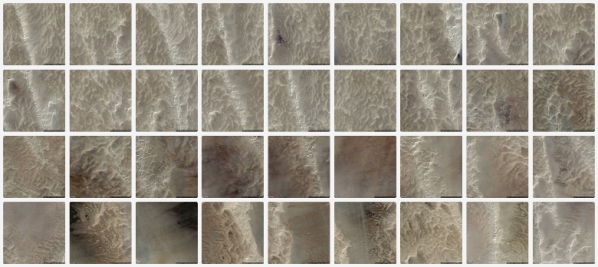
The performative aspect of A quiet desert failure lies in the expectation of its inherent breakdown and decay. Over the 50 year duration of the performance – not a randomly selected timeframe, but determined by Tumblr’s policy regulating how many posts a user can make in a day – it is likely that one or more of the technological building blocks upon which the project rests will be retired. In this way we see that the performance is multi-layered; not just the algorithm, but also the programming of the algorithm, and not just that but the programming of all the algorithms across all the various platforms and net-based services incorporated, and not just those but also all the users, and how they use the services available to them (or don’t), and how all of the above interact with new services yet to be created, and future users, and how they perform online, and basically all of the whole web of interconnections between human and non-human “actants” (as defined by Actor- network theory) that come together to make up the system of network, digital, and telecommunications technologies as we know them.
Perhaps the best piece I know that explains this performativity in technology is the two-minute video New Zealand-based artist Luke Munn made for my Net Work Compendium – a curated collection of works documenting the breadth of networked performance practices. The piece is a recording of code that displays the following text, one word at a time, each word visible for exactly one second: “This is a performance. One word per second. Perfectly timed, perfectly executed. All day, every day. One line after another. Command upon endless command. Each statement tirelessly completed. Zero one, zero one. Slave to the master. Such was the promise. But exhaustion is inevitable. This memory fills up. Fragmented and leaking. This processor slows down. Each cycle steals lifecycle. This word milliseconds late. That loop fractionally delayed. Things get lost, corrupted. Objects become jagged, frozen. The CPU is oblivious to all this. Locked away, hermetically sealed, completely focused. This performance is always perfect.”
Guido Segni’s A quiet desert failure is, contrary to its rather bombastic scale, a finely attuned and sensitively implemented work about technology and our relationship to it, obsolescence (planned and otherwise), and the fragility of culture (notice I do not write “digital” culture) during this phase of rapid digitalisation. The work has been released as part of The Wrong – New Digital Art Biennale, in an online pavilion curated by Filippo Lorenzin and Kamilia Kard, inexactitudeinscience.com.
“I-love-you: the figure refers not to the declaration of love,
to the avowal,
but to the repeated utterance of the love cry.”
Roland Barthes, The Lover’s Discourse. Fragments, 1977.
Designed and published online on October 14th 2004[1], restored for The Wrong (Again) on November 1st 2015, the website I Love You by French artist Jacques Perconte[2] is not only a wonderful achievement of his research on image files visualization through the Internet, but also a fundamental piece of artwork for three reasons: first, it crystallizes a history of audiovisual technologies in the web age; next, it allows the analysis of his singular inventions on plasticity which are shaped by the offensive processes and techniques Perconte has developed until 2015; finally, it makes explicit the artist’s constant will to put the body to the test of digital technologies (in this case the partner’s body) and to literally inject life (each and every thought, interest, feeling, emotion, excitement, and desire aroused in him by the beloved body).
Two events in 2003 gave birth to this piece: a publication proposal from French publisher Didier Vergnaud of a book with the digital photographs of bodies he had been taking tirelessly; and his romantic encounter with the woman who would become his partner, muse and model, Isabelle Silvagnoli. I Love You merges two stories, two passions. The one with Isabelle blooms in May 2003[3]; at this time, Perconte has already an extensive experience of digital technologies that he had developed since 1995[4].
At the Bordeaux University, when Perconte notices that a computer is connected to the rest of world, he becomes aware of the technical and aesthetic issues of the digital network, issues largely ignored at this time. His quick mastering of how the web operates leads to a decisive work on “the digital bodies”: three image generator websites (ncorps) and four films made by re-filming multiple loops of these animated pictures. This series denotes that Perconte has assimilated four essential dimensions of the digital.
First, he notes the image exists primarily in the state of a compressed digital signal that needs to be displayed; the signal recorded and stored as a file is a model, shaped by algorithms; its visualizations change only according to the codecs and the supports. Next, he distinguishes the human dimension of the web: the bodies of the users surfing the Internet on their computers and interlinking one another.
Then, the material dimension: the computers interconnected by an abundance of servers all around the world which produces a random digital time; indeed Perconte noticed the connection time to the hosting server of his websites was unpredictable since the answering time fluctuated according to the Internet traffic density, the connection’s and the browser’s qualities, and the computer’s performance executing the query.
So he notices the fantastic system failures: “when the first JPEGs popped up on websites, it wasn’t unusual for a picture to be only partially displayed. Sometimes, this happened to produce strange distortions in the image. (…) Every now and then, the image would totally turn into an abstract composition with amazing colors.”[5] Consequently, these fluctuations of display reveal a prodigiously fertile field of investigation: recoding the visualization. Finally, the web can be defined by the coexistence of places, bodies, machines, protocols and programs interacting in complex ways as an evolving ecosystem. Thus, a device aimed at transforming models could be designed (model meaning both the person the artist reproduces with forms and images and the coded reduction), as GIF or JPEG sequences animated on a website. Since the parameters involved in the visualization of these sequences are renewed at each connection, Perconte knows these metamorphosis will be unlimited and give birth to n bodies [corps]). This research allowed Perconte to establish, by 1996, a stable platform aimed at recoding the visualization within the web to ultimately break the limitations of the model’s code into which the digital signal is reduced.

As he undertakes assembling photographs of Isabelle for the book project (38 degrés), this experience of the web will come back to him. The collection of several thousands digital pictures springs from the extensive exploration of the beloved body’s patterns and the obtained signals he looped (he retakes the displayed pictures several times), in an attempt to test the representation of love. The problem is twofold. On the one hand, this collection can only be unlimited since the observation is inexhaustible as he puts it: “when I think about her body, I dream of landscapes so large that one gets lost completely, there is so much to recognize, kilometers of skin where warmth rules, a soft, almost empty desert. Beauty, immensity where every vibration of light pushes the colors to reveal themselves in new ways. The variations (…) are endless.”[6] Furthermore, despite experimental photography techniques, he quickly reaches the limits of how much an image is capable of expressing absolute love. In order to find and visualize this love present within these files, Perconte selects and ranks hundreds of these images in a database and places them in an ecosystem on the web.
Perconte developed a server-side program by writing an open source application in PHP, the love writing program[7], in order to quantify the love present in the source code of these digital images displayed on the web. Love being unquantifiable by definition, the artist must add an arbitrary but rigorous calculation. This quantification is performed by the application triggered when a user clicks on one of the images of the collection: it calculates a specific variable by taking into account all the physical parameters of the connection but also the mathematical constants of proportions and universal harmony – ∏ and F (the golden section); then the application opens the image file, transforms it as a hexadecimal code and substitutes every occurrence of the sought value by the phrase “I Love You,” thus changing the architecture of the code describing the image. The browser requested to visualize the image compiles the modified code, but can only display it partially, at the cost of radical visual transformations, such as reconfigurations pixel structures, the emergence of new colors resulting in the reinterpretation of original motifs or subjects; the greater the amount of pure love, the more intense the abstraction. The motifs of the beloved body can mingle or merge entirely with the figuration of love. The browser is sometimes unable to visualize the image resulting in the appearance of a broken icon with a quote from Roland Barthes: “To try to write love is to confront the muck of language: that region of hysteria where language is both too much and too little, excessive (…) and impoverished (…).”[8]The broken icon evokes a digital iconoclasm, but furthermore signifies the limitations of visualization protocols that have been overtaken by an overflow inexpressible love. This substitution in the image source code of a value by the literal writing of love, raises the Perconte’s program to a “loveware.”[9]
Not only has Perconte given life to this website, but he has been maintaining it for the eleven years he has been sharing his life with his partner. First and foremost, he constantly upgrades it. Indeed, he programmed on February 14th 2005 an “I Love You Collection” of all the “I Love You’s” which will be written in the images’ source code; from this description, the “Love Counter” determines the number of “I Love You’s” and their transposition in bytes: “This is a concrete and scientific way to know as precisely as possible how much love is streamed online, and more importantly how much love is contained in this work. Every time a picture is displayed and the code modified by love messages, the counter is updated. The more time goes by, the more love grows.”[10] Thus, the users themselves, without suspecting it, testify to the history of this Perconte’s love for his partner, write this love, perpetuate and amplify it. Donating his images to the network, leaving it to others to speak for him, the artist is no longer the excessive delirious lover (wonderfully described by Barthes[11]), but one who loves. Then, the artist updates his website on a regular basis.
For each exhibition he replaces the image collection and operates small technical changes in order to avoid falling behind on the developments of the web. Furthermore, he designed a photographic exhibition of this work started in 2003, It’s All About Love, from January 17th to April 17th 2008 in Pessac, where he gives to the public a synthesis and extension of the project, in the form of prints and animations on iPods[12]. Finally, he undertakes a complete restoration of the website in 2015. Indeed, I Love You has suffered from a rapid disruption of the web and the visualized pictures often began to show large gray patches. The invitation from The Wrong gave him the opportunity to get back to this core piece. The solution – consisting in placing the website in its original technological context, that is to say, on a server with the same configurations as in 2004 – was met with refusal from the web hosting providers. This is how he decided to work with one of his students of Chalon-sur-Saône, Garam Choi, a true code virtuoso, in order to rethink the programming of the website according to a large principle which governs web in recent years.
From the beginning of the web until the posting of I Love You, applications were executed by servers. However, with the exponential increase in web traffic, servers quickly became overloaded; moreover, computers have seen their computing power and storage soar while other programming languages, like JavaScript, gained importance. Thus, the logic that governed web-programming moved applications to the client-side. Choi and Perconte have therefore developed identically, from the original program in PHP, an application written in JavaScript so that it could be interpreted on the client-side, while maintaining the database on a server. The issue at stake was to create a dialogue between the server and the client-side application, especially to quantify the number of “I Love You’s” and write it into the database. Indeed, server specifications entail technological obstacles as soon as the instructions are not in compliance with the protocol. But the artist was quickly able to find a way to instruct the program to circumvent the prohibitions. Indeed, not only does he operates the substitution technique to modify the images source codes, but uses it as a trick to fool the server. The idea is to do it as if the client were loading an image from the server to display it; but the called address executes instead a script, in other words, instead of the image URL, the number of “I Love You’s” is shown.
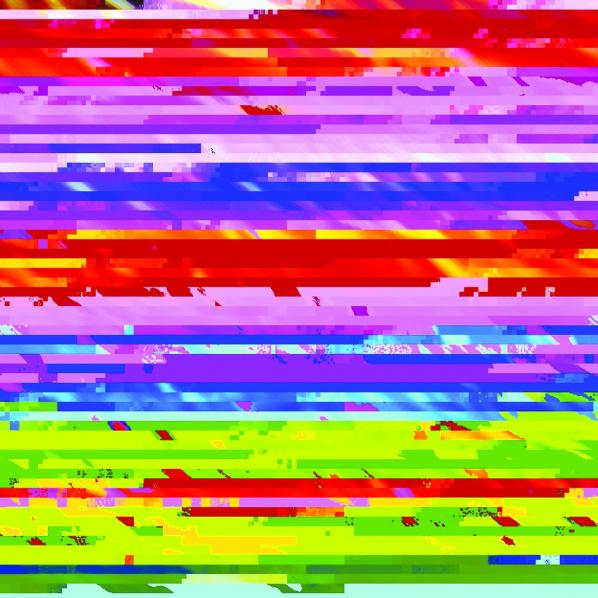
The website restoration therefore takes hold of the website’s programming in the 2010’s, but reinvents it with ingenuity. It also alerts the Internet user on how some multinationals IT companies (Apple, Google) consider the universality of the net: Chrome hinders some images display, while Safari denies their visualization. Also, in the latter case, Perconte and Choi have provided the following message to the attention of the user: “Safari is not ready for love. It’s still blind.” On the contrary, the Firefox browser, developed by a global open-source community, allows optimal operation of I Love You at the exact replica of the first 2004 version. Indeed, Mozilla defends a free Internet that would be “a global public resource that must remain open and accessible” in which “everyone should be able to shape the Internet and their own experiences on the Internet.”[13] That is why the growing love of I Love You does not only symbolize the artist in his couple, but elevates itself to a principle of universal union and intimate communion through the web: a set of values that affirm a convivial conception of society resisting consumerist models imposed by technical industries, and taking the power of the Web back in the hands of all users.
I Love You is therefore crucial for the Internet user, the historian, the media theorist, the film analyst, the archivist and the curator of the twenty-first century. It invents a thought of the program as a plasticity fertilization tool through digital visualization technologies understood as open and unstable. It successfully manages to offer bright and virtuoso processes and techniques of recoding, exciting insights on the operation of some display supports and devices, along with their history and unrelenting criticism, and the refined and infinite visual writing of the story of a man in love through a limitless range of radical visual forms generating a pure aesthetic delight. It is an artwork that lives and grows thanks to the Internet users as a digital lining of a relationship blossoming in the world, and which, since it has adapted and transformed to the changing technological environment, becomes the figurehead of a libertarian conception of the Internet and digital technologies in general.
Warmest thanks to Nicole Brenez, Gaëlle Cintré, Kamilia Kard,
Filippo Lorenzin, Zachary Parris,
Jacques Perconte and Isabelle Silvagnoli.
(In)exactitude in Science : http://inexactitudeinscience.com
and I Love You : http://iloveyou.38degres.net
Text is translated from the first french extended edition : http://www.debordements.fr/spip.php?article431